
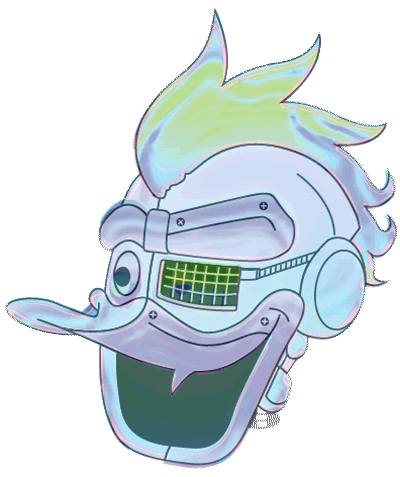

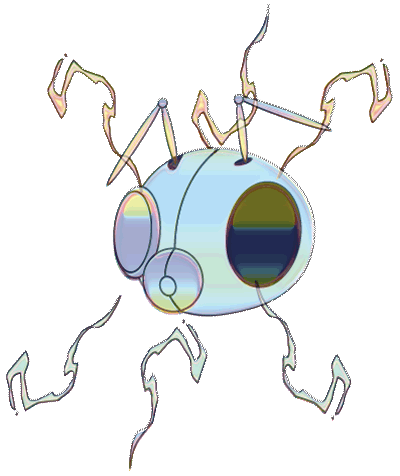
Opening Event: Seeds Underground Party – Sat 31 August, 2-5pm
Contact: info@furtherfield.org
Visiting Information
ABOUT THE EXHIBITION
ABOUT THE ARTWORKS
ABOUT THE ARTISTS
EVENT: SEEDS UNDERGROUND PARTY
TALK: SHU LEA CHEANG – ART, QUEER TECHNOLOGIES AND SOCIAL INTERFERENCE
LOCATION
SEE IMAGES FROM THE PRIVATE VIEW
WATCH VIDEO OF THE OPENING
This exhibition by Mark Amerika (US) and Shu Lea Cheang (US/FR) at Furtherfield Gallery marks a significant moment for contemporary art. Amerika and Cheang are both ‘net native’ artists. They share many of the obsessions of the growing multitude of artists who have grown up with the net since the early 1990s.
They are also big “names” – internationally established artists who regularly show their work, to critical acclaim, at contemporary art galleries around the world. They have crossed over into the mainstream art world whilst maintaining a critical edge.
Amerika is a media artist, novelist, and theorist of Internet and remix culture, named a “Time Magazine 100 Innovator” in their continuing series of features on the most influential artists, scientists, entertainers and philosophers into the 21st Century.
Cheang is a multimedia artist who works with net-based installation, social interface and film production. She has been a member of the Paper Tiger Television collective since 1981 and BRANDON, a project exploring issues of gender fusion and techno-body, was an early web-based artwork commissioned by the Guggenheim Museum (NY) in 1998.
Both artists continue to shape and be shaped by contemporary networked media art cultures of remix, glitch, social and environmental encounters.
Shu Lea Cheang and Mark Amerika at Furtherfield Gallery provides a physical interface in a local setting in the heart of a North London park to the thriving, international, networked art scene.
The exhibition features Cheang’s UKI viral love installation and Composting the Net. These are shown alongside pieces from The Museum of Glitch Aesthetics (MOGA), Amerika’s latest work in his collaborative series of transmedia narratives.
The exhibition features large stills from two performance installations. UKI viral love is the sequel to Cheang’s acclaimed cyberpunk movie I.K.U. (premiered at Sundance Film Festival, 2000) conceived in two parts – a viral performance and a viral game. The story is about coders dispatched by the Internet porn enterprise, GENOM Corp, to collect human orgasm data for mobile phone plug-ins and consumption. In a post-net crash era they become data deprived and these coders are suddenly dumped into an e-trashscape environment where coders, twitters, networkers are forced to scavenge from techno-waste.
![UKI – Trash Mistress [Radíe Manssour] (2009) by Shu Lea Cheang – Photo by Rocio Campana](http://www.furtherfield.org/wp-content/uploads/2013/05/radie.jpg)
In 2009, Cheang moved into the art studio at Barcelona’s Hangar medialab with 4 tons of E-trash, collected in Barcelona’s city recycling plant in one day. Amidst the rubble of wires, cables, boards, keyboards and computers, along with the coders and the hackers, UKI the defunct replicants are part of the e-trashscape seeking parts and codes to resurrect themselves.
UKI viral love is developed with collaborations and residencies at HangarBCN [artistas residentes] (Barcelona, Spain), Medialab Prado [Playlab] & [Desvisulizar] (Madrid, Spain) and, LABoral Centro de Arte y Creación Industrial [Plataforma Cero] (Gijón, Spain). The work presented at Furtherfield Gallery is the first physical installation of UKI in a gallery setting.
Composting the Net sources Internet net cultures’ accumulated data. It appropriates open (un)moderated mailing list communities, used for collaboration, sharing information and dialogue, and reprocesses the information into a virtual compost. For this exhibition Cheang composts the Spectre mailing list, a channel for practical information and exchange for media art and culture in “Deep Europe”, initiated in August 2001. The abundant info-data is reused and given extra life – an artistic legacy beyond its original purpose. It is also a celebration of the independent spirit of net culture that exists outside of corporate dominated Web 2.0 platforms such as Facebook.
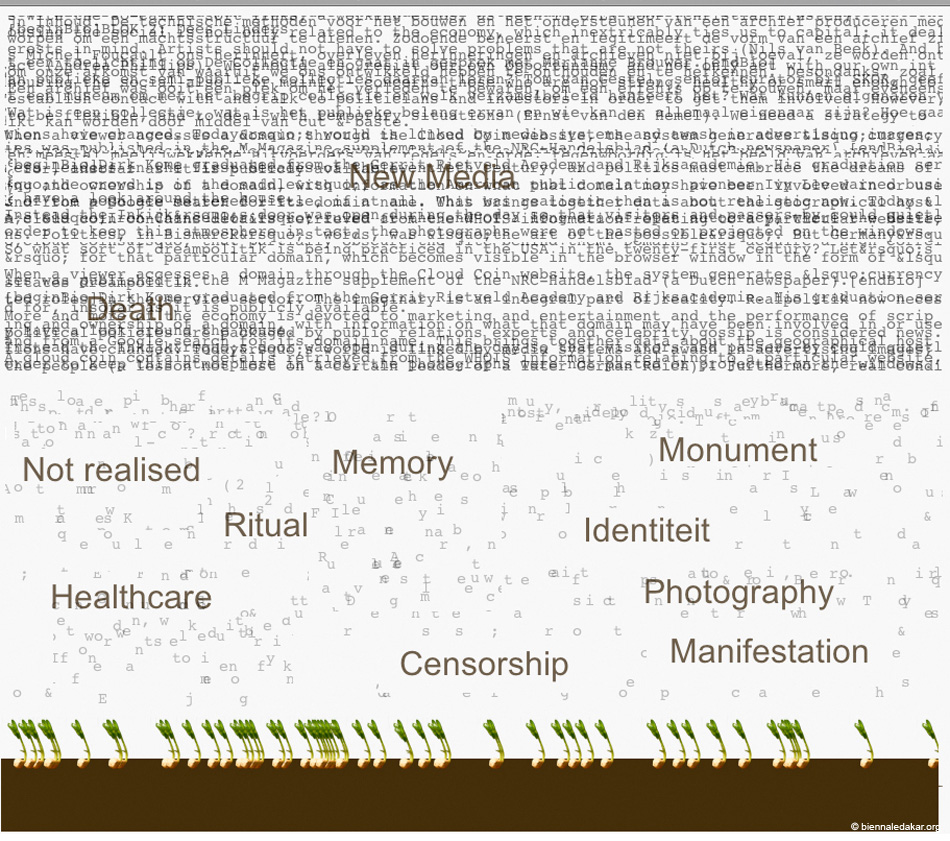
Amerika’s The Museum of Glitch Aesthetics (MOGA) features the work of The Artist 2.0, an online persona whose personal mythology and body of digital artworks are rapidly being canonized into the annals of art history. The narrative traces the life of the artist and his ongoing commitment to a practice of ‘glitch aesthetics’. MOGA features a wide array of artworks intentionally corrupted by technological processes, including net art, digital video art, digitally manipulated still images, game design, stand-up comedy, sound art, and electronic literature.
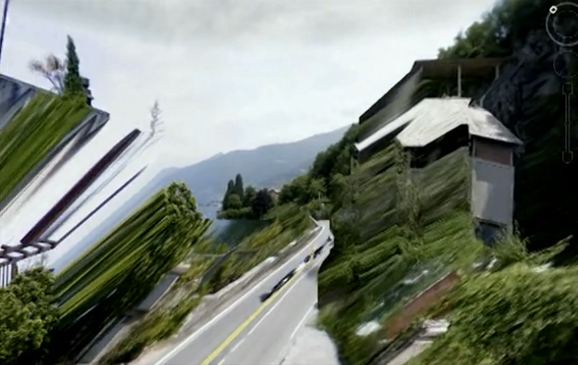
Featured in the Furtherfield Gallery exhibition are three works from the MOGA series: Lake Como Remix, The Comedy of Errors and 8-Bit Heaven.
Museum of Glitch Aesthetics was commissioned by Abandon Normal Devices for the 2012 AND Festival.

In conjunction with Shu Lea Cheang and Mark Amerika exhibition opening, Furtherfield is pleased to host Shu Lea Cheang’s Seeds Underground Party on Saturday 31 August, 2-5pm. Join us for a seed exchange party where packets of seeds change hands and go underground in the fields around Finsbury Park.
+ More information about the Seeds Underground Party.
To coincide with the exhibition, on Monday 02 September The White Building hosts a special talk by Shu Lea Cheang who will be in conversation with curator and writer Omar Kholeif.
+ More information about the Event.
Mark Amerika
Mark Amerika’s work has been exhibited internationally at venues such as the Whitney Biennial of American Art, the Denver Art Museum, the Institute of Contemporary Arts in London, and the Walker Art Center. In 2009-2010, The National Museum of Contemporary Art in Athens, Greece, hosted Amerika’s comprehensive retrospective exhibition entitled UNREALTIME. He is the author of many books including remixthebook (University of Minnesota Press, 2011) and his collection of artist writings entitled META/DATA: A Digital Poetics (The MIT Press, 2007). Amerika is a Professor of Art and Art History at the University of Colorado at Boulder and Principal Research Fellow in the Faculty of Humanities and Social Science at La Trobe University.
Shu Lea Cheang
As an artist, conceptualist, filmmaker, networker, Shu Lea Cheang (USA/France) constructs networked installation and multi-player performance in participatory impromptu mode. She drafts sci-fi narratives in her film scenario and artwork imagination. She builds social interface and open network that permits public participation. Engaged in media activism with transgressive plots for two decades (the 80s and 90s) in New York City, Cheang concluded her NYC period with the first Guggenheim Museum web art commission/collection BRANDON (1998-1999). Cheang has expanded her cross-genre-gender borderhack performative works since relocating in Eurozone in 2000. Currently situated in post-net BioNet zone, Cheang is composting the city, the net while mutating virus and hosting seeds underground parties.
Furtherfield Gallery
McKenzie Pavilion, Finsbury Park
London N4 2NQ
T: +44 (0)20 8802 2827
E: info@furtherfield.org
Furtherfield Gallery is supported by Haringey Council and Arts Council England.
This exhibition is sponsored by Rowans Tenpin Bowl, Carroll/Fletcher and Arts Catalyst.
Featured image: A random Geocities homepage, last updated sometime around 1997
Daniel Rourke visits the Photographers’ Gallery in central London and reviews their latest exhibit One Terabyte of Kilobyte Age by artists Olia Lialina and Dragan Espenschied, on THE WALL. Over an eight week period (18 April – 17 June 2013) they feature a non-stop stream of video captures of what they term as the lost city and its archival ruins. A documentation of a past visual culture of the web and the creativity of its users with new pages changing every 5 minutes. The project provides a glimpse into web publishing when users were in charge of design and narration in contrast to the automated templates of Facebook, YouTube and Flickr.
Sifting through a dormant internet message board, or stumbling, awestruck, on a kippleised [1] html homepage, its GIF constellations still twinkling many years after the owner has abandoned them, is an encounter with the living, breathing World Wide Web. At such moments we are led, so argues Marisa Olson, ‘to consider the relationship between taxonomy à la the stuffed-pet metaphor and taxonomy à la the digital archive.’ [2] How such descript images, contrived jumbles of memory and experience, could once have felt so essential to the person who collated them, yet now seem so indecipherable, stagnant, even – dare we admit it – insane to anyone but the most hardened retro-web enthusiast.
On show at London’s Photographers gallery until June 17th is an extensive archival exhibit designed to manage, reveal and keep these experiences alive. One Terabyte Of Kilobyte Age (1tb) is the fifth work to be commissioned for the Photographer Gallery’s ‘The Wall’, curated by two artists long associated with the era of the web the exhibition reveres: Olia Lialina and Dragan Espenschied. Perhaps best known for their book Digital Folklore (2009) the artists and retro-web evangelists have, with the 1tb project, strengthened their status as archivists, an impulse Hal Foster famously argued ‘concerned less with absolute origins than with obscure traces’ [3]. In the same year that Dragan and Olia launched their guide to the folk web, Yahoo! announced they were to close one of its greatest sources of inspiration: Geocities. A vast expanse of personal webpages, many of which had long since slid into html decrepitude, represented for Yahoo! little but financial embarrassment. So ancient and outmoded was Geocities that many contemporary browsers were incapable of capturing its essence, fragmenting images and link rolls randomly across modern laptop screens in an attempt to render their 800×600 pixel aura. Scraping and downloading the terabyte or so of data that made up the Geocities universe was thought important enough by some that a taskforce was put together, made up of technical wizards and wizardesses driven by the profound notion that all existent culture is worth saving. From Olia and Dragan’s webpage:
In between the announcement and the official date of death a group of people calling themselves Archive Team — managed to rescue almost a terabyte of Geocities pages. On the 26th of October 2010, the first anniversary of this Digital Holocaust, the Archive Team started to seed geocities.archiveteam.torrent.
Olia and Dragan’s gesture, to feed the wealth of culture contained in that torrent back to the masses in a palatable form, is a project whose fruition at the Photographer’s Gallery is but a minor part. After downloading, storing and sorting the 16,000 archived Geocities sites the task of exactly how to display them is a problem. Since most browsers would mangle the look and feel of the Geocities pages Olia and Dragan have turned to two main methods of re-representation. The first, let loose on an automated Tumblr blog that updates over 70 times a day, is an ever growing series of front-page screen captures. In this form 1tb bends to the will of a contemporary web user who concerns themselves with likes, reposts and uplinks.
Reflecting on the Tumblr-archive of the torrent-archive of the Geocities-archive, Olia and Dragan’s site contemporary-home-computing highlights particular screen captures that have garnered the most reposts and likes from their Tumblr followers. The results say much for the humour that still drives online culture, but perhaps little about the original contexts from whence those screen captures came. For instance, the screen captures that garner most attention are usually the ones that have failed a part of the retrieval/display/capture process. These ‘obscure traces’ may be GIF heavy sites, half loaded to interesting aesthetic affect, or, perhaps the most telling, captures that show nothing but the empty shell of a Netscape Navigator browser, caught forever like a millennium bug in digital amber.
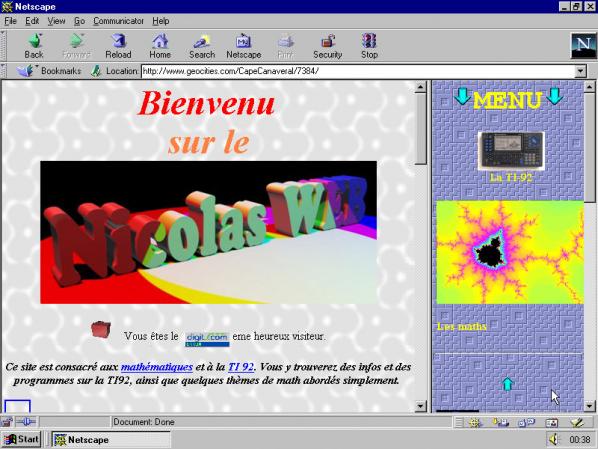
The second mode of capture and re-display takes place at the Photographer’s Gallery itself. Depicted on nine large intersecting HD video screens set into ‘The Wall’ of the entrance-cum-café, one’s first experience of the exhibit is ponderous. The display cycles through the vast array of Geocities homepages at five minute intervals, giving viewers a more than generous dose of 800×600 px nostalgia. Whether the websites that fade into view are a barrage of animated GIFs,insightful commentary on life in the late 1990s, or a series of barren ‘Under Construction’ assemblages, is up to chance.
As a reviewer, sent to derive something from the gallery experience, the wall leered at me with gestures that sent my inner taxonomist into a frenzy. Confronted with such tiny slithers of the archive, in such massive doses, it quickly becomes obvious that the real potential of the project has not been quite realised. Rather than static screen captures The Wall shows cleverly rendered quicktime videos, allowing the GIF whiskers of a Hello Kitty mascot to quiver once more. If you are lucky, or have the patience to watch a long series of the sites fade into view, you’ll be greeted by flickering ‘Welcome’ banners, by cartoon workmen tirelessly drilling, by unicorns cantering and sitemeter bars flashing. But The Wall also feels wholly at odds with its content, caught up in a whirl of web nostalgia that minimises the lives, experiences and aesthetic choices of a defining generation to static flashes that you can’t click on, no matter how much you want to. Archives are living, breathing entities wont to be probed for new meanings and interpretations. Whether depicted as static or faux animated, One Terabyte Of Kilobyte Age is a project with an endless surface, with little way for its viewers to delve deeper.
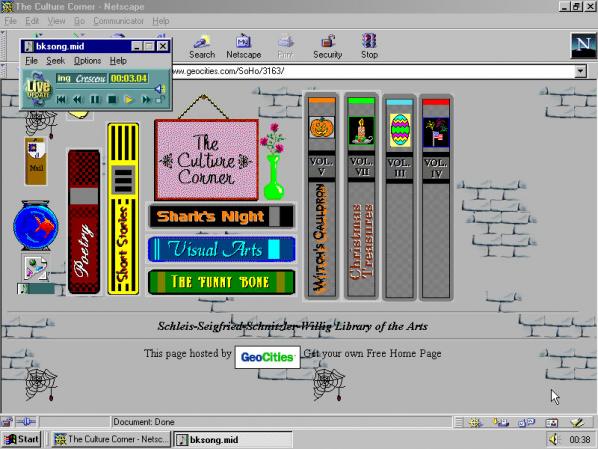
Trawling through the 1tb Tumblr is a much more visceral experience than the one that greets you at the Photographer’s Gallery, but the sense of a journey waiting to be embarked on is lost somewhat in the move to the Tumblr kingdom. Every five minutes offers a new chance to spot similarities on The Wall, to ponder on the origins of a site or, more profoundly, wonder where the people that toiled to make them are now. Before the days of user driven content, of Facebook timelines, and even before RSS feed aggregators, the whole web felt something like this. Today’s web is unarguably more dynamic, with a clean aesthetic that barely shifts behind the waves of content that wash over its surface. But the user has been relegated to shuffler of material.
The Geocities homepage was designed, and kept updated by an army of amateur enthusiasts, organising bandwidth light GIFs in ever more meaningful arrays, in the unlikely event that another living soul would stumble upon them. There is much to love about One Terabyte Of Kilobyte Age, and much to be learned from it given the time. But part of me wishes that the Photographer’s Gallery had given over their trendy café to a row of beige Intel 486 computer stacks, their unwieldy tube monitors better capturing the spirit of the web alá 1996. The clash between the 90s amateur enthusiast and the avid content shuffler of the 2010s is inherent in the modes of display Olia and Dragan chose for their project. Beginning from a desire to save and reflect on our shared heritage, 1tb now represents itself as pure content. An impulse to probe the archive replaced by an impulse to scroll endlessly through Tumblr streams, clicking like buttons on screen captures we hope will distract/impress/outrage our friends until the next cat video refreshes into view.
Go, go to the Photographer’s Gallery tomorrow, grab yourself a coffee and let the Geocities archive wash over you. If you can do it without Instagramming a snap to your friends, without updating your Facebook page with tales of your nostalgic reverie, if you can let the flickering screen captures do their own talking , only then can you claim you truly re-entered the kilobyte age.
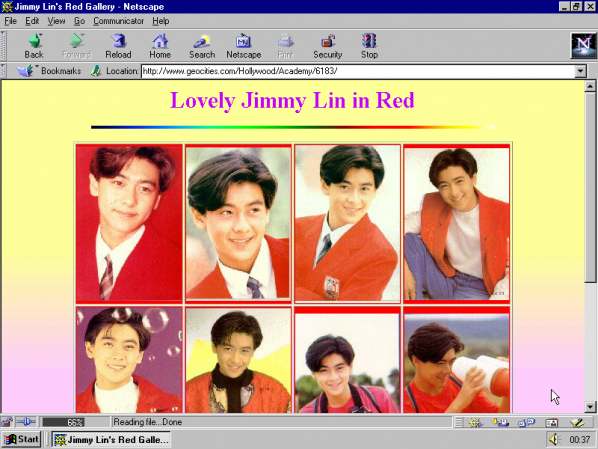
Erica Scourti’s work addresses the mediation of personal and collective experience through language and technology in the net-worked regime of contemporary culture. Using autobiographical source material, as well as found text collected from the internet displaced into social space, her work explores communication, and particularly the mediated intimacy engendered by a digital paradigm.
The variable status and job of the artist is humorously fore-grounded in her work, assuming alternating between the role activist, ‘always-on’ freelancer, healer of social bonds and a self-obsessed documenter of quotidian experience.
Millions are blissfully unaware of the technological forces at work behind the scenes when we use social network platforms, mobile phones and search engines. The Web is bulging with information. What lies behind the content of the systems we use everyday are algorithms, designed to mine and sort through all the influx of diverse data. The byproduct of this mass online activity is described by marketing companies as data exhaust and seen as a deluge of passively produced data. All kinds of groups have vested interests in the collection and analysis of the this data quietly collected while users pursue their online activities and interests; with companies wanting to gain more insight into our web behaviours so that they can sell more products, government agencies observing attitudes around austerity cuts, and carrying out anti-terrorism surveillance.
Felix Stalder and Konrad Becker, editors of Deep Search: The Politics of Search Beyond Google,[1] ask whether our autonomies are at risk as we constantly adapt and tailor our interactions to the demands of surveillance and manipulation through social sorting. We consciously and unconsciously collide with the algorithm as it affects every field of human endeavour. Deep Search illuminates the politics and power play that surround the development and use of search engines.
But, what can we learn from other explorers and their own real-life adventures in a world where a battle of consciousness between human and machine is fought out daily?
Artist Erica Scourti spent months of her life in this hazy twilight zone. I was intrigued to know more about her strange adventure and the chronicling of a life within the ad-triggering keywords of the “free” Internet marketing economy.
Marc Garrett: In March 2012, you began the long Internet based, networked art project called Life in AdWords, in which you wrote and emailed a daily diary to your Gmail account and performed regular webcams where you read out to the video lists suggested keywords. These links as you say are “clusters of relevant ads, making visible the way we and our personal information are the product in the ‘free’ Internet economy.”
Firstly, what were the reasons behind what seems to be a very demanding project?
Erica Scourti: Simply put, I wanted to make visible in a literal and banal way how algorithms are being deployed by Google to translate our personal information – in this case, the private correspondence of email content – into consumer profiles, which advertisers pay to access. It’s pretty widespread knowledge by now that this data ends up refining the profile marketers have of us, hence being able to target us more effectively and efficiently; just as in Carlotta Schoolman and Richard Serra’s 1973 video TV Delivers People,[2] which argues that the function of TV is to deliver viewers to advertisers, we could say the same about at least parts of the internet; we are the commodities delivered to the advertisers, which keep the Web 2.0 economy ‘free’. The self as commodity is foregrounded in this project, a notion eerily echoed by the authors who coined the term ‘experience economy’, who are now promoting the idea of the transformation economy in which, as they gleefully state, “the customer is the product!”, whose essential desire is to be changed. The notion of transformation and self-betterment, and how it relates to female experience especially within our networked paradigm is something I’m really interested in.
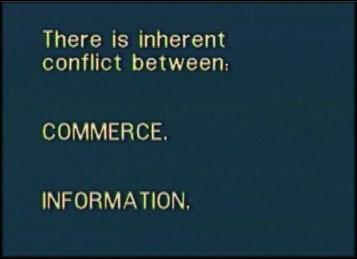
As Eli Pariser has pointed out with his notion of filter bubbles, the increasingly personalised web employs algorithms to invisibly edit what we see, so that our Google searches and Facebook news feeds reflect back what we are already interested in, creating a kind of solipsistic feedback loop. Life in AdWords plays on this solipsism, since it’s based on me talking to myself (writing a diary), then emailing it to myself and then repeating to the mirror-like webcam a Gmail version of me. This mirror-fascination also implies a highly narcissistic aspect, which echoes the preoccupation with self-performance that the social media stage seems to engender; but narcissism is also one of the accusations often leveled at women’s mediated self-presentation in particular, despite, as Sarah Gram notes in a great piece on the selfie, [3] it being nothing less than what capital requires of them.
![Girl with a Pearl Earring and a Silver Camera. Digital mashup after Johannes Vermeer, attributed to Mitchell Grafton. c.2012. [4]](http://www.furtherfield.org/wp-content/uploads/2013/05/vermeer_selfie.jpg)
And as this project is a form of autobiography and diary-writing, it could also be seen as both narcissistic and as asserting the importance of personal experience and emotions in the construction of a humanist, unified subject. Instead, I wanted to experiment with a way of writing a life story that operated somewhere between software and self, so that, as Donna Harraway says “it is not clear who makes and who is made in the relation between human and machine”. Part of the humour of the project arises from the dissonance between the staged realism of the webcam (and my real cat/ hangover/ bad hair) with the syntactically awkward, machinic language, which undermines any notion that this diary is the expression of any authentic subject.
The demanding aspect of it is something I was interested in too, since it calls up the notion of endurance as a virtue, and therefore as a value-enhancer, which many artworks – from mind-boggingly labour intensive supercut-style videos to sculptures made from millions of pins (or whatever) – trade on. You just can’t help but ask ‘wow…how long did that take?!’ – as if the time, labour and effort, i.e. the endurance, necessarily confer value. So there is a parallel between a certain kind of ‘age of austerity’ rhetoric that valorises resilience and endurance and artworks that trade on a similar kind of doggedness – like Life in AdWords does.
And finally – it made me laugh. Some of the text was so dumb, and funny, it amused me to think of these algorithms dutifully labouring away to come up with key-phrases like ‘Yo Mamma jokes’ and ‘weird pants’.
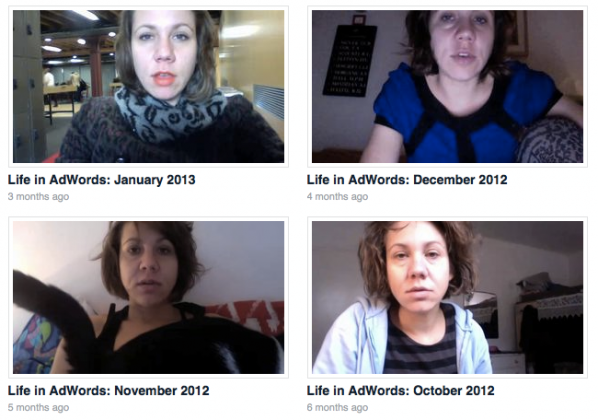
MG: It ran until 20th January 2013, and ended due to system changes in the Gmail ad settings. How many videos did you produce and were you glad when it all had finally ended?
ES: Not sure how many I made – but I was 6 weeks short of the intended year, so definitely over 300. Actually I was infuriated and somewhat depressed when it ended without warning and in a moment of panic I even thought about somehow cheating it out to the end; but working with a system that is beyond your control (i.e. Google) necessarily involves handing over some of your authorial agency. So instead I embraced the unexpected ending and threw a kind of send-off party plus performance in my bedroom/ studio to mark it.
But this question of agency is obviously crucial in the discussion of technology and runs through the project in various ways, beyond its unintended termination. At the level of the overall structure, it involves following a simple instruction (to write and process the diaries every day and do the webcam recording) which could be seen as the enactment of a procedure that echoes the operation of a software program carrying out automated scripts. And on the level of the texts, while all the language used in the project was generated and created by the software, I also was exercising a certain amount of control over which sections of the diary I favoured and editing the resulting lists, a move which seemingly reasserts my own authorial agency.
Thus the texts are more composed and manipulated than they first appear, but of course the viewer has no way of knowing what was edited out and why; they have to take it on faith that the texts they hear are the ‘real’ ones for that diary.
MG: During this period you recorded daily interactions of the ongoing experience onto webcam. As you went through the process of viewing the constant Google algorithms, I am wondering what kind of effect it had on your state of mind as you directly experienced thousands of different brands being promoted whilst handing over the content once again, verbally to the live camera?
ES: I’m not sure what effect it had on my state of mind, though considering the amount of concerned friends that got in touch after viewing the videos, Google certainly thought I was mostly stressed, anxious and depressed. Maybe it’s just easier to market things to a negative mind state.
But also, the recurrence of these terms was no coincidence; early film theorist Tom Gunning has argued that Charlie Chaplin’s bodily movement in Modern Times [5] ‘makes it clear that the modern body is one subject to nervous breakdown when the efficiency demanded of it fails,’ and compares his jerky, mechanical gestures with the machines of his era.
So I was interested in if and how you could do something similar for the contemporary body; how can we envisage it and its efficiency failures in relation to the technology of today when our machines are opaque and unreadable, if we can see them at all. Maybe what they ‘look like’ is code (a type of language), so it would entail some kind of breakdown communicated through language rather than bodily gestures – though the deadpan delivery certainly evokes a machinic ‘computer says no’ type of affectlessness.
Also, Franco Berardi has spoken of the super-speedy fatigued denizen of today’s infoworld, for whom “acceleration is the beginning of panic and panic is the beginning of depression”. In a sense this recurrent theme of stress and anxiety disavows the idea of the efficient, ever-ready, always-on subject of neo-liberalism – and yet the project as a whole kind of sneakily joins the club too, since it obeys the imperative of productivity by turning a diary (personal life, non-work) into a ‘project’ (i.e. work).
As mentioned earlier in terms of the ‘transformation economy’, I’m really interested in this idea of efficiency also as it manifests in rhetorics of self-betterment, and its relation to the neo-liberal promotion of self-responsibility (if you’re poor, it’s your fault….). Diaries and journal writing – as well as meditation, yoga, therapy, self-help etc – are often championed in everything from cognitive fitness to management literature as excellent ways of becoming more ‘efficient’. The underlying belief seems to be that by unloading all the crap that weighs you down, from emotional blockages to unhelpful romantic attachments to an overly-busy mind, you’d get an ‘optimised you’. Why this is necessarily a good thing – apart from the elusive promise of ‘happiness’ of course – is never really discussed.
Tiqquun’s notion of the Young Girl, the model consumer-citizen, is interesting in this regard – taking good care of oneself reframed as a form of subservience which maintains the value and usefulness of our bodies and minds to capital. Their idea that the Young Girl (not actually a gendered concept in their estimation) “advances like a living engine, directed by, and directing herself toward the Spectacle” also points to the irony beneath what appears to be a very humanist/ individualist inflection to these discourses of self-realisation: they could also be read as a latent desire to become somehow more ‘machine-like’, as if we could therapise/ meditate/ journal/ jog away our mind-junk with the swiftness and ease of emptying the computer’s trash, thereby becoming more productive.
And yet I’m clearly complicit in this, as I write diaries, meditate, do yoga and obsess over my bad time management, as Life in AdWords makes clear both in the recurrence of all these activities in the texts and obviously in its structure as a daily journal project.
MG: Robert Jackson in his article Algorithms and Control discusses in his conclusion that even though “use of dominant representations to control and exploit the energies of a population is, of course, nothing new”, when masses of people respond and say yes to this “particular reduced/reductive version of reality”, as an act of investment it “is the first step in a loss of autonomy and an abdication of what I would posit is a human obligation to retain a higher degree of idiosyncratic self-developed world-view.” Alex Galloway also explores this issue in his book Protocol: How Control Exists after Decentralization, where he argues that the Internet is riddled with controls and that what Foucault termed as “political technologies” as well as his concepts around biopower and biopolitics are significant.
Life in AdWords, seems to express the above contexts with a personal approach on the matter. Drawing upon an artistic narrative as the audience views your gradual decline into boredom and feelings of banality. The viewer can relate to these conditions and perhaps ask themselves similar questions as they go through the similar experiences. Thus, through performance and a play on personal sacrifice on a human level, it elucidates the frustrations on the constant, noise and domination of these protocols and algorithms and how they may effect our behaviours.
With this in mind, what have you learnt from your own experience, and how do you see others regaining some form of conscious independence from this state of sublimation?
ES: I found Galloways’ explanation of Foucault’s notions of biopower to be some of the most interesting parts of that book – as he puts it “demographics and user statistics are more important than real names and real identities”, so it’s not ‘you’ according to your Amazon purchase history, but more ‘you’ according to Amazon’s ‘suggestions’ (often scarily accurate in my experience). Which is where the algorithms come in; they do the number-crunching to be able to predict what you might buy, and hence who you are, not because anyone cares about you particularly, but because where you fit in a demographic (a person who is interested in art, technology, etc..) is useful information and creates new possibilities for control.
Regaining conscious independence… hmm. I found it interesting that during the project, the people I explained it to would often report back to me on what keywords their emails had produced, and what adverts came up on Facebook, as they hadn’t really noticed before – so perhaps in these cases it made people more conscious of the exchange taking place in the ‘free’ web economy. Others took up AdBlocker in response, which is one way of gaining distance – by opting out. However, the info each of us generates is still useful, since even if you aren’t seeing the ads, your choices and interactions are still being parsed and thus help delineate a particular user group of citizen-consumers.
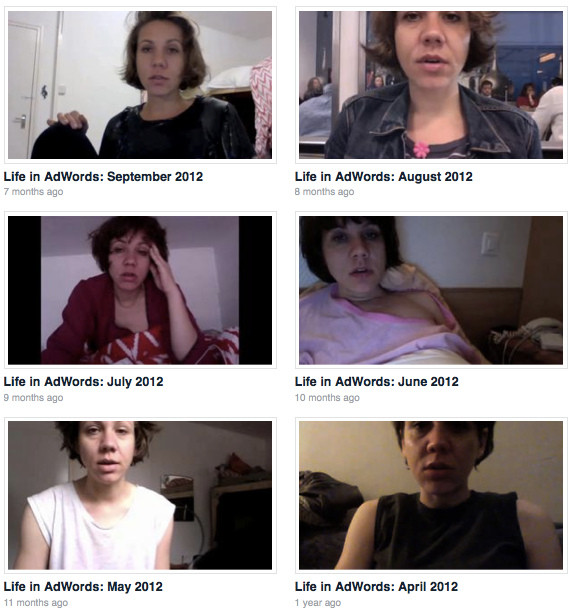
Despite this, my feeling is that opting out – if it’s even possible – can be a way of pretending none of this stuff is happening. I’m generally more interested in finding ways of working with the logic of the system, in this case the use of algorithms to sell things back to us, and making it overly obvious or visible. Geert Lovink asked whether its possible for artists to adopt an “amoral position and see control as an environment one can navigate through instead of merely condemn it as a tool in the hands of authorities” and his suggestion of using Google to do the ‘work’ of dissemination for you, in spreading your meme/ word/ image, is one I’ve thought about, particularly in other works (especially Woman Nature Alone). This approach entails hijacking the process by which Google’s algorithms organise the hierarchy of visibility to one’s own ends – a ‘natural language’ hack, as Lovink puts it.
In contrast, Life in AdWords makes visible the working of the algorithmic system more on the level of the language it produces. It also employs humour, and laughter has been one of the main responses people have had when watching the videos, for a number of reasons. The frequent dumbness of the language and/ or the juxtapositions (‘Where is God?’, ‘Eating Disorder Program’); the flattening out of all difference between objects/ feelings/ places (e.g. work-related stress, cat food, God, Krakow); and the lack of shame the software exhibits in enumerating bodily and mental malfunctions (blood in poop, wet bed, fear of vomiting) are all quite amusing in and of themselves.
That shameless aspect also echoes the over-sharing and ‘too much information’ tendencies the web (especially social media) seems to encourage, which Rob Horning has written about in his excellent blog, Marginal Utility. It also foregrounds that whatever the algorithms can do, what they still can’t do is emulate the codes of behaviour governing human interaction – including knowing when to shut up about your ‘issues’.
The frequent allusions to these bodily and mental blockages also point to the limits of the productivity imperative – a refusal to perform enacted through minor breakdowns – while bringing it back to an embodied subject, who despite her immersion in networked space is still a body with messy, inefficient feelings, needs and urges. And the comically limited portrait the keywords paint maybe suggests that despite the best efforts of Web 2.0 companies, we still are not quite reducible to a list of consumer preferences and lifestyles.
MG: What are you up to at the monment?
ES: Amongst other things I’m doing a residency with Field Broadcast (artists Rebecca Birch and Rob Smith) called Domestic Pursuits, a project which ‘considers the domestic contexts of broadcast reception and the infrastructure that enables its transmission.’
And I’m working on some drawings plus a video involving Skype meditation with members of the Insight Timer meditation app community, for A Small Hiccup, curated by George Vasey and opening 24th May at Grand Union, Birmingham- the video is being shown online tommorrow.
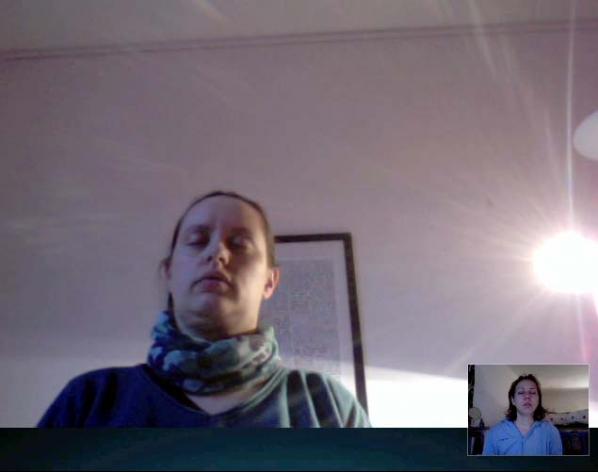
Also I’m attempting and mostly failing at the moment to write my dissertation for the MRes in Moving Image Art I’m doing at Central St Martins and LUX.
Personal Web searching in the age of semantic capitalism: Diagnosing the mechanisms of personalisation. Martin Feuz, Matthew Fuller, and Felix Stalder.
http://firstmonday.org/article/view/3344/2766
Live Performance. KONRAD BECKER (aka Monoton) featuring SELA 3 themes from “OPERATIONS” (15 min.). Published on Jul 9, 2012. YouTube.
http://www.youtube.com/watch?v=HMscYTAF4wY
Erica Scourti was born in Athens, Greece in 1980 and now lives in London. After a year studying Chemistry at UCL, an art and fashion foundation and a year of Fine Art Textiles at Goldsmiths, she completed her BA in Fine Art at Middlesex University in 2003 and is currently enrolled on a Research degree (Masters) in Moving Image Art at Central Saint Martin’s College of Art & Design, run in conjunction with LUX. Her area of research is the figure of the female fool in performative video works.
She works with video, drawing and text, and her work has been screened internationally at museums like the Museo Reine Sofia, Kunstmuseum Bonn and Jeu de Paume Museum, as well as festivals such as the Recontres Internationales, interfilm Berlin, ZEBRA Film Festival, Antimatter, Impakt, MediaArt Friesland, 700IS as well as extensively in the UK, where she won Best Video at Radical Reels Film Competition; recent screenings include Video Salon Art Prize, Exeter Phoenix, Bureau Gallery, Tyneside Cinema and Sheffield Fringe Festival.
Her work has also been published in anthologies of moving image work like Best of Purescreen (vols 1, 2 and 3) and The Centre of Attention Biannual magazine.
more info – http://www.ericascourti.com/art_pages/biography.html
Some have proposed Jennifer Chan to be part of what has been termed as the post-internet era. But, this is an inadequate representation of the spirit, criticality and adventure at play in her work. Chan’s awareness and use of the Internet reflects a way of life, that situates its networks as a primary resource. Chan lives amongst various worlds and engages in different shades of being; a self-described ‘amateur cultural critic’, a net artist, a media artist, and academic. Her work exists both online and in physical realms, it is always present and contemporary. This is because her work lives in a world where the scripting of official art definitions loses its power. People have exploited technology to facilitate new behaviours where the artist or art amateur redefine what art is on their own terms. We are now in a post-art context. It reflects a very real, societal shift. Mainstream art culture no longer owns the consciousness of art, Chan and others like her are pulling it apart.
Marc Garrett: In your video Interpassivity a kind of docu-performance made for the exhibition REALCORE, you’re in a park spraying a brown cardboard box, silver. As you go through the process of walking around the box whilst spraying it, you comment on the object’s formal aspects. But, what you mainly discuss are your own personal views about contemporary art. It then becomes apparent that the box is a prop for the performance, enabling the subject to be explored.
Alongside your interpretations of the work my own thoughts on the subject feel as though they are included in the conversation. I know as a viewer, that the artist is not aware of my thoughts on the matter. However, it feels like there is space for me to be a part of the conversation. Not literally through a feedback system or interaction, but as an individual considering your personal questions. The artwork knows I am experiencing it, it knows that a consciousness out there is somehow engaging with its dialogue.
It is clear you are in tune with the feeling of dysfunction. You say, “I need to spit out some creative truth”. On hearing this, I was not sure whether this was a parady, irony or an expression of despair, or all these. You also say “contemporary art is removed from our everyday feelings”. As you express these words I begin the view the box as a symbol of contemporary art as a centralized, institutional monolith? So, before I unwittingly place my own meanings onto the work could you tell us what it means to you?
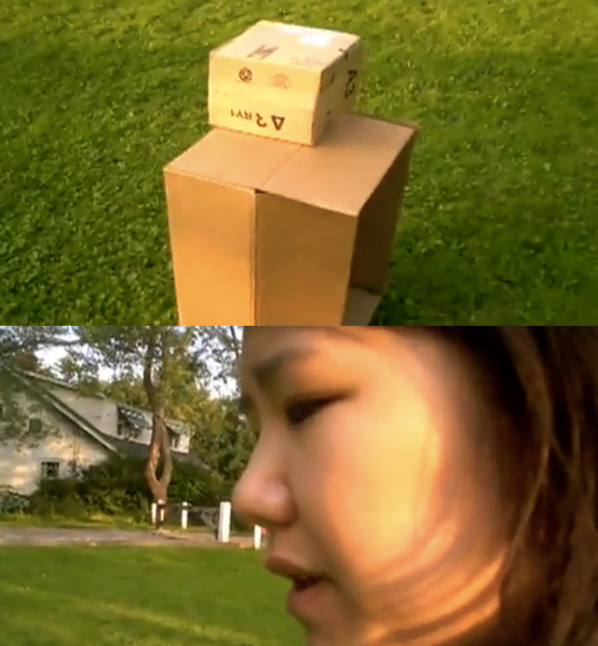
Jennifer Chan: Interpassivity is the instance of something cueing an audience to feel a certain way, such as canned laughter to stand in for humoured social reaction to jokes in a sitcom– even when it’s not funny. I titled it that because I felt like another art student trying to convince herself or the viewer what she made is art. I feel embarrassed about this self-aware but privileged complaining. A few people have found this work online and screened it, but I’m still mortified to watch it with them.
I made that video because I think a lot of contemporary art is sterile, mannered and removed from emotion. I wasn’t thinking of Donald Judd at that point but I could see the box standing in as a poor attempt at work, like his work. What I was working on (or seven years of art education) had little to do with what was happening in my life. (So to answer your question, yes, it is despair) Using my flipcam and talking over it was immediate for recording those ideas. It’s also a big trope of Canadian video art… a breathy voiceover conveys something serious and personal.
re: REALCORE. The title came about as a play on the idea of “real life”, or face-to-face life away from keyboard. Likewise, users would say “irl”(in real life), or “so real~” in Facebook comment threads to joke about the divide between online/offline contexts. The curator David Hanes felt the video was important to contextualize my use of sincerity and clichés, I was not being ironic in my intention. Arielle Gavin and Jaakko Pallasvuo thought it was questionably ironic and an emotive perspective on the Internet as a form of new sincerity.
I later found that someone wrote a paper by someone who coined “realcore” as a kind of amateur user-generated porn, which is a cool double-meaning. The “interpassivity” video was used to promote the show online but I showed my kitschy found footage videos on twisted pizza box plinths for the show. This was my fuck-you to geometric minimalism and boring white plinths, but I suppose it resulted in a different take of it…
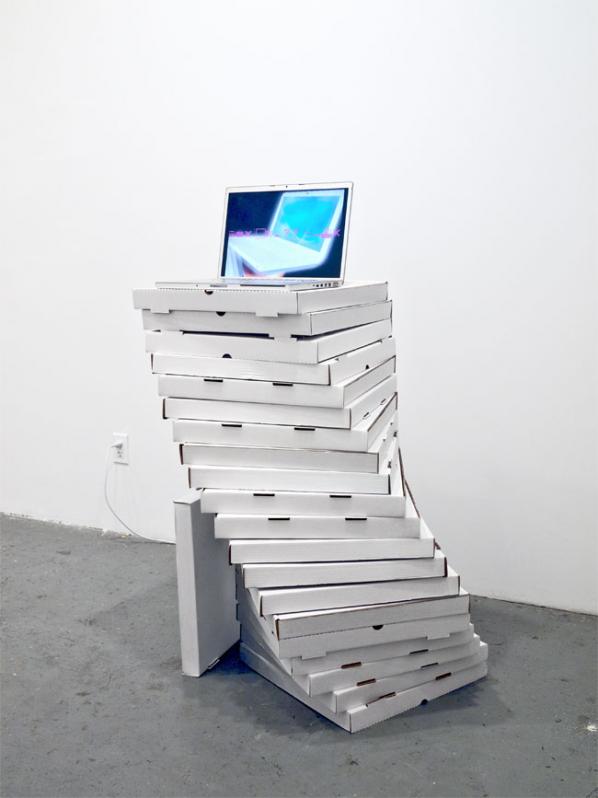
MG: In one of your recent videos “Grey Matter” when watching it felt like I was immediately pulled into a remixed world of teenage celebrity, products and brands, dripping in an orgasmic noise of techno-capitalism. Most of it is found footage, images, video and sound remixed into an edited compilation. Running through the video in between the high octane fuelled cuts and glitches, are messages to the Internet user who chances upon the video. These messages feel like they are from an individual voice but also of a multitude – caught up in a constant state of mediated folk hedonism.
What intentions lie behind this work as an artistic explorer of the entertainment culture you have remixed?
JC: Grey Matter is a first person account on feeling politically inactive online while having access to a wealth of information. I wanted to use remix in a confessional manner, so I combined obscure nostalgic media with embarrassing statements. The video begins with sped up footage of early 3D simulator ride called “Millennium Bug”. Y2K was the first technological “crisis” I recalled with clarity when I was growing up. The rest of the video includes cynical commentary on online spaces I’ve engaged with in the past year. (shopping on aliexpress.com and lurking people on OkCupid) “Little Prince” is compressed 25 times and sped up by 400%. I included old profile pics and some summary text from my OkCupid profile–I thought it was quite telling about how I wanted to be seen online and irl. I think it’s possible to feel mutually exclusive feelings at the same time, or maybe the experience of being active on different social networks produces a kind of schizophrenia. Collaging Internet pop culture is a way to appreciate it-as artifacts-in a complex light, and to be critical of it by acting out within its language.
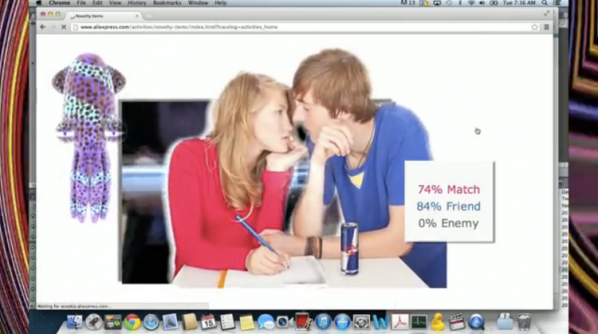
MG: What do you find fascinating about popular culture on the Internet?
JC: Anything minuscule has the potential to be popular amongst disparate users and they form vernaculars to talk about their interest in that. I find that desire relatable. That is what I think of as “community” online. It’s based on human interest and media fandom. Justin Bieber is made into something of a scapegoat for the first world’s shortcomings; people who like his image/music idolize him, and people who hate him are waiting for him to crack. Both are forms of fanaticism (one based on affinity; the other on hate-watching something.) Supercuts of Justin Bieber hairflips, object crushing fetishists, disease forums, long threads debating a detail…etc. I like the solipsism and intensity of all that.
MG: Can you share with us some of your critical insights and personal pleasures on this subject?
JC: Pop culture is paradoxical and audiences selectively enjoy it. (like teens dancing to hip hop with irreverence to its violent or sexist content.) Consuming and sampling pop allows people to indulge into its meanings, and through this there is a reconsideration of what “the masses” find important. Like the use of “users”, “masses” is what cultural studies calls everyone or everyone except-you. But every “user” has a specific relationship with interfaces and platforms, so they aren’t so homogenous.
Pop culture is also political. There was a time when more people voted for American Idol than the US elections, and if 10,000 people showed up to the 2012 cat video festival, entertainment is generally more seductive than current affairs–until there is a gatekeeping emergency (like mainstream media not covering the early days of Occupy). In terms of “internet pop culture”, perhaps traffic with social networking has overtaken porn and gambling online, but social news is also a kind of entertainment.

MG: Olia Lialina and Dragan Espenschied in their book Digital Folklore they celebrate everyday people’s use of personal computers with “glittering star backgrounds, photos of cute kittens and rainbow gradients”. They value the non-professionalism and amateur spirit that has come about from millions of people enjoying the Internet since it started. There is a difference now, the Internet masses have been shifted and prodded into large web 2.0 frameworks such as Facebook, and an abundance of personal web projects have been lost since.
And, like them do you find reassurance or a personal connection with the Internet Amateurs of the world?
JC: In context of new media art, it’s probably more accurate to think of amateurs as people who don’t self-identify as artists or technicians. What non-artists do with software and video appears facile, sincere, and intuitive. I make amateur-looking work to dialogue with that.. I like to say something dumb to say something serious. Something that’s made simplistically and filled with kitschy references can be packaged as critique that also appeals to non-art audiences.
I caught the tail end of the homepage-o-sphere/webring 1.0 period. Non-artists made personal websites out of a genuine interest in something. tumblr and pinterest is used in a same way today–to collect indiscriminately. Like 2.0 frameworks, the early internet also had free webpage hosting that users relied on (Geocities and Lycos). Personal website design isn’t over either; net artists still make them or bind together to create their own sites (like tightartists.com). I think I have an idea of what you mean though; it was less commercial and there weren’t as many distinct “most-visited” places online.
I made a lot of gothy dark art on DeviantArt before I knew about contemporary art, and my sensibility towards Photoshop was more romantic and impulsive without the baggage of art education. Maybe this “revival” cult of amateur-looking digital folklore happened because I/we exoticize that kind of amateur production. Web vernaculars have also become stylized and this aesthetic is shared with seapunks and filmmakers. Artists need to adapt to that.
MG: What do you feel is still alive and open for everyday online expression and play, in respect of what Lialina and Espenschied perceive as Digital Folklore?
JC: I think a lot of emerging artists have a greater awareness of obsolescence and upgrade culture than we give them credit for–while still complacent to the socialization structures on Facebook. Many seem more interested in navigating these networks to question their inner control mechanisms than overthrowing them or innovating new ones. It can be simple things like friending as many users as possible, looping webcam feeds, archiving and re-uploading banned content on different platforms, having an anonymous/alternate personas/using multiple accounts…etc. People like glitchr and Ian Aleksander Adams are always looking for ways to use a system against its intended functions in the same way jodi did all the cheat moves in max payne CHEATS ONLY. I admire glitch practices for that.
There’s also the possibility for re-appropriating anything to rebrand or critique particular communities. I think Angela Washko and Jaakko Pallasvuo are doing this in a compelling way that covers a large territory between art and Internet culture.
MG: So, what are you working on at the moment?
JC: <–for some reason this sounds less perverted than if I were an old guy doing this to teen girls but its really just as perverse–>
I’m observing what young adult/teen boys do on YouTube: bulking up, performing dares, talking about how to pick up a White/Asian girls etc. I’m also making a video about Asian guys (both diasporic, Asian American, and more specifically, Korean and Taiwanese men) and their interpretations of mediated masculinity. There is something disturbingly tantalizing in terms of how they have learned to look at the webcam as if they are boy band stars yet they are not fully grown men. A lot of this is informed by growing up in Hong Kong, and knowing that fashion and romance, is inspired by many “neighbouring” cultural media from Japan, Korea and Taiwan even though American/British influence is also prominent in the club scene.
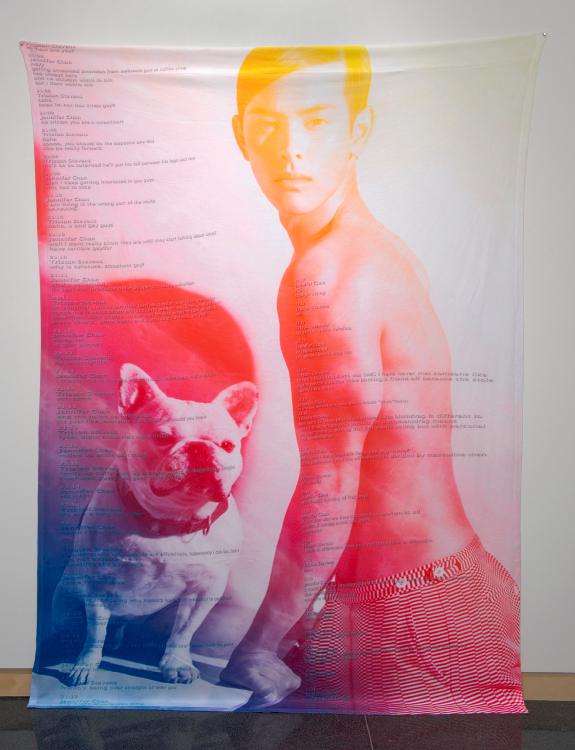
Here are two images from my late installation that will foreshadow this interest. It’s chat text over layered on modified fashion and makeup adverts targeted at Korean and Chinese men, and printed onto micro-fibred bedding. I feel like they’re treated as pleasant freak shows on tumblr but this imagery is a banal, idealized kind of masculinity in Asia. I think western facial features are really common amongst these popular images of Asian-ness, and most would tend to read it as aspiring to western culture, though the hyperfemme “doll” look or metro-masculinity has been a regional style since the 90s.
Chan’s work reflects an emerging condition described by Zizek as “interpassivity” in which our engagement with interactive experience has lost traction and is replaced with “its shadowy and much more uncanny supplement/double “interpassivity””[1], a “Fetish between structure and humanism”[ibid]. We are pulled into a paradox, where ‘interaction and passivity’ are joined together as spectacle of constant mediation. Millions have joined online centralized, megastructures such as Facebook, and this is not a black and white situation. Many are coerced from social and consumer pressures into the state of being seen as interacting. As the futuristic time machine streams onwards at high-speed, agency slouches into a spurious and distant dream. Others and the same are enjoying the flow for the sake of self expression within these scripted frameworks.
Chan’s work critiques, plays with, and exploits this networked, social intervention, as well as her viewers’ desires. Her imaginative palette revivifies questions about agency, passivity, sexuality, privacy, individuality, behaviour, networked consumption and its production. These remixed artworks have much material to work with, as the endless ether of everyday noise is uploaded and distributed through blogs and social networking sites; then returned into the ether as cut-ups where a transforming culture is engaged in its own mutation.
Its noise engages us whether we enjoy it or not, in the medium of “interpassivity”, and we all find ourselves caught within this spectacular enticement driven by the Netopticon. “On a holiday trip, it is quite common to feel a superego compulsion to enjoy, one “must have fun” — one feels guilty if one doesn’t enjoy it.”[ibid]
Jennifer Chan – http://www.jennifer-chan.com/
Heavy MetaVernacular video after the popularization of the internet
http://jennifer-chan.com/index.php?/curatorial/heavy-meta/
SELF-LOVE A non-consensual exhibition of emerging net art
http://jennifer-chan.com/index.php?/curatorial/self-love/
New Insularity Peer backpatting. A screening of works by friends and users whose works I admire.
http://jennifer-chan.com/newinsularity.html
Feeling VideoThe affective appeal of antisocial video
http://jennifer-chan.com/index.php?/curatorial/feeling-video/
Trivial Pursuits Distracting “new media art”
http://jennifer-chan.com/index.php?/curatorial/trivial-pursuits/
Curated by Rosa Menkman & Furtherfield.
Opening Event: Saturday 8 June 2013, 2-5pm
with Glitch Performance by Antonio Roberts at 3pm
Open Friday to Sunday 11-5pmContact: info@furtherfield.org
DOWNLOAD PRESS RELEASE
IMAGES OF THE OPENING ON FLICKR
READ Glitch as a Symbolic Art Form BY ROB MYERS
WATCH VIDEO OF THE OPENING
“The glitch makes the computer itself suddenly appear unconventionally deep, in contrast to the more banal, predictable surface-level behaviours of ‘normal’ machines and systems. In this way, glitches announce a crazy and dangerous kind of moment(um) instantiated and dictated by the machine itself.” Rosa Menkman [1]
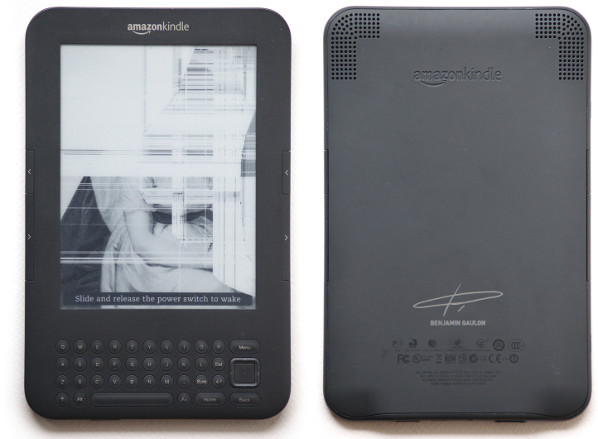
Glitches are commonly understood as malfunctions, bugs or sudden disruptions to the normal running of machine hardware and computer networks. Artists have been tweaking these technologies to deliberately produce glitches that generate new meanings and forms. The high-speed networks of creation and distribution across the Internet have provided the perfect compost to feed this international craze. The exhibition shows various approaches by artists hacking familiar hardware and their devices which include mobile phones, and kindles. They disrupt both the softwares and the digital artefacts produced by these softwares, whether it be in the form of video, sound and woven glitch textiles.
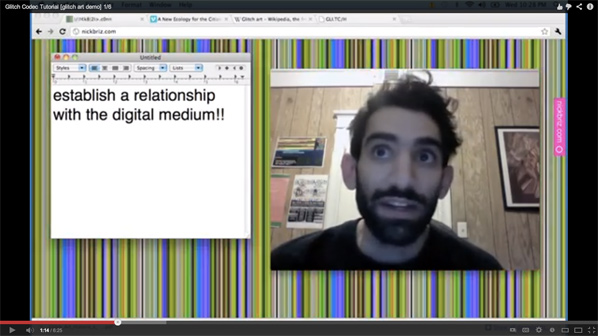
Glitch art subverts the way in which we are supposed to relate to technology, causing playful, imaginative disruptions. It is a low-tech and dirty media approach with a punk attitude. These artists appropriate the medium and forge expressions that go beyond what the mainstream art world expects artists to do, it is unstoppable – it is Glitch Moment/ums.
Copies of Rosa Menkman’s groundbreaking Glitch Art critique The Glitch Moment(um) will be available for purchase during the exhibition.
![numbermunchers from the untitled [screencaptures] series by Melissa Barron](http://www.furtherfield.org/wp-content/uploads/2013/04/melissabarton.jpg)
Empty Spinning Circle become Full (part b) (2012) from the Further Abstract series by Alma Alloro
One Square in colors (2012) from the Further Abstract series by Alma Alloro
untitled [screencaptures] (2010) by Melissa Barron
The Glitch Codec Tutorial by Nick Briz
KindleGlitched (2012) by Benjamin Gaulon
Thoreau Glitch Portrait (2011) by José Irion Neto
Copyright Atrophy (2013) by Antonio Roberts
What Revolution? (2011) by Antonio Roberts
Beyond Yes and No (2013) by Ant Scott
Glitch artists and enthusiasts are invited to add their work to GLI.TC/H 0p3nr3p0.net, a Glitch Art repository coded by and developed by Joseph ‘Yølk’ Chiocchi & Nick Briz. The submissions will be showcased during Glitch Moment/ums at Furtherfield Gallery. To include your work in the 0P3NR3P0 component of Glitch Moment/ums submit a link to any visually wwweb based file (html, jpg, gif, youtube, vimeo, etc.) and your piece will automatically be included in the line-up (one work per artist).
This new IRL exhibition has been organised in collaboration with Nick Briz and Joseph ‘Yølk’ Chiocchi.
SUBMIT && SHOW on 0P3NR3P0.NET.
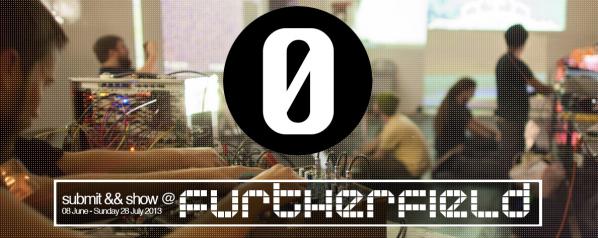
Alma Alloro
Alma Alloro (IL) is an artist, musician and performer from Tel Aviv. She is rooted in the backyard of popular culture using diversified media from drawing, installation, music, and animation to internet; her recent works focus on the correlation between old media and new media.
Melissa Barron
Melissa Barron is an artist living and working in Minneapolis, Minnesota. She studied at the School of the Art Institute of Chicago where she focused on new media and fiber. In her work she combines these two fields by reinterpreting hacked Apple 2 software through different fiber techniques. Her work has been shown at various international events, including the Notacon hack festival in Cleveland, Ohio, GLI.TC/H in Chicago and ISEA 2011 in Instabul.
Nick Briz
Nick Briz is a newmedia artist, educator and organiser based in Chicago IL. His work has been shown internationally at festivals and institutions, including the FILE Media Arts Festival (Rio de Janeiro, BR); Miami Art Basel; the Images Festival (Toronto, CA) and the Museum of Moving Image (NYC). He has lectured and organized events at numerous institutions including STEIM (Amsterdam, NL), the Museum of Contemporary Art Chicago, Marwen Foundation and the School of the Art Institute of Chicago. His work is distributed through Video Out Distribution (Vancouver, CA) as well as openly and freely on the web.
Benjamin Gaulon
Benjamin Gaulon is an artist, researcher and art college lecturer. He has previously released work under the name “Recyclism”. His research focuses on the limits and failures of information and communication technologies; planned obsolescence, consumerism and disposable society; ownership and privacy; through the exploration of détournement, hacking and recycling. His projects can be softwares, installations, pieces of hardware, web based projects, interactive works and are, when applicable, open source.
José Irion Neto
José Irion Neto is native of Santa Maria, in southern Brazil. His first contact with computers was in 1982 using a machine equivalent to Sinclair ZX Spectrum. He has an academic background in Media Advertising and worked for some years as a Graphic Designer. Today, he has been working with advertising only occasionally, focusing on creating posters, dedicating most of his time on developing Glitch Art. He has worked and researched Glitch since 2008.
Antonio Roberts
Antonio Roberts is a British digital artist whose artwork focuses on the errors and glitches generated by digital technology. Many people would simply discard such artefacts but Antonio preserves these errors and displays them as art. With his roots in free culture he develops his techniques using open source and freely available software and shares his knowledge through the development of software.
Ant Scott
Ant Scott (UK) is a glitch artist and co-author of the first glitch aesthetics coffee table book Glitch: Designing Imperfection (New York: MBP, 2009). His work is informed by cognitive distortions.
Rosa Menkman
Rosa Menkman is a Dutch visualist who focuses on visual artifacts created by accidents in digital media. The visuals she makes are the result of glitches, compressions, feedback and other forms of noise. By combining both her practical as well as an academic background, she merges her abstract pieces within a grand theory artifacts (a glitch studies), in which she strives for new forms of conceptual synthesis of the two. In 2011 Rosa wrote Glitch Moment/um, a notebook on the exploitation and popularization of glitch artifacts (published by the Institute of Network Cultures), organized the GLI.TC/H festivals in both Chicago and Amsterdam and co-curated the Aesthetics Symposium of Transmediale 2012.
Furtherfield Gallery
McKenzie Pavilion, Finsbury Park
London N4 2NQ
T: +44 (0)20 8802 2827
E: info@furtherfield.org
Furtherfield Gallery is supported by Haringey Council and Arts Council England
Featured image: Five Thousand Feet is the Best by Omer Fast.
In perusing Honor Harger’s recent missive on drone aesthetics and James Bridle’s ongoing posts of drone images at Dronestagram, taken in context with the Glitch un-conference in Chicago, some new questions have come to mind. These questions have to do with conceptions of New Aesthetics in its various forms in terms of interaction with the program/device and its level of autonomy from the user. In my mind, there seems to be a NA continuum from generative programs that operate under the strict criteria of the programmer to the often-autonomous actions of drones and planetary rovers. As you can see, I am still chewing on the idea that The New Aesthetic as it seems to be defined, as encompassing all semi-autonomous aspects of ‘computer vision’. This includes Glitch, Algorism, Drone imagery, satellite photography and face recognition, and it’s sometimes a tough nugget to swallow that resonates with me on a number of levels.
First, image-creating technological agents are far from new, as Darko Fritz recently stated in a talk that algorithms have been creating images, in my opinion, within criteria of NA since the 60’s, and pioneers like Frieder Nake, A. Michael Noll, and Roman Verostko have been exploring algorithmic agency for decades. If we take these computer art pioneers into account, one can argue that NA has existed since the 60’s if one lumps in genres like Verostko’s ‘style’ of Algorism or the use of algorithms as aesthetic choice. A notch along the continuum toward the ‘fire and forget’ imaging (e.g. drones) is the Glitch contingent, which is less deterministic about their methodologies of data corruption aesthetics by either running a program that corrupts the media or they perform digital vivisection and watch what little monster they’ve created. Glitchers exhibit less control over their processes, and are much more akin to John Cage, Dada or Fluxus artists in their allowance of whimsical or chance elements in their media.

However, as we slide along the spectrum of control/autonomy from the lockstep control of code to the less deterministic aesthetics of face recognition, drone imaging, robotic cameras, Google Street View cams, Mars Rovers and satellite imaging, things get murkier. Autonomic aesthetics remind me of the ruby-hued Terminator T500 vision generated by intelligent agents running the ‘housekeeping’ on the machine platform. I consider this continuum from Algorism to Glitch to autonomous robotic agents under an NA continuum of aesthetics is important insofar as it defines a balance of agency between the operator and the ‘tool’. For me this is the difference between the high degree of control of the Algorist, the ‘twiddle and tweak’ sensibility of the Glitcher, and the gleaning from the database of pseudo-autonomous images created by Big Imaging created by drones and automatic imaging. Notice I use the term ‘pseudo’ in that there are operators flying the platforms or driving the car, while the on-board agents take care of issues like pattern/face recognition and target acquisition. We also see this in Facebook, as recent technological changes as of 2012 have introduced face recognition in the tagging of images. From this, a key issue for me in this discussion of what began as a nebulous set of terms (the criteria of NA as defined by the global conversation) is that of agency and autonomy, and how much control the New Aestheticist gets in the execution of their process. Another important point is that I am not calling the ‘New Aestheticist’ an artist or curator, but something in between, but I’ll get to that later as this is also an issue of control of intent.
Back to this idea of autonomy between the subject, the ‘curator’ and the viewer, what interests me is the degree of control or not that the person creating, tweaking, or gleaning the image has over the creation or contextualization of that image. In the case of the Algorist, this is the Control end of the spectrum, where the artist takes nearly full control of the process of creation of the image, unless there is a randomization function involved in the process, and that it itself is a form of control – very Cybernetic in nature. Agency is at a maximum here, as the artist and machine are in partnership. Roman Verostko is a prime example of this, as he explores intricate recursive images created by ink pen plotters using paints in the pens. What he, and the AI-driven AARON, by Harold Cohen, for that matter, are machine painting.
The next step down the autonomy spectrum would involve the use of ‘glitch’ tools and processes that distort, disturb, and warp digital media. The process involves executing a given intervention upon the medium, such as saving it improperly, hex editing its code to corrupt it, or as Caleb Kelly writes, ‘crack’ the media. There are differing degrees of disturbance of the media to inject chance processes into it, from a more ‘algoristic’/programmatic application of programs upon the media to directly changing the internal data structure through manipulating the information through hex code and text editors. The resultant process is an iterative ‘tweak and test’ methodology that still involves the user in the process to varying degrees. Of course, the direct manipulation of the data with a hex editor is the most intimate of the processes, but there is still one factor to account for. The factor in question is that there is the set of causes and effects that are set in motion when the artist/operator opens the media and the codec (Compressor/DECompressor) mis/interprets the media, as is intended by the artist.
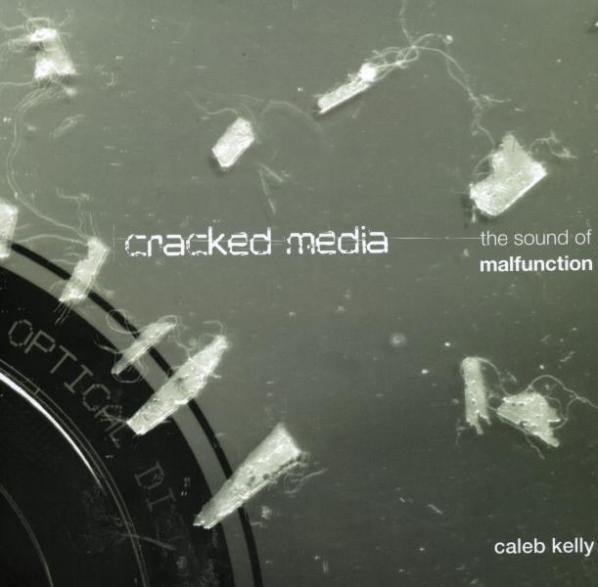
If we are to look at the glitch process, we can say that there is a point of intervention/disturbance upon the media, which is entirely a function of control on the part of the user. Afterwards, it is set loose into the system to allow the corruptions within the media to trigger chance/autonomous operations in its interpretation in the browser, etc. This is where the glitcher straddles the line between control and autonomy, as they manually insert noise into their media (control), then the codecs struggle with the ‘cracked’ media (autonomy). The glitcher, then, has the option to try a new iteration, thereby making the process cybernetic in nature. In Glitch, there is a conversation between the operator, the media and the codec. With the aesthetics created by drones, algorithmic recognition software, and satellite reconstructions, the process is far more autonomous/disjoint, and the New Aestheticist has to deal with this in the construction of their practice.
In the genre that I will call ‘mobEYEle’ imaging, the robot, satellite, or parabolic street eye abstracts from the ‘artist’, aptly turning them into an ‘aestheticist’, as their level of control is defined as that of a gleaner/pattern recognizer from the image bank of Big Data. Rhetorically speaking, we could say that a connection between the aestheticist and the generator of the image would be less abstract if, say, a New Aestheticist were to be in the room with a drone pilot, conversing about points of interest. It is likely that a military remote pilot and a graphic designer would have sharply differing views as to what constitutes a ‘target of interest’. Like that’s going to happen…
Therefore, let us just say that the collaboration of a New Aestheticist and a drone pilot is nightly unlikely, and that the New Aestheticist is therefore abstracted from the decisions of command and control involved in acquiring the image that eventually gets in their hands. This, however, presents us with two levels of autonomous agency, one human and one algotrithmic. But before I expand on this, I would like to discuss my decision to call the practitioner an ‘aestheticist’ as opposed to an artist or curator.
This decision rests on what I feel is the function of the aestheticist, that is, to glean value from an image and ‘ascribe’ an aesthetic to it. This position puts them in a murky locus between artist and curator, as they have elements of neither and both. For example, does the drone-image NA practitioner create the image; are they the artist per se, of the image? No. Although they are more closely aligned to curatorial practice as they collect, filter (to paraphrase Anne-Marie Schleiner), and post on tumblrs and Pinterests? From my perspective, the role of a curator is the suggestion of taste through and informed subjectivity through ecologies of trust and legitimacy, but the social image aggregator, although they might want to perform the same function, has no guarantee of accomplishing this unless they develop a following. Therefore, under my definition, they are neither creators nor taste-makers in the traditional sense, so what makes sense is to call them ‘aggregators’ of aesthetic material and thus my term ‘Aestheticist’.
Returning to our conversation, the drone aestheticist, then, is subject to one of two degrees of completely abstracted autonomy of the creation of the image; that of the operator or that of the algorithms operating the drone. The abstraction surrounding the human operator is easiest to resolve, as the images of interest are either the preference of the drone operator or those created by the operator under the parameters of the mission, and not the results of a New Aestheticist’s joyride on a Global Hawk. It is merely someone else’s volition selecting the image, and a confluence of personal interest deciding as to whether the image deserves to be on the New Aestheticist’s social imaging organ. However, it is the drone’s algorithmic image acquisition system that creates a more alien perspective in regards to aesthetics and autonomy of the image.
Compared to the Algorist or the Glitcher, all loosely placed under the banner of New Aesthetics, the Drone/Big Data Aestheticist is most problematic, as they are a fetishizer of sheer command and control operations that are potentially utterly abstracted from the pilot/driver’s volition. This creates a double abstraction through first the pilot, and then the algorithmic recognition system. There is no cybernetic loop here at all, as the gleaning of the item of interest from the beach of Big Data is twice removed from any feedback potential. Secondly, as I have written before, the Drone Aestheticist is exactly that, a gleaner of interesting images for use on their social image site, which in itself is a bit of an abject exercise.
Or is it? For example, if one is to say that the Aestheticist gleaning the images does so without intent or politics, and is merely operating on fetish/interest value, then this is perhaps one of the least interesting practices in New Aesthetic practice. But on the other hand, if one looks at the work of practitioners like Jordan Crandall, Trevor Paglen, or Ricardo Dominguez, who examine the acquired image as instrument of aggression, control, and oppression, this puts a new lease on the life of the Drone Aesthetic. In a way, though inquiry, there is an indirect feedback loop established in questioning the gaze of the device, its presence, and its function in its theater of operations. The politics of the New Aesthetic emerges here, in asking what mechanisms of command and control guide the machine eye and determine its targets of interest. This is of utmost importance, as the abstracted eye is guided without subjectivity or ethics and is determined solely by the parameters of its algorithms and the stated goals of its functions.
Is the aesthetic of the machine image merely a function of examining its processes, fetishizing its errors, or something else? The criteria of the New Aesthetic attempts to talk about a spectrum of digital imaging that stretches back into time far longer than 2010, and has a problematically broad sense of definition. Once these problems are set aside as a given, one of the key criteria for the evaluation of NA practice and the function of its images depends upon the degree of control and autonomy inherent in the process within the creation of the image. This is formed in a continuum of control and abstraction from Algorism and Generative Art to autonomous eyes like drones and satellites. Algorism is one of the oldest NA practices, and exhibits the closest relationship between artist, machine and determinacy of digital process. A greater degree of indeterminacy is evident in the Glitch, but the iterative process of tweaking the media and then setting it forth into the process of interpretation by the codec, foregrounds the issue of digital autonomy.
The eye of the unmanned platform abstracts creation from the human organism at least once if a human does not operate it remotely, and twice if it is. There is the Terminator-like fear of the autonomous robot, but at this time, perhaps the more salient questions regarding what I have qualified as drone/autonomous aestheticism under NA of what the function of the image is, and is it really that interesting? Are the practices of NA blurring artistic and curatorial practice into a conceptual aestheticism, creating a cool detachment from the image despite its source or method of creation? Is the bottom line to the genres of NA the degree of control that the artist or aestheticist has over the image’s creation or its modality/intent? It seems that NA is an ongoing reflection upon the continuum of control over the generation of the image, our beliefs regarding its aesthetics, and what the intentions or politics are behind the creation of the New Aesthetic image. Or, as I have written before, are we just pinning images from Big Data and saying, “Isn’t that kinda cool?”
Maybe it’s somewhere in the middle of intention and cool.
Featured image: Image from Fab Lab (fabrication laboratory), small-scale workshop offering digital fabrication
There is currently a significant amount of interest in the relationship between free and Open Source practices in art and the aim of this report is to map out some of these shifting relationships in contemporary models of education both online and offline. The recent expansion of so-called ‘free culture’ has contributed to placing the debate over authorship, ownership and licensing of the artwork at the centre of artistic production. Crucially, the transformation of art in the age of global culture and the consequent move from autonomous art objects into cultural artworks and services, has resulted in the emergence of three visible tendencies: 1) free/Open/Source software as artistic-pedagogical method, 2) the critical emancipation of the self-education movement and 3) the digitisation of art education practices into Open Source packages of cognitive labour.
One possible way to navigate this complex ideological terrain is the conciliatory term free/libre/Open Source software (floss), seeing it as “part of an emerging transdisciplinary field that deals with different forms of openness.” [1] At the heart of the debate is the political distinction between the Free Software Foundation[2] and the Open Source Initiative.[3] The ‘copyleft’ attitude (free software movement) asserts four freedoms for software: free from restriction, free to share and copy, free to learn and adapt, free to work with others.[4] The Open Source definition,[5] on the other hand, in spite of apparent similarities, has developed into flexible arrangements such as the Creative Commons licenses[vi][6], some of which restrict these freedoms when applied to media/cultural works and publications, not allowing for derivative artwork or its commercial use under specific license combinations.[7]
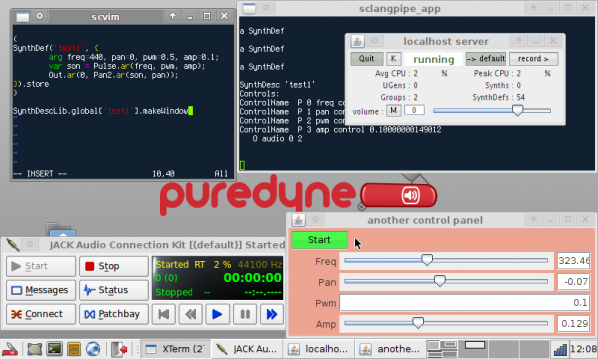
A number of projects, such as the pure:dyne[8] – GNU/Linux operating system for live audio visual processing and teaching – are, however, fully identified with the principles of free software. They have emerged from artists’ collectives whose relationship to art education is informally associated with sharing spaces, the hacklabs and free media labs where they run workshops and introduce participants to the use of free digital art tools. [9] Their mode of production is centred on ‘live code’ and feature two essential characteristics: 1) collaborative- relying on large-scale public participation and 2) distributive- offering the tools and the process notes (notation) to empower the others to carry on the work on their own.[10] This philosophy implies that the artistic performance of the work is complemented by a set of pedagogical approaches associated with the enabling of production by others. [11]

The movement for free education has gained greater relevance as a result of the global financial crisis and the battle for control of university fees.[12] In this context, art education has been developing into an artistic project while also providing an emancipatory movement reacting against dominant forms of institutionalised knowledge production. Within this movement, the role of free/open technology has been central in the mediation of self-education as a social movement.
On the one hand, artists –freelancers, sometimes temporarily/precariously plugged into educational institutions whilst working as teachers, others times as workshop facilitators in free access spaces– have opened up their classrooms to the environment of the read/write web, and with their students-collaborators, have produced and shared in wikis, blogs and Second Life, art and education resources that make an increasingly significant contribution to a larger body of knowledge that is the web. [13] Wikiversity is a model of this confluence of self-education movements and open online education.[14]
In parallel with the above-mentioned tendencies of online systems, numerous critical projects have appeared that are associated with the reclamation of space that occurs as artists have found themselves at the forefront of self-organised and self-managed self-education projects.[15] Some have happened side-by-side with the reclamation and occupation of spaces such as the Temporary School of Thought[16] and the Really Free School.[17] Part of these groups activity is the establishment of a free programme of workshops on topics that can range from free software tools to Ivan Illich and Deschooling Society.[18] Others that make opportunistic incursions into the artworld such as the Bruce High Quality Foundation University,[19] the Future Academy[20] or Unitednationsplaza,[21] are platforms for experimental art as research, investigating the production of knowledge that occurs when art education itself becomes artwork or exhibition.[22]
While the debate on free education has been enjoying significant visibility, the Higher Education sector has also joined in. A few recent initiatives have supported universities of the arts developing virtual learning environments and providing access to open education resources (OERs). This is the case with the JISC Practising Open Education Project (2010-2011)[23] with six art, design and media departments in UK universities. A number of these OERs include art work (photographs, drawings and videos), but the majority are art theory, mostly research papers, dissertations and art education research documents produced by artists-teachers-researchers as part of their continuing professional development. These are distributed with Creative Commons licenses with varying degrees of freedom, but rarely have the ‘copyleft’ attitude that has been associated with the free software.
Such an enterprise can be interpreted in the light of current debates in the fields of immaterial labour and cognitive capitalism revealing that whilst (digital) art becomes postproduction, art education is being packaged into open resources that circulate as part of the capitalist system, and become central to the new eLearning/networked economies. In addition to filling a gap in subject-specific open resources, this raises the question: why is the free and the open so popular in contemporary art education? A cynical hypothesis is that art education, by declaring itself as a type of production of knowledge, attempts to gain a new legitimacy, in the bureaucratised global knowledge market. The other possibility is that in the face of such a doomed scenario, art education searches for new possibilities beyond pure commercialism, reclaiming access through “contingencies of opening and mobility of cognitive packages beyond confines of ownership.” [24]
1. Floss as artistic –pedagogical method
The Digital Artists Handbook
The digital handbook, published by the arts organisation folly and artists’ collective GOTO10 in 2008, aims to give artists information about the available tools and the practicalities related to Free/Libre Open Source Software and Content such as collaborative development and licenses.
FLOSS+Art
This book edited by Aymeric Mansoux and Marloes de Valk in 2008 reflects critically on the growing relationship between Free Software ideology, open content and digital art. With contributions by: Fabianne Balvedi, Florian Cramer, Sher Doruff, Nancy Mauro Flude, Olga Goriunova, Dave Griffiths, Ross Harley, Martin Howse, Shahee Ilyas, Ricardo Lafuente, Ivan Monroy Lopez, Thor Magnusson, Alex McLean, Rhea Myers, Alejandra Maria Perez Nuñez, Eleonora Oreggia, oRx-qX, Julien Ottavi, Michael van Schaik, Femke Snelting, Pedro Soler, Hans Christoph Steiner, Prodromos Tsiavos, Simon Yuill. Available both in print and as torrent download
Technology Will Save Us
The project by Daniel Hirschman & Bethany Koby is a haberdashery for technology and alternative education space dedicated to helping people to produce and not just consume technology.
Openlab
Openlab Workshops was started by artist and educator Evan Raskob in mid-2009 to fulfil the need for practical education about digital art and technology. Floss workshops are developed and taught by working artists and media practitioners, giving participants direct access to practical experience.
GOTO10
GOTO10 is an artists’ collective that organises floss workshops on subjects such as Pure Data, Linux audio tools, physical computing, SuperCollider, puredyne, RFID, Audio Signal Processing, and other related areas of practice.
UpStage
UpStage is an Open Source platform for cyberformance and education: remote performers combine images, animations, audio, web cams, text and drawing in real-time for an online audience. Initiated by the globally dispersed performance troupe Avatar Body Collision, it runs the annual Upstage festival, open to proposals.
2. Self-organised and self-managed art education
Really Free School
Free school based in a squatted London pub. “Amidst the rising fees and mounting pressure for ‘success’, we value knowledge in a different currency; one that everyone can afford to trade. In this school, skills are swapped and information shared, culture cannot be bought or sold. Here is an autonomous space to find each other, to gain momentum, to cross-pollinate ideas and actions.” (Communiqué #1)
Bruce High Quality Foundation University
A free university project set up by NY-based artists’ collective The Bruce High Quality Foundation. “We believe in the artistically educational possibilities of collaboration. Collaboration, as we mean it, means a group of concerned people come together to hash out ideas, try to figure out the world around them, and try to take some agency within its future. That’s the why and how of The Bruce High Quality Foundation. BHQFU is an attempt to extend the benefits of this collaborative model to a wider number of people.”
Unitednationsplaza
A temporary, experimental school in Berlin, initiated by Anton Vidokle following the cancellation of Manifesta 6 on Cyprus, in 2006. Developed in collaboration with Boris Groys, Liam Gillick, Hatasha Sadr Haghighian, Nikolaus Hirsch, Martha Rosler, Walid Raad, Jalal Toufic and Tirdad Zolghadr, the project travelled to Mexico City (2008) and, eventually, to New York City under the name Night School (2008-2009) at the New Museum. Its program was organized around a number of public seminars, most of which are now available in their entirety online.
FOSSter creative Learning
Lesson plans that can be used in the art classroom, developed by The FOSSter Creativity Team, a group of students of the University of the Arts (USA)
3. Open Source Repositories
University of the Arts institutional OER repository
University for the Creative Arts institutional OER repository
VADS (Visual Arts Data Service) A collection of over 100,000 art and design images that are freely available and copyright cleared for use in learning, teaching and research in the UK.
OER Commons A repository of materials about teaching, technology, research in the emerging field of Open Education. Art materials at OER commons.
You can find paula’s original article on Collaboration and Freedom – The World of Free and Open Source Art http://p2pfoundation.net/World_of_Free_and_Open_Source_Art
This article is part of the Furtherfield collection commissioned by Arts Council England for Thinking Digital. 2011
Cyposium
an online symposium on cyberformance
Friday 12th October 2012
http://www.cyposium.net/
We all perform on the Internet. The social media profiles that we are contractually obliged to give our real names to are just as much performances as our World Of Warcraft or Minecraft avatars. Yet these impromptu performances of our socialised and fantasy selves lack the literary quality of drama. Not drama in the sense of a Usenet or Tumblr flamewar, but in the sense of theatre.
The 1993 New Yorker cartoon captioned “On the Internet, nobody knows you’re a dog” identifies two important features of the early public Internet. Firstly it’s a place, somewhere you can get onto. Secondly that place has limited bandwidth for establishing identity and communicating affect. This meant that the Cyberspace of the net became a site for identity play and imagined realities.
As the text-based virtual reality of MOOs gave way to the image-based Palace Chat and then three dimensional AlphaWorld the available bandwidth increased and with it the available ambiguity decreased. Describing a character or a scene or an action with a few words leaves the members of the audience much freer to exercise their own imaginations than seeing it in full motion animation with a high polygon count.
The visual, social and even economic order of virtual worlds and social media have become a more fixed and uncritical embodiment of mass media and the established social order. This has reduced their potential for alterity but it has made them useful representations both of shared reality and shared fantasy that can be used as a stage on which to perform critically, reintroducing the literay against the grain of their unreflective consumption of identity and spectacle.
Throughout this history, from the early 1990s to today, the Internet’s affordances have been used to produce dramatic performance in Cyberspace, “cyberformance”. The problem is we don’t remember this, at least not as clearly as we should. Individually, institutionally, and technologically we have lost our memories of artistically groundbreaking and important performances.
This problem is not unique to cyberformance. All digital art suffers from the decay of digital media and the creeping obsolescence of the hardware that it runs on. Internet art suffers from bitrot, software obsolescence, linkrot, the loss of web pages and sites elsewhere on the net that are connected to the work, and netrot, changes in the protocols used to distribute it.
Above and beyond those problems, cyberformance involves live perfomance. Unique events produced by historical communities at a particular moment using media that will rapidly become obsolete need to be recorded in order to be remembered or at least to be critically re-evaluated later. This creates a second layer of conservation and archiving problems.
Take the example (outside of Cyposium) of Judy Malloy’s “Brown House Kitchen”, a narrative environment created in the LambdaMOO text-based virtual reality. Despite being mentioned in surveys of virtual art in the 1990s, despite being produced with institutional support, and despite being stored on one of the longest-running textual virtual world servers the software objects that made up the work were recycled as part of the normal running of LambdaMOO and are now lost. Many other text-based virtual realities, some specifically designed for dramatic works, are not even online any more. And the protocols used to access them are old, with software to connect to them increasingly not installed by default on newer operating systems. Even those created after the Internet Archive started will not appear in it, as they are not web-based.
I mention LambdaMOO as by chance I was researching text based virtual worlds and performance in the months before Cyposium was announced. One work that was described in the literature but untraceable online was Stephen A. Schrum’s “NetSeduction”. Which Schrum presented and discussed at Cyposium. And the script of the original performance was made available through the Cyposium website. Without Cyposium, these resources would not have been made available.
These contrasting examples drive home just how badly needed Cyposium was. The Internet does enable us to digitise and experience more culture than ever before, but it also erases our memories of the culture that is native to it. And the often highly experimental nature of cyberformance makes it harder to record and remember than almost any other kind of technologically enabled art.
As well as addressing a specific need to recover the history of net performance, Cyposium is an exemplary model for a new kind of online event in the era of Massively Online Open College courses. It performs the function of a symposium or convention online, reducing barriers to access and increasing reach for institutions, speakers and audience members. The Waterwheel Tap software used for most of Cyposium allows side-channels of audience communication, which help to build a sense of place and community and allow the audience to ask (and answer) questions and share knowledge among themselves and with the speakers.
The panel discussions that Waterwheel enabled meant that old and new net performers could discuss each others work in the light of new developments or freshly reconsidered history. And we, the audience, wheoever we were and wherever we were, could watch and learn from this discussion and join in. I am often wary of the word “open”, but there was an intellectual and social generosity and inclusiveness to Cyposium that made it feel like a very open event.
A ripple of excitement went through the mailing lists I subscribe to when Cyposium was announced. Its organizers and line up promised something special, and the event itself didn’t disappoint. To be part of the audience, chatting in text alongside the live streaming video presentations, was to be part of both a welcoming ad hoc conversational community of interest and participating in a key moment in a larger historical conversation.
Cyposium went beyond recovering and presenting the history of online performance. It brought together net performers old and new in productive dialogue in front of an engaged audience and served as an example of a new kind of net native event. Now that the event itself has finished the Cyposium web site serves as an important record of an important aspect of online creativity.
This essay will appear in the forthcoming Cyposium book.
The text of this review is licenced under the Creative Commons BY-SA 3.0 Licence.
‘About 50% of global trade is channelled through tax havens and 83 of the 100 largest multinationals are based in the Netherlands for fiscal reasons. The flow of money seeks the path of least resistance – but where exactly do those paths lie today?’
This is how graphic designer Femke Herregraven began a presentation about her new online game Taxodus. Herregraven designed the prototype of Taxodus, a game about offshore tax avoidance, during a master class at Sandberg-Mediafonds. The offshore system offers companies advantages in countries where legislation relating to non-nationals guarantees certain privileges, for example, when it comes to corporate structures, in certain areas of business confidentiality, or low taxation. Taxodus is an accessible way to discover how you can avoid paying taxes, and if you can’t get away with it completely, how you can make sure you pay the lowest possible amount.
Annet Dekker: Taxodus is a game about offshore business practices. How does it work?
Femke Herregraven: As a player you choose an existing multinational company or bank with a specific profile and then you look for the most favourable countries to set up a subsidiary and accumulate income by paying as little tax as possible. Each country has a specific transaction profile. For example, companies involved with Intellectual Property Rights find the Netherlands most appealing, while oil companies are drawn to other countries. The game offers a random number of options and calculates what these yield for you. You can compare the results with other countries to achieve the game’s goal of reaching the end with as little expenditure as possible. The game is based on actual information on withholding tax in global tax treaties.
AD: This isn’t a topic you usually encounter in art. Where does your interest in this subject originate?
FH: In 2010 I was asked by the Virtueel Museum in Amsterdam to research the identity of the Zuidas during a residency. The Zuidas, which literally translates as ‘South Axis’, also known as the ‘Financial Mile’, is a large, rapidly developing business district in Amsterdam. Much like Richard Florida, they wanted to ‘cheer up’ the neighbourhood. My questions about the companies located there received only vague responses; there weren’t any lists, or names, or post boxes, and with the exception of known names like Google and Facebook, the other companies that are based there was a mystery. To trace what type of businesses might be located there I spent weeks indexing the entire Zuidas from the Chamber of Commerce’s trade register. I indexed the occupants by street and house number and then compiled three telephone books from the data. All sorts of unusual data and patterns became evident – some addresses only have one occupant, while others have more than a thousand of the so-called mailbox companies that only exist on paper. This is also apparent from the names: some only consist of Roman numerals.
All this information piqued my curiosity and I wondered why these companies were situated there and what they were up to. The next step was delving into Dutch tax law and it became clear that there are enormous financial benefits to setting up a company in the Netherlands. This is a major selling point when Holland is promoted abroad. The entire offshore system has operated below the radar for a long time – sometimes we catch a glimpse of it – but quite how it works in its entirety almost no one knows. The first step to understanding this is visualising it to gain insights, and then you can ask specific questions. Taxodus classifies this information by visualising it: from mining in the Congo to oil companies in Italy and Libya.
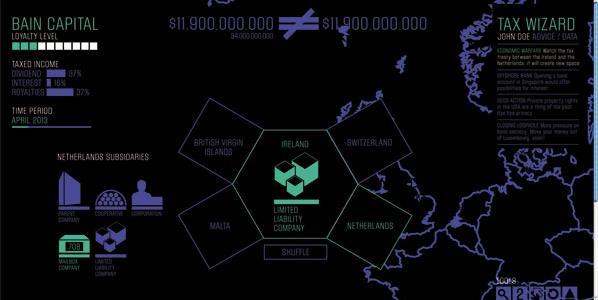
AD: It all sounds very murky!
FH: It’s all completely legal, but shady at the same time. If a foreign company doesn’t want to open a physical office in the Netherlands, it hires a trust office that takes care of the bookkeeping, drafts the annual reports and appoints a CEO. There are countless small trust offices that manage huge numbers of foreign companies on paper. Everything is done according to Dutch law and the tax benefits in Holland are hugely beneficial for foreign companies. For example, small businesses in the Netherlands pay more than thirty per cent tax, while foreign companies avoid a large part of that taxation due to tax planning. The presumption that foreign companies basing themselves in Holland is beneficial for national employment is also misleading because most of these companies only exist on paper and don’t employ anyone. The trust offices advise against opening a physical office and taking on any staff because Holland attaches great value to its employment policy, which makes dismissing personnel difficult. A ‘mailbox’ company avoids all these complications.
AD: But the way in which you visualise this is also subjective because you manipulate the data.
FH: Yes, I selected companies that people will know or which appeal to the imagination. Unfamiliar names won’t really be noticed, but once you realise that almost everyone participates in this system, from Mitt Romney’s Bain Capital, Walmart, Google and Facebook to Chanel, then it takes on a different immediacy or value for many people. If you look at this on a wider scale – globally – you will see, for example, that 60 per cent of large companies in Portugal, Italy, Greece and Spain use the Netherlands to take advantage of these types of constructions. This is legal and it’s also beneficial to the Netherlands, but when Dutch politicians insist on more transparency from Greece and lecture the country from up on high it smacks of hypocrisy. You see the same thing with a lot of development aid to countries in Africa: most of that money is diverted to the bank accounts of African leaders in offshore tax havens. Someone has done the maths: the debt of the entire African continent is less than the monies African leaders hold in offshore tax havens. A ‘mailbox’ company by itself is not that suspicious, but with everything else it creates the holes through which (public) money can disappear. My primary intention is to make these flows of money visible and question them, because once it’s out in the open people can decide for themselves if this is our idea of a sustainable economy.
AD: Of course, your game can also be interesting for existing companies who can use it to see where and how they can best invest? Is Taxodus the new Monopoly?
FH: Yes, in a way it is, but in reality companies have been doing this for ages. General Electric supposedly has a department employing about a thousand people who are busy with this on a full-time basis. I don’t think my game will suddenly improve things. Yet, the point is that the knowledge about international tax planning is now only in the hands of experts like fiscal lawyers and accountancy firms, and isn’t accessible to the rest of us. That’s also what Taxodus is about, making a tool so that we can track what they’re up to.
Monopoly is an interesting comparison because it originated as a critique of capitalism and private monopolies. The games are comparable, but Taxodus goes further. If you make a move in the game that correlates to reality then you are informed about this and receive a reality-bonus. It’s at this point in the game that investigative journalism comes into play.
AD: How do you relate to investigative journalism?
FH: My projects frequently begin from a journalistic position and for this one I meet with journalists, fiscal lawyers and researchers quite often. Yet, I’m a designer and I don’t want to write articles but use other methods to provide insights into topics. For me design is not an end in itself but a way to research, express and contribute to debates in society. This means also collaborating with other disciplines and experts: a group of fiscal experts is currently helping to remove errors and provide feedback. Obviously, it’s impossible to create a 1:1 translation, there will always be things that aren’t entirely accurate or that have to be left out, but it is important that the broad outlines are clear and correspond with reality.
AD: Why a game?
FH: Avoiding and evading tax is complex but you can learn the psychology of this system by playing the game. Taxodus is actually a kind of chess game. The rules aren’t simple and your eventual benefits depend on all sorts of interrelated factors. You have to continually take strategic decisions to advance in the game. All this information is incorporated into the game and the various tax treaties between different countries gradually become clearer. You are aided in this by advisors. At the start of the game you chose a particular advisor. Different advisors offer different advice, some will try to find legal alternatives while others try to convince you to bend the rules. Players can ask for a second opinion at any point in the game and manipulate regulations and treaties. This enables players to steer the game in the direction they choose. As in reality, a player has to have the possibility to have complete control. Ideally the game should be a do-it-yourself kit that you can add things to, an open game of strategy.
AD: What do you mean exactly? Can you name an example?
FH: The simplest way is to play it alone; the more complicated version is played with others in real time. At a certain point you can earn loyalty points by, for instance, evading high taxation for your parent company. Once you’ve arrived at the loyalty level, you can change roles, perhaps becoming a government employee who modifies regulations ever so slightly to make it more beneficial for yourself. You can also block other players in this way. This is an obvious reference to the increasing merging and blurring of the interests of large corporations and political leaders.
AD: How do you keep up with actual changes in the real world?
FH: It isn’t as if new information is constantly being made available – a lot of countries are reluctant or refuse to release ‘sensitive’ information. Tax treaties and regulation doesn’t change too often, but when they do, these changes will also be incorporated in the game. The English researcher Nicolas Shaxson, who is very active in charting the offshore system, says that people have to first become aware of what’s happening before they can think about how to deal with it. I hope my game and visualisations can contribute to this awareness raising.
AD: When or how does the game end?
FH: You have a certain amount of time before you have to submit an annual report for your company, then your trajectory is incorporated into the database and you can see what your score is. You can also compare it to other players and download their fiscal structure, which adds an element of competition and makes it a crowd-sourced investigation. By playing you contribute to the research and help expose the layers.
AD: Will Taxodus be a commercial success?
FH: My main concern is to make a tool that makes this small yet incredibly significant part of our opaque financial world more transparent, and especially more public. I think artists have a responsibility to broach topics like this. People find it all quite shocking when I tell them about Taxodus, but for those who are directly involved in the actual system it’s mere child’s play. This type of project can stimulate discussion and determine what is and what isn’t desirable.
This approach was shown to be successful with another project, the Art Reserve Bank. We set up a bank with a small group of artists and designers and introduced a new currency in the heart of the Zuidas as a way to encourage discussions about the financial sector. Our bank – a vault, an exchange counter and a glass house with a minting press: a bank brought back to basics – is located across from the ABN AMRO headquarters, and each day some of the employees and other people come by to see what we’re doing and have a chat. People also buy our coins, which are designed by a different artist each month. It doesn’t always go smoothly, but there is certainly enough curiosity. One problem is that people are personally interested but refuse to make any statements in a professional capacity. De Nederlandsche Bank (the Dutch central bank) recently sent us a letter stating that we cannot use the word ‘Bank’, threatened us with a fine of up to 2 million euros and invited us for a talk. These types of discussions are what we aim to achieve. Our goal isn’t necessarily to introduce a new currency; instead we want to underscore that fact that the bankers and financial experts of this world do not have exclusive rights to debate and decide what happens on financial markets.
———
A Dutch version of this interview appeared in Tubelight, September 2012.
Femke Herregraven: http://www.bitcaves.net
12 Remixes, by Michael Szpakowski
From August 2011 to July 2012, the video artist and musician Michael Szpakowski entered a remix competition every month, and compiled his remixes (some of them with accompanying videos) on his website. “I’m 54 years old,” he explained at the beginning of the project, “and although I’m musically reasonably deft I know little about the culture in which I’m attempting to intervene. I know none of the specialised vocabulary, can’t distinguish genres and although I understand what is being said, just about, I don’t speak the language in which posts or comments on this kind of work are framed.” The project, in other words, was a deliberate step outside his “comfort zone”.
The results are often startling. It’s worth comparing the remixes with the original tracks from which they derive, because it provides some insight into Szpakowski’s working methods, and makes you realise the extent of some of the transformations he has achieved.
One of the most striking examples is the remix of “Sandwiches” by the Detroit Grand Pubahs. The original track is a grotesquely overstated hyper-lecherous rap. A synthesised-drum-and-bass arrangement underpins a chipmunk-style speeded-up vocal, warbling lyrics of such obvious symbolism that they hardly qualify as suggestive: “I know you wanna do it/You know I wanna do it too/Out here on the danceflo’/We can make sandwiches…/You can be the bun/And I’ll be the burger, girl…/Make your thighs like butter: easily spread…” The effect is quirky, irritating and compulsive; tongue-in-cheek, deliberately outrageous, blatantly sexist and borderline pervy all at the same time.
Szpakowski’s remix has an entirely different feel. The vocals have been slowed right down from warbly chipmunk to entombed Darth Vader; correspondingly, the bassline has slowed too, from a prefabricated booty-shaker to something subterranean and slightly menacing; and in the space above there are echoey keyboard-notes floating and pulsing like luminous jellyfish. The effect of the lyrics is no longer leeringly voracious, but mournful, obsessive and introspective. There is an instrumental coda with a vaguely Scottish Highlands flavour to it. The feel of the track has changed completely, and so have its texture and geometry. We find ourselves in a darker, much larger space.
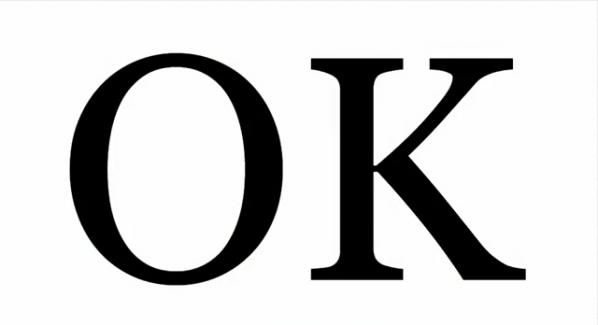
Another good example is “OK good stand clear”, based on “110%” by Laura Vane and the Vipertones. The original song is efficient, well-assembled funk/soul, complete with a punchy horn section and a sassy female lead vocal. It’s slick, sharp and professional, but hard-working rather than inspired. Szpakowski’s remix dispenses with almost everything except the rhythm section, which is slowed down slightly to give it more depth and a thumping creaky quality like an elephant in new walking-boots. To this he adds a sampled American voice saying “OK? Good” and “Stand clear of the closing doors!”, and a hammering piano-figure. Again the effect is to open the track out, to give it a more three-dimensional feel, and also to make it much less derivative, much less obviously the product of a particular genre.
In almost every instance Szpakowski’s remixes have a more resonant and spacious feel than the originals; the sounds are dirtier, fuzzier, more textured; and the rhythms are more complex. These changes may not always be entirely to his advantage. As he admits himself, “I don’t dance (or haven’t for twenty years or so), which actually makes a big difference in how one experiences popular music…” Certainly there is one track – a remix of “Paradisco” by Charlotte Gainsbourg and Beck – where Szpakowski’s version has a spiky, angular, echoey jazz feel, but loses out to the original in terms of finger-clicking compulsiveness. It’s true that his remix puts a stronger focus on Gainsbourg’s voice and lyrics than does the original; but whereas Gainsbourg and Beck’s version stays within the disco format and gives it an iconoclastic indie makeover, Szpakowski’s remix takes us beyond that format altogether, and comments on it from the outside.

In some of the tracks there is a move from the USA to Europe in terms of feel. One example is the remix of “What happens in Vegas” by Chuckie ft. Gregor Salto – a histrionic slab of USA club music. Szpakowki’s version (“Shit happens in Vegas”) has a distinctly Kraftwerk-esque, European-techno slant. Also, because the remixes are often crackly, fizzy and hissy, they tend to feel “older” than the originals. At times we seem to be listening to badly-tuned radios in the pre-digital era, or to vinyl LPs smothered in dirt and played through a fluff-laden needle. But this “distressed finish” effect is in keeping with a broader sense that Szpakowki’s remixing technique involves a kind of deconstruction or breaking-apart of the tracks on which he is working. They become less smooth and shiny, less self-contained. The original tracks are often tightly-focussed in terms of their musical styles, with a narrow range of subject-matter, and often with manipulative designs on the audience – wanting to make them feel like dancing, wanting to make them feel sexed-up, or trying to tug at their heart-strings (“Try to Stay Awake” by Frank Friend, “Trojans” by Atlas Genius and “Jigsaw” by Mimi Page are all relationship-based heartstring-tuggers). The remixes, on the other hand, aren’t looking for such straightforward reactions. Their subject-matter is less easy to pin down, and their ingredients bespeak a mixing-together of disparate materials, different cultures, and even different eras.
Non-musical ingredients are one noteworthy feature. In “OK good stand clear”, the voice saying “Stand clear of the closing doors!” comes, as Szpakowki explains, from “New York subway recorded announcements… grabbed, I think, from YouTube”. He is also fond of introducing a voice intoning random numbers – this occurs in several of the tracks. Usually the voice has a foreign accent, and sometimes the numbers are spoken in a foreign language. These number-sequences, says Szpakowski, come from “the so called ‘numbers stations’ which are believed to have been used by various intelligence agencies… they’re available at the internet archive“.
On “I’m getting a cat” the words come from mashed-up Tweets which have been run through a voice-to-text synthesiser. “I am that I am” borrows its vocal from the painter and sound poet Brion Gysin – a voice-sample which, until it begins to distort, sounds rather like a 1950s announcement on the BBC. “Speaking in Tongues” reverses the vocal on a hectoring soul track by Colonel Red called “Rain a Fall”, so that it ends up sounding as if it’s in some unspecified European or possibly Middle Eastern language. And “Sugar Plum Fairy on the Dancefloor” introduces the chiming melody from Tchaikovsky’s Sugar Plum Fairy into a rap called “Disco Technic” by Stan Smith, to surprisingly good effect. There is a genre-busting transgression of boundaries, a throwing-together of cultures, a jumbling-up of eras, and a deliberate use of incongruous material.
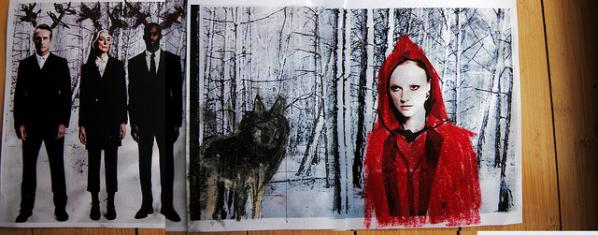
The videos Szpakowski has produced to accompany some of these tracks show similar traits. Again his admission that he doesn’t dance is relevant here, because the starting-point for many music videos – a very tight and emphatic synchronisation of visual effects with the beat of the track – is not a particularly dominant feature in his work. The one which succeeds best in this respect is the video for “OK good stand clear”, which projects text versions of the words onto the screen in big letters precisely as we hear them. There is also a lovely moment in the video for “I’m getting a cat” where, in a bit of old black-and-white footage, some youngsters sitting on chairs on a stage start to sway from side to side, apparently in time to the music.
But synchronisation to the beat isn’t Szpakowski’s priority. “I’m getting a cat” provides a good example of the kind of effect he achieves instead. The synthesised vocal for the track first announces that it’s getting a cat, then starts to ask absurd questions about cats and cat-care – “Does your cat try to style your hair?”; “What is your funniest and yet painful cat story?” – which are gradually infiltrated, first by other subject-matter – “Become a big brand on Facebook!” – then by symbols – “Poundsign poundsign poundsign” – and sequences of numbers. What starts off as funny, ironic and nostalgic develops or breaks down into a kind of digital fragmentation, and eventually into wordlessness. The end of the track is a wistful instrumental coda, embellished with piano and strings. And the video follows much the same path. It starts with old footage from the 1960s White House, in which President Lyndon B Johnson seems to be announcing his intention to get a cat to his slightly-bemused aides. Then there are some outtakes from what seems to be an instructional video in which a troubled youngster is being given helpful advice (presumably cat-care advice) by a reassuring and helpful older man. By the end of the track – the coda – we are watching teenagers playing music, drinking coffee and dancing. Again, humour and irony have been replaced by something more wistful and hard-to-define.
“Found” materials, often quite disparate materials spliced together by digital means, are just as important to the videos as they are to the remixes: they feature archive footage of the Whitehouse; shots of groovy teenagers from the Fifties or Sixties; Japanese Noh theatre; imagery based on Little Red Riding-Hood; square-dancing American kids; old claymation footage of teeth wearing boxing gloves; big black lettering; jumbles of coloured pixels; and images of Las Vegas captured from Google Maps, reconstituted into a long sun-baked backwards drive from the middle of town into the desert. Like the musical tracks they accompany, these videos cull their materials from many disparate places; they are full of little jolts of incongruity, slightly-bizarre juxtapositions; they lead us not only inwards towards the music but outwards towards different cultures and different eras; and they also call our attention to the digital medium itself, the Web on which all these materials are available, and the computer software which slices and splices them.

Perhaps most remix artists are more influenced by the work of their immediate peers than by art theory, art history, or inspiration drawn from other cultures. Not so with Szpakowski. As mentioned before, one of these remixes (“I am that I am”) uses a vocal track from Brion Gysin; and the words “OK good”, from “OK good stand clear”, are sampled from a recorded talk by William Burroughs. Burroughs and Gysin were the first proponents of cut-up and fold-up techniques in literature: Gysin was also an experimental painter and sound artist. This link with the two of them hints at a connection between Szpakowki’s remix style and modernist or post-modernist art. Remix culture itself is closely related to mash-ups, which in turn (whether remix artists are aware of it or not) can trace their ancestry not only to cut-ups and fold-ups but to the collages, bricolage, decalcomania and other mixed-media, mixed-genre experiments of the Modernists: experiments which reflected not only an urge on the part of Modernist artists to break free from received genres and formal conventions, but a feeling that the modern mind did not belong to a single era, a single unified body of belief or a single point of view – instead it contained many disparate perspectives, and ideas or images from many different eras and cultures, all thrown together into a jumble. For the modernists, this jumble was itself both one of the joys and one of the symptoms of modernity.
For modernist and post-modernist artists, formal perfection is often a secondary consideration, compared with the excitement of putting things together in new ways, seeing things from new angles. T S Eliot (in “Tradition and the Individual Talent”) described the mind of the artist as a “medium…in which special, or very varied, feelings are at liberty to enter into new combinations”. He made the same point in “The Metaphysical Poets”: the artist, he argues, “is constantly amalagamating disparate experience”; and modern art is bound to be more complicated than the art of earlier centuries, because modern life itself has become more complicated: “Our civilization comprehends great variety and complexity, and this variety and complexity… must produce various and complex results.” It was also argued, by various theorists, that modern artists found it increasingly difficult to belong wholeheartedly to a particular tradition, or to stick to a particular working method or lexicon of forms, because mass reproduction had made so many different traditions and examples, from so many different eras and cultures, available to them. If these observations were true at the beginning of the twentieth century, they are most certainly true now, at the beginning of the twenty-first, when life is characterised not just by “variety and complexity”, but by information-overload, and when the work of other artists, other eras and other traditions is available not only in museums, libraries, books and prints, but online at the click of a mouse or the blink of a Google query-screen. So one way of understanding Szpakowski’s remixes – his particular take on what a remix ought to be like – is to look at them in the light of modernist, post-modernist and digital-modernist aesthetics.
Another neo-modernist aspect of these remixes is their reluctance to woo the audience. There are moments when the arrangements are slightly unsympathetic to the listener. One example of this is “I’m getting a cat”, where the voice-over stops asking absurd questions about cat-care and starts coming out with fragmentary nonsense about Facebook, number-sequences, and “poundsign poundsign poundsign” instead. The “poundsign poundsign poundsign” sequence, in particular, goes on to a point where a lot of listeners might find themselves wishing it would stop. Similarly, on “I am that I am”, the voice-over, which starts with a sequence of variations on the theme of identity –
I AM THAT I AM
AM I THAT I AM
I THAT AM I AM
THAT I AM I AM
AM THAT I I AM
– soon gets speeded-up and distorted into an incomprehensible babble, and this babble is so loud and frenetic that it’s quite hard to hear the music. Again, some listeners may find themselves wishing that the voice-over would stop.
As already mentioned, the vocal track in “I am that I am” is based on an original piece by Brion Gysin, and Szpakowski has actually cut it down in order to re-use it – so although Szpakowski’s track may seem a little bit tough on the audience, it’s actually quite a bit less demanding than Gysin’s original. But the link with Gysin provides a clue to the aesthetics which are apparent throughout the whole “12 Remixes” project. “I am that I am”, as a text, is based on the idea of reordering a five-word line into all its possible variations, as can be seen from the extract above. As such, it has a mathematical quality. It resembles “ordinary” poetry in the same way that a peal of bells resembles “ordinary” music, and its structure and length are determined, not by any particular ideas about what may sound good to an audience, or what may provoke a certain emotional effect, but by the need to run through all the possible variations of a certain sequence in a certain order.
As a sound-poem the piece progresses in a similar way: Gysin takes his sequence of statements, and gradually adds echo to them and speeds them up until they become a frenzied babbling noise. In other words he performs a set of mechanical distortions on them, and increases or redoubles those distortions until they have reached a logical conclusion. Again, he is not particularly thinking about what will grip, entertain or move his audience: his attention is fixed on the materials, the medium and the process. This is not to say that “I am that I am” does not have any affect. It is delivered in the ringing tones of a self-important orator, and when the first layer of echo is added we imagine that the speaker might be addressing a rally in a great hall, like Citizen Kane, Mussolini or Hitler. But the self-assertion of the words is then turned into nonsense as the layers of distortion pile up. We feel firstly that great leaders and orators and being mocked, and then that identity itself is being called into question. But we also feel, as listeners, that these reactions may belong to us at least as much as to the piece itself: it has not been designed primarily with the purpose of producing them, and if we failed to experience them the piece would still have a purpose and meaning of its own beyond them, as a peal of bells has its own purpose and meaning whether we enjoy the sound of it or not.
This concern with sequence and process, with breaking things down into their constituent elements and then reorganising those elements according to mathematical rules, can again be related to the experiments of modernism – to the modernists’ determination to question and rearrange the materials and media from which works of art are made – but as the example of the peal of bells indicates, it can also be linked to much older forms of art; and at the same time it has a particular relevance for artists who are working with computers and code. Five words being reorganised into every possible sequence will produce a flicker of recognition in anyone who has every attempted code-poetry. It’s the kind of experiment which sits very naturally in the digital environment and the new media art genre.

Szpakowski’s remixes cannot be described as mathematical sequences or coded music, but they certainly do show evidence of a Gysin-like interest in variations and logical progressions. This may make them seem a bit unsympathetic in places, but it also gives them a certain air of toughness and detachment. As already mentioned, if they are compared with the original tracks on which they are based, one difference to emerge is that they don’t seem to have such obvious designs on their audience. But it’s also true that they don’t tend to follow such obvious paths in terms of musical development. If we look at “In Paradiscos”, for example, the original track has a very strong feeling of moving up a gear when it comes to the chorus, whereas Szpakowski’s remix doesn’t follow the same pattern. Another example is “the moon is inside the snow”, a remix of “Blindsided” by Luke Leighfield and Jose Vanders (which is itself a cover of an original track by Bon Iver). In Leighfield and Vanders’ version, there is a definite sense of drama and progression, as the female vocal is joined by piano and violin, and then by a male voice singing in harmony. By the end of the song, we feel that we have been taken on an emotional journey. It has a narrative arc. Szpakowski, on the other hand, dispenses with the male harmony altogether, and also with large sections of the song’s lyrics. He cuts up and rearranges snippets of the female vocal to create quite a different impression – more of a Haiku than a romantic poem – and he alternates the original vocal with a second female voice talking in Japanese. The end result is just as beautiful as the track on which it is based, but in a quite different way. It’s more austere and contemplative, less narrative and dramatic. It seems to be less about recounting a personal experience, and more about organising disparate elements into an aesthetically satisfying pattern.
Modernism, cut-up techniques, digital experimentation – perhaps these are big perspectives from which to view what is essentially a fairly modest project. Szpakowski didn’t set out on this series with any particularly grandiose ambitions: he set himself the task of producing one remix a month for a year because he thought it would be something interesting to do: it would build on his strengths as a musician and technophile, but it would also set him a series of new challenges. As it turns out, he has risen to those challenges to great effect and produced something really special – a collection which shows variety of tone and pace, wit and inventiveness, along with unity of design and a distinctive “voice”. Whether it’s a digital-modernist take on remix culture or not, anybody who is interested in experimental music could do a lot worse than put their headphones on and give it a try. It certainly repays close attention.
Sam Renseiw and Philip Sanderson’s Lumière & Son project is a near perfect and altogether exhilarating sequence of moving image lyric poetry (though lyric here does not exclude humour or the grotesque) and a demonstration of how seriality and fragment – an unfolding over time, the diaristic – has quietly become one of the fundamental modes brought stage centre by the network (so much more than the rather dull ‘interactive’ which has so quickly become the standby of the monetised digital). Impossible to watch one of these pieces without the desire to watch just one more.
The set (which lives online but has been shown offline in whole and part) and its component pieces, moreover, are studies in various interesting things: the liberating effects of constraint and collaboration and what those both demand and imply; also of randomness, or perhaps better, the loose, the dashed off, differing degrees of accuracy in such collaboration (also the apparently dashed off, the apparently loose [also the apparently synchronised or ordered]).
To start with, a little history. In 2007 two young members of the digerati, Andreas Haugstrup Pedersen and Brittany Shoot, invented a form and threw down a gauntlet. The form, in fairness, was not exactly new – over 100 years old, actually – but its re-contextualisation within the digital realm and more particularly on the network was, without exaggeration, a stroke of genius[1]. It involved taking precisely the constraints affecting the films of the cinema pioneers, the Lumière brothers, and applying these to contemporary online video work. Films or videos of exactly one minute, fixed camera, no sound, no zoom, no edits. Such videos dubbed, naturally, ‘Lumières’. There was clear recent precedent in the constraints of the Dogme movement of Von Trier and others but the project also drew on the various little-bit-art-little-bit-geek, young, playful cultures which abutted and intersected the more formal area which we called, for a while, ‘net-art’, and which thrived on a sparky and often competitive and showy overcoming of the early net’s limitations of file size and bandwidth – projects like 5k.org, 10secondfilm.com spring to mind.
Additionally, because the start of modernism still does not really seem all that far away, early film was a natural reference point for many wrangling the early internet as art tool and channel both.
We responded viscerally to the sheer, almost willed-into-being, expressivity of the ad hoc devices and solutions of early film and this fitted snugly with the bodges we ourselves were employing. It gave us confidence, too, that our ducking and diving too could be expressive but also it confirmed a certain tendency to lo-fi-ness there in the zeitgeist. (I speculate – a lo-fi-ness which helped to define and declare art – useless, beautiful and human – as against the slickness of corporate design, communication and advertising… This has persisted remarkably – note the thriving on-going cult of the animated gif)
That was the form. The challenge – make some. Embrace that 100+ year old limitation and do something engaging with it. Push the form as far as it will go.
Pedersen and Shoot set up a web site where all contributions would be aggregated and indexed (in retrospect, somewhat unfortunately, by links rather than copies held on their server – much work of historical significance has already vanished. Shoot and Pedersen themselves have moved on and the site has a Marie Celeste feel). In addition to the site itself, there was a Lumière manifesto which, personally, I found a little narrowly focussed. Shoot and Pedersen seemed to invoke a near ethical dimension to the return to first principles and in their own moving image practice confined themselves to work (much of it very good) entirely within this discipline. It was clear from the huge response of other artists and film-makers though that the form clearly answered a diverse set of pressing needs. For some it was a cleansing activity, for some a sketchbook, for others a spur to invention and for others still, a challenge in the sense of “How can I observe the spirit of the rules whilst actually driving a coach and horses through them?”
Although the Lumière made next to no impression on the ‘official’ world of art video (one speculates – cynically, perhaps – too democratic and available to anyone with a cheap camera, too ontologically opposed to the expensive grandeur of high concept, too hands-dirty in a world where artists aspire to hire videographers and editors to realise their art; in short, too lacking in the conspicuous consumption that validates much contemporary work), it was enthusiastically taken up by a mixed bag of videobloggers and artists excited by the idea of video specifically made for the net.
An immediate adopter and one of the most enthusiastic and prolific makers of Lumières was the Danish architect, educator and thinker, Thomas Wiesner, who operates in online video as Sam Renseiw and maintains a quirky and engaging site called Spacetwo: Patalab. Renseiw (as he prefers to be known in a video context) is a maker of numerous very singular small video works, which evince his keen interest in space and movement within spaces. (He teaches not only architecture but also a course for dancers involving approaches to conceptualising movement in space). I’m not sure Renseiw completely understands how original his work is. It is characterised by a joy in careful, quizzical looking (and a spontaneity in finding or being gifted subjects for such looking, assisted enormously by the continual development of more portable and discreet video cameras). It is, in terms of the formal art world deeply unfashionable. Personal and diaristic, it eschews the grand concept and extravagant and expensive execution and is all the better for this.
Renseiw has a profound sensitivity to space and to how people and objects move along variously restricted and open trajectories but he is mindful too of what the ‘actors’ in these found scenarios, set out to do and in fact achieve as human beings. The gap between aim and reality provides fertile ground for Renseiw’s dry and humane sense of humour, which is never far distant.
Significantly his prolific Lumière making (337 at the time of writing) sits side by side with longer (though still lapidary) works with music, editing and the other things the Lumière eschews.
Renseiw’s Lumières are characterised by a number of quite distinctive things. Something that unites them all is a quite extraordinarily heightened sensitivity to both colour and composition, which formal feature hits us forcefully in the moments even before we begin to decode any content or action. Formally striking too is the way in which a number of the pieces are composed so to as to allow for action in the near, middle and far distance, sometimes in different sectors of the frame, sometimes simultaneously in a kind of layered visual counterpoint and sometimes spread out temporally. My imputed intentionality here is somewhat problematic, though Renseiw confirmed to me that he shoots much more material than he uses and that he will select a particular minutes worth of material from longer sequences so on two counts there is a rudimentary (though nominally forbidden) editing process occurring. A quick comparison with Lumières by other film-makers will however confirm that Rensiew’s singular vision distinguishes each of his pieces from the off.
Other signatures are extremely low, oblique or occluded camera positions, into the fields of which parts of human bodies mysteriously intrude. This sounds clinical. Curiously it is the opposite. Redeeming it is a genial humour which allows the part to stand for the whole – we perforce imagine the entire human being whilst smiling at the V-effekt with which we are presented – for example a pas de deux for a pair of woman’s black leather boots (on the ends of beyond-the- frame legs) and the four paws of a black dog – randomness, clumsiness, near misses, narrow escapes and – we just know because we are human – purposeful activity. Human life, in short.
Another defining stamp is a musician’s sensitivity to rhythm and tempo – rhythm as manifested both as near metronomic regularity – someone’s gait, traffic flow, a hammer, for example, with either disruptions – slowings down, speedings up, pauses, stutterings – to that regular pattern, or polyrhythms created by other simultaneous independent near regularities and variations therefrom.
There are three loose categories into which Renseiw’s Lumière work could be said to fall (of course they’re by no means entirely mutually exclusive) – we’ll call them the loop-able, the documentary and the performative. The loop-ables are kin to the still photograph, are often of natural phenomena or repetitive but irregular human engendered activity where one could imagine the minute’s imaging infinitely, hypnotically extended – the flashing light patterns in Belisha Code for example. The documentary tag applies where the topic itself might be assumed to have some independent interest, for example the workers transporting away in a sling Copenhagen’s Little Mermaid for a trip to Shanghai’s 2010 expo in Speaking Voice or Michelle Obama’s motorcade in Rite of Passage. In what I’ve called the performative, richest of all in my view, an amazing amount of stuff happens. And everyday stuff happening and rendered vital by keen eye, framing and selection rather than something we might have known to look out for, is key. The differently distanced layers referred to earlier partition the frame physically or the piece temporally and unexpected things happen against and within them. We participate in these dynamically as viewers – we view this strange jigsaw world and complete it mentally; sketch a world beyond which is not simply our lived world but that world somehow leavened with Renseiw’s odd and warm sensibility.
I’ve written pretty glowingly about these Lumières – constrained, silent but surprisingly un-austere and you could well think that to add sound, music or both and several layers of these to boot might be over-egging it all somewhat. So one would think, but I have complimentary things yet to say about skill, tact, panache, flair and sensitivity and they are heading the way of Philip Sanderson, Renseiw’s musical/sound collaborator in the extended Lumière and Son project.
Renseiw’s Lumières are, I hope I’ve established, rich, dense, multi-layered but remarkably uncluttered works. A number of these pieces approach as closely as possibly the condition of music whilst remaining wholly without sound. It might seem superfluous or an act of hubris to add sound to them, the consequence of which could be to render leaden, stiff and fixed what is light, playful, complex and turns on a sixpence.
With the exception of a couple of near misses Philip Sanderson’s sound and music additions triumphantly avoid this trap and indeed deepen those rich and quicksilver qualities.
It’s important to note that what Sanderson contributes is all found or appropriated material – it’s possible he’s added original material in, I don’t know, but it’s not a significant chunk if he has – he certainly reworks much of it intensively, usually in the form of a mix of several layers of sound, some musical, some textual. (And we should note that Sanderson’s wit and deftness is literary as well as musical).
The deployment of sound gains enormously from Sanderson’s huge and eclectic range of knowledge, reference and enthusiasms. There’s a cooking metaphor in here – mixing the ingredients, finding just the right, perhaps almost imperceptibly present flavourings, knowing the qualities of things and how to combine them well…
Elsewhere I have asserted that the key feature of the most successful short form video work is a combination of intense poetic compression with a huge range of suggestion. I called this opening-out – a universe from a speck of dust. An ability to evoke the range of connectedness of many disparate things by well-chosen images, sounds, texts, whatever can pertain to moving image. Certainly Renseiw’s work has this in spades. Sanderson’s sound opens-out the movies still further. It adds, almost literally, an extra dimension, as if enabling new angles of view. It provides paths, bridges, vistas, tunnels, maps, balloons, telescopes, and sonar.
The guiding methodological principle seems to be a species of metonymy and one moreover which suggests an, in practice entirely non-existent, explanatory or illustrative dimension. The flashing beacons in Belisha Code are accompanied by a recording of a numbers station where one’s immediate impulse is to construct entirely absent meaning in the correspondence of the binary on-off of the four beacons and the German numbers from zero to nine heard on the soundtrack. Let’s be clear that this is not a criticism – a rigorous correspondence would be leaden – closed-in – but what we do have is a rich package of suggestion and affect. The correspondence that does exist is formal and temporal, between the flashes of the beacons and the articulation of the words and where the same sort of rickety polyrhythms that we’ve observed within the original Lumières themselves ensue.
Although comparison of some of Sanderson’s sources with their use in the pieces evidences, on occasion, some quite detailed cutting, mending and buffing-up there is an inescapable sense in his deployment of sound of the somewhat aristocratic tradition of the modestly dashed off. It’s partly his clearly extensive knowledge of his sources and his evident skill with a huge variety of genres but it’s also to do with a certain ambiguity in how the sounds are placed – not four square upon, but athwart the images, the sound often only fading or vanishing well after we’re into Renseiw’s end titles. Sometimes the sound is clearly not cut to shape in the way one might at first expect – an introduction, for example proper only to the original sound itself and not to any clear visual motivation might be left standing. The imperfections, noise, oddities and glitches contained within each block of appropriated sound intensify this sense of informality as does the slightly culinary air referred to previously. On the other hand, often enough to matter, the sound directly lines up in a spine tingling way with a particular action. It’s a master class in expressive ambiguity.
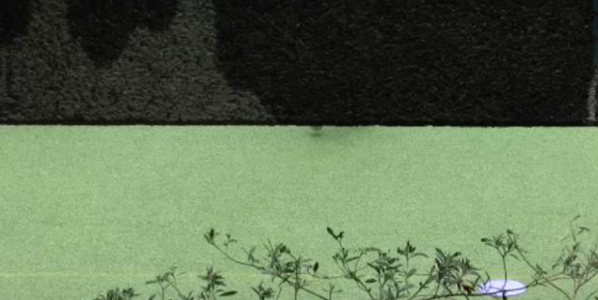
Renseiw – physical poetry, the occlusion, constraint. The careful choice of footage (variety and kind of motion within a narrowish range). Humanism: we don’t see faces, we don’t hear voices, we are amused but we recognise ourselves, youth and age &c.
Sanderson: The music found but could have been composed. The artfulness of placing it just thus. We will never know whether the way it ends with the action, the running off, taking place just after the repose of the final minor chord was deliberated or found. For me this placement implies a universe beyond the letterbox. It has a commonality with the treatment of time in many photographs and paintings – this is an instant, a fragment, but there was a before and an after.
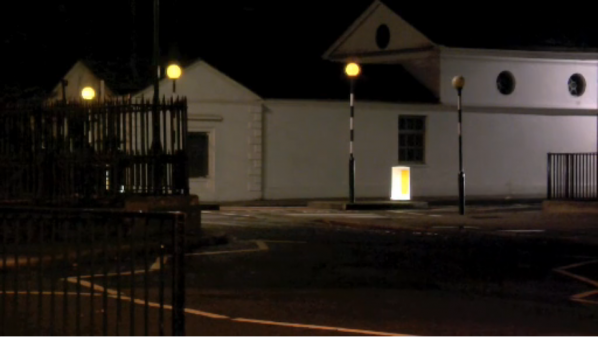
Note that there are four beacons. The sound (a numbers station, one can almost track the archaeology of impulse!) draws on the numbers 0-9, in German. It’s worth noting there is no obvious mathematical mapping between the pattern of the beacons and the numbers but the character in sound of the numbers is close to that of the beacons in light. Suggestion, metonymy.
This forces our attention very strongly on that area of the screen, with the concomitant effect that when we force our attention away it is as if our eyes have been suddenly opened. There is a world out there.
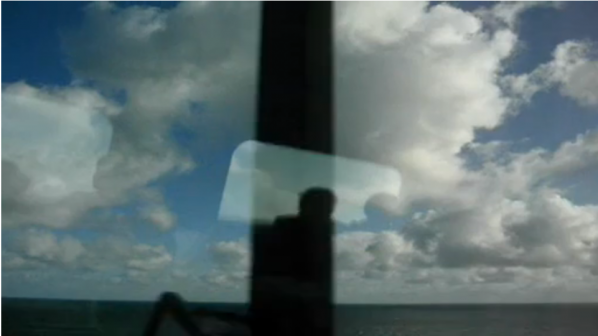
There is a hint of the transcendent in the title – how is this realized? Unless we know Denmark it takes a few moments to realize we are on a train rather than a boat or plane – we are clued into this by the close objects we clearly pass at speed and the reflection of passengers and seating in the windows. One speculates that the sound track is comprised of two elements – one the rhythmic and metallic pulse which somehow rhymes with the passing object (a kind of pseudo-diegesis) and the second an (Open University?) lecture on relativity.
Here, not exactly metonymy but something more fragile, delicate chains of suggestion and subtle resonance. No argument (to see an argument in any of this would be to commit a category error) but a complex and suggestive …um…thing. One should also note that this piece (in both its silent and extended versions) is extremely beautiful.
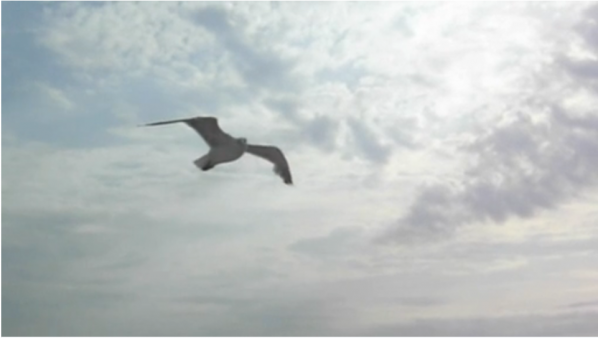
Let’s talk about the sensibility and taste of the makers. Renseiw offers something simple, a kind of tour de force – we perceive it as such although given the fixed camera constraint any virtuosity belongs to the seagull.
A banal seasoning of music would involve simply the seven note modal motif which hails, I’m almost certain, from American popular song of the 70s big country type – Wichita Linesman, you know the sort of thing. (I checked with Sanderson –it’s Bobby Goldsboro’s Summer The First Time) By itself it would be too perfect, too parallel to the floating bird (it seems to give way to a crashing wave sound in its looped form; interestingly the Goldsboro video I found on YouTube begins with a shot of gliding seagulls). With too much parallelism nothing extra arises but Sanderson spices the mixture by the addition of dialogue from what sounds like an American film of the forties or early fifties. It disrupts the idyll but only so as to make us more aware of it. There is a kind of musical V-effekt here (which could have been so badly handled and so isn’t). This is its ‘meaning’ – these things! Here, now!
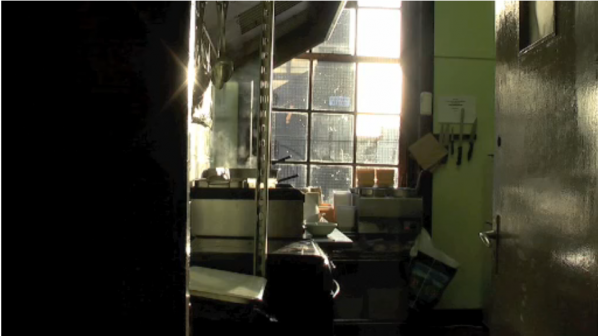
There is something of the dance about this. The music beautifully picks up both the nervous, sudden gestures of the cook but also suggests the process of cooking itself. The music has a funk component. One might say that it cooks.
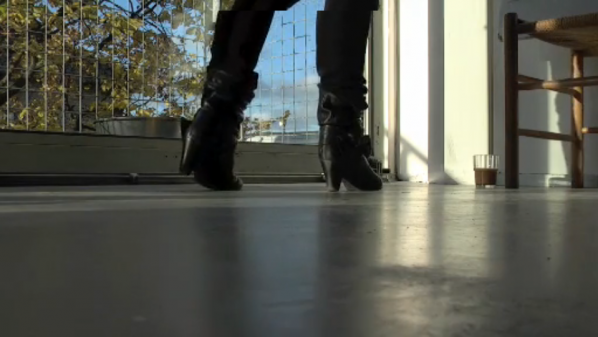
Visually – the low angle, the fragmented view of the body, the person here and not here. The focus on that person which permits and invites its opposite, in particular the framing of the sky and trees. The rhyme between the black-booted two legs of the woman and the black four legs of the dog. Their pas de deux. The music here subordinate, properly so. Ambient sounds, on the one hand, with odd vocal snatches on top. The strangeness doesn’t demand our attention because we are so focused on the visual.

Until the last moments we simply hear a fitting (slightly arch) accompaniment to the skating – we surmise that it is intended to pastiche the kind of accompaniments used in professional skating. At the last moment we realize this is exactly what it is, as the commentator’s voice breaks through. There is also a ‘skate’, ‘friction’ or ‘traveling’ noise which exactly underpins the final move we see, just before the humour of the juxtaposed text, which continues after the movie has gone to black, strikes us: “Delightful, skating of the highest quality” delivered in classic plummy BBC tones…

A hugely rich piece: visually there are a number of layers – the far left street background where distant people and vehicles process. The game of Petanque: – the actual participants (although glimpsed corporeally only twice: fleetingly at the very end and as one set of typical Renseiw-y legs) and the balls themselves (and the metonymic link between these and the planets). Thirdly, the large shadows. (And the apparent size of each of these layers allows for very clear visual interaction). Sound – the ‘light’, jokey, playful music. The University Challenge soundtrack, here unusually clearly cut up – questions – astronomy; replies – painters. A risk for Sanderson, but one that works.

A little detective work indicates the level of detailed truffling about by Sanderson – part of the sound, the text, is grabbed from a YouTube video about French patisseries in London and cut up considerably – in particularly yielding the repeated incantation “cream cakes, tarts, macarons” the latter word in a considerably overheated French accent following the sloaney first three, to deeply comic effect. Comic maybe but, repeated, as in a dream; this mood is reinforced by a rather beautiful waltz time solo piano loop of the opening line of The Associates’ Party Fears Too. Here’s another piece where the visuals, here also dreamy and wistful, set in a looking glass Copenhagen (and the disjuncture between the London-location heavy narrative and the visuals is simply ignored, taken for granted, part of the deal), support quite a complex sound assemblage. Utterly haunting and quite difficult to say exactly why.
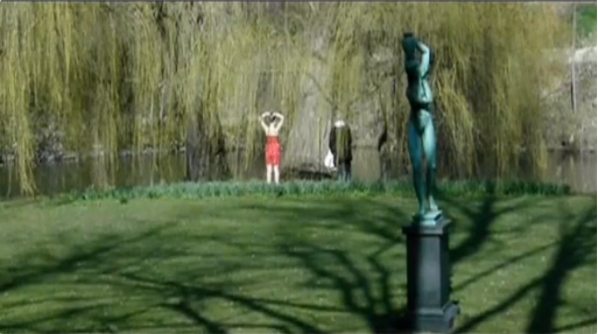
If one didn’t know it wasn’t one would surely assume this was carefully planned, and our knowledge it was not adds to our pleasure in it. Visually the rhyme between the woman and the near foreground statue is perfect – at one point she seems to mirror it exactly. Maybe she knows the area well and there is some unconscious mental echoing…we’ll never know. The other sharp visual pleasure is the smallness of the area of focussed distant activity, which again feels like a sort of directorial chutzpah, except, except…
Sanderson’s contribution is razor-sharp – the pseudo dialogue hits the mark precisely but doesn’t outstay it’s welcome – or at least there’s other stuff going on to detain us, not least the way the model’s preliminary warm-up shimmy becomes a perfect piece of minimal dance when set against the music.
Right of Passage/Speaking Voice
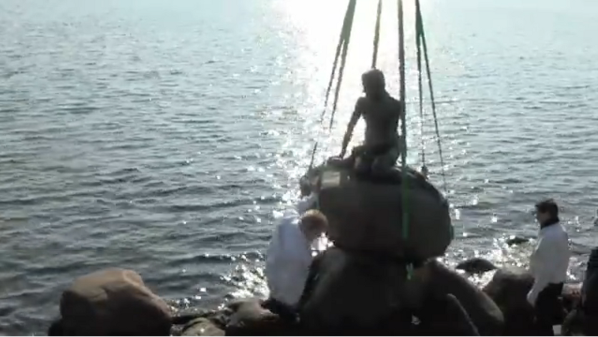
I wonder if when the content has it’s own ‘documentary’ interest, when the filming becomes a case of “Look at this remarkable thing not because of its intrinsic interest but because it happened”, the final result is somehow less engaging?
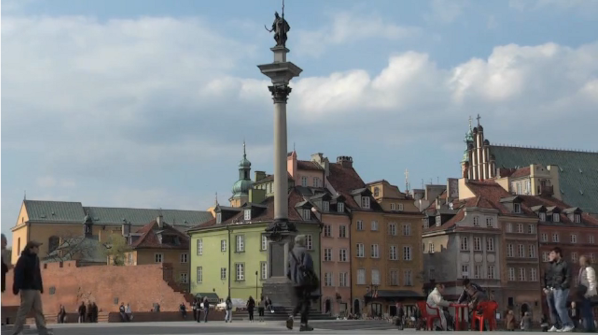
Again a dance related piece – the regular beat of the calling of the numbers one to eight sets up an aural grid against with which the implicit rhythms of the movement in, out and across frame interact in a sophisticated but subtle polyrhythm. Part two of the sound, with actual step instructions, ups the tension and the effect (especially the late entering ‘spinning’ man). Note how often in these pieces the sound fades out slightly later than the visuals, over Renseiw’s titles, thus emphasising its separate existence in an independent channel or dimension.
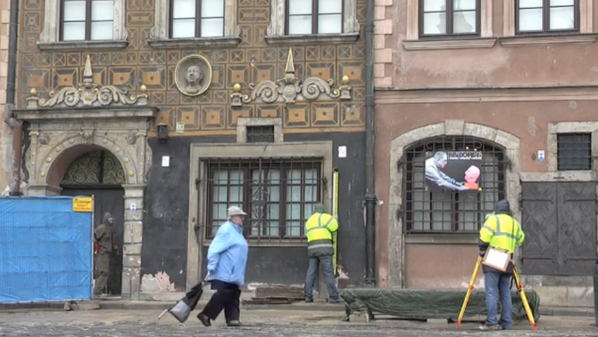
Beautiful found synthesis. Funny. Funny and truthful and touching.
The moving image is packed with incident at both different spatial levels and at different points in the piece. The Portsmouth Sinfonia version of Dance of the Sugar Plum Fairy underpins like a grid, as with Square Dance but in a more complex way, the visual rhythms of the film. Enough coincidence of rhythm to feel planned, enough ‘pull outwards’ to feel open… Again humour… Why does the Portsmouth Sinfonia track, in particular, work so well – atmosphere? the conjuring of a sort of raggedy clockwork ? – can we imagine in its place a more conventional rendering of the Tchaikovsky? Yes, but…
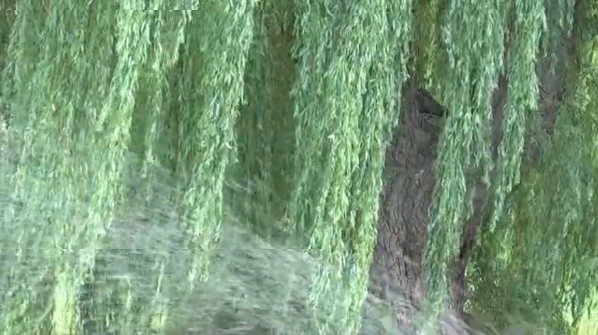
Prime example of Sanderson mind set – metonymy, suggestion – the trees are hair, the water appears exactly on cue (worked? Hmm – the audio appears to be cut to make the word ‘rinsing’ and the water jet coincide)
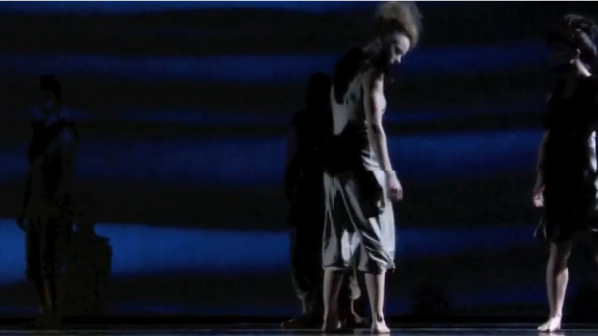
A one liner, but, given its place in the sequence, none the worse for it.
Brass band/Dancers.
*The pieces loosely divide into ones where either sound or vision predominate and some where they have equal roles.
* Not only does dance appear a couple of times explicitly as a subject but the spirit of dance pervades the project.
*The question of the success of individual pieces and of the sequence – a piece that seems less effective in isolation can well form an effective point of relaxation or reflection in the sequence as a whole…
*There are three pieces which, if one ‘re-removed’ the sound, would not strictly be Lumières – Check Out Art Fairs (speeded up), A Beauty Overblown (slowed down) & Sucked In (reversed). Sanderson performed the first two operations for reasons he felt the sound he used demanded. (To which one can only say: yes, this is right, a constraint is there for the sake of art, not art to be constrained.) Sucked In remains a mystery.
*The titles matter (note the re-titling of the composite works). They provide yet another dimension and illumination too.
*The prevailing tone is light, warm and playful. The darker side of life is largely absent, at least explicitly (though there are trails we could pick up to find it). Humour is everywhere. Only a philistine or fool would judge the work as a consequence to be less ambitious, significant or universal.
In September 2012, Italian tactical media artist Salvatore Iaconesi got the diagnosis. He had a glioma (glial cell brain cancer) of approximately 2×3 cm on the surface of his right hemisphere. Upon asking to see all the data relating to his condition, he found that all of the documents, MRI scans, and so on were in obscure not readily used formats. This meant that if one wanted to view the data, you needed specific or corporate software.
What he did then was remarkable. Iaconesi then hacked the formats of the documents and converted them into open-source ones that anyone could read could read with FLOSS (Free Libre Open Source) software. He then created the site, La Cura, where he presented his records as an “open source cure”. People around the world could access his records and then add their recommendations and findings about his condition, cancer, and so on. I begin this interview with Salvatore on September 15, 2012, and the La Cura website already has a rapidly expanding database of information at http://www.artisopensource.net/cure/.
Patrick Lichty: Salvatore, thank you for having this conversation. I remember that it was only a year and a half ago when we were shop-giving copies of the REFF tactical media book from your project, Fake Press in Rome. So, it was a shock when I learned of the glioma the day you launched the site. Could you talk a little about what is on the La Cura site?
Salvatore Iaconesi: Hi Patrick! Yes I do remember, too. And that is also a great explanation on what can be found at La Cura site: it is like one of our “fakes”, except that it is not a fake.
La Cura is about an alternative reality which I want to materialize on this planet, now. In this alternative reality, when someone has a serious disease, life does not end. One can be social, creative, and friendly. Work, art, design, fun and entertainment are possible for diseased people in this alternative reality, just as it is possible to reach out to find cures in any philosophy, time, strategy, culture or way one wishes. And consider that even technologies in this alternative reality are designed to enable and facilitate all this, actively promoting the freedom and autonomy of people.But, sadly, life is not like this alternative reality.
I wanted it to be my alternative reality, so I just did everything it took to bring that reality into the world. It’s like when you make an Augmented Reality application: you do a series of things to “materialize” some other things into ordinary reality. And then you have them, right there. So, La Cura is my personal Augmented Reality, in which, if I want to, I have all the tools and information I need to find a “cure” for my disease in one of multiple ways and strategies, which are medical, cultural, technological, emotional, artistic, political etc.
To achieve this, I have had to go through a series of obstacles:
The first is connected to language and information, as the first thing you notice at the hospital is that they are not really talking to you. Medical language is difficult and complex, and they rarely take action to make things more understandable to you. One of the testimonies I received in La Cura was that of a lady who has found herself in front of a doctor shouting at her: “You really think that I will explain to you why your thyroid has to be removed? It has to be removed! That’s it!”
This is really not “open”, in any sense. And, in more than one way, it is an explicit evidence of the approach which medicine has towards patients: they cease to be “humans” and become sets of parameters on a medical record subject to certain protocols and standards. When you are in the hospital, it’s often as if you’re not there. The only thing that matters is your data: blood pressure, heartbeat, magnetic resonance etc.
And the way in which information reflects this if handled in this context. Data formats may be, technically “open”, meaning that they are described somewhere but they’re really an explicit reflection that when you’re sick you “step out of society”. That data is usable and accessible only to “professionals” and to those people who have tools and skills to handle them.

I, as someone with considerable expertise with computers, have had some difficulties in opening them. Imagine someone else with less skill! Most people would not have been able to benefit from all the types of “cure” which I am currently accessing from a variety of sources and modalities. They would not have access to a “cure” that doesn’t end at a list of medicines and dosages, but spreads out into society.
To do that, I have had to hack into the information and convert it into really “open” data, using multiple formats that could be used by many kinds of people to do multiple things. In the format that the data was originally in, even if it was “technically open”, that data would have been seen only by “professional doctors” and, instead of being a “human being”, I would only have been a “patient”, or worse yet, a “case”.
PL: What do you want people to do with the information?
SI: Whatever they wish! Obviously! What is important in this case is that we must agree on what the “information” is… What I am publishing is my autonomous will to disclose my state of disease, including all data and medical information. I have my own purposes for this, but it does not necessarily mean that this purpose must/should be shared by others.
My personal purpose for this disclosure is to autonomously shape my own human condition. I have a disease but I am not a “diseased person”. I am a person. And, as such, I wish to create my personal “cure”, which has to do with my life, not with my disease. For what people know, I might even consider cancer as not being a “disease” at all! I might, for example, consider it an expression of the “cure”, such as if I adhered to Hamer’s theories. Which I don’t, or, at least, not in the sense that “I believe” in Hamer’s theories; I take them into consideration, but I don’t believe in them, just as I don’t believe in chemotherapy, in Aloe Vera, in Caisse Formula, in surgery, in shamanism, in healers, oncology or in any of these things. I take all of them into serious consideration, just as I seriously consider certain philosophies that say that we are made of energy, energy creates matter, and cancer is “matter” and so on. Therefore, cancer must be created by energy in some form. And so it could possibly be that I created cancer myself in a way or another.

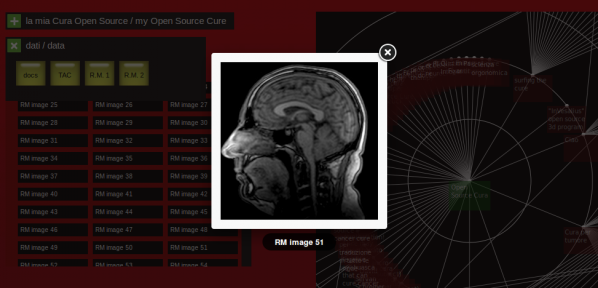
So in this sense, I think it is very important to be able to easily look at the images of my cancer and to say “hello” to them. It is important to turn them upside down, to edit them with GIMP, to make mosaics out of them, to speak to them, asking “hello?” What are you doing in there? Did I do something to cause you? Can I change something to make you/myself feel better?”
Both scientific and traditional evidence shows that art, positive emotions, laughter, reduced stress, and a good social life have great practical benefits to the human body, I want to seriously consider that part of my cure could be formed by receiving an image of my brain with a smiley face drawn across it over the tumor, or a picture of a friend of mine, or a video of a projection mapping done with Processing in which the images of my cancer cover a whole facade of a building.
And since I don’t want to believe, but I want to take all of these things into serious consideration, I cannot focus only on the “medical” approach (and the related information, and its formats). I need to access all of my information in multiple ways, and I wish that everyone could do the same (as, from my point of view, it’s part of my Cure). And, even if “technically open”, the format in which my medical records have been disclosed is not enough, because it is “open for professionals” and so the only thing I could do with it would be “show it to professionals”, missing out on all the other wonderful parts of the “cure” which are available in the world.
This for me, is an interesting starting point to think about what things such as “OpenData” could mean. This is far beyond the idea that some government can some data according to ways in which some “professionals” could grab it and, do something like make a visualization or an App out of them. Who knows? In this sense, instead, we would not be talking about “technology”, we would be talking about “humanity”.
In the end, this is exactly what I’d like people to do with the “information”. I want the world to take the fact that I decided to disclose the fact that I have a disease and that I want to actively search for a cure for from all of these perspectives. In the meantime, I want to reconsider what it means to be “diseased” in current times and what new conceptions of the word “cure”, “medicine” associated with my condition could mean.

PL: What has happened since you launched the La Cura site?
SI: Lots of things. People are contributing and participating in multiple ways. There are testimonies, art, poetry, suggestions, videos, performances. Many doctors have called in to propose their methodologies and technologies. I have had very interesting and profound discussions with people who are prepared to deal with very complex things every day of their lives. I’ve communicated with doctors who are perfectly open to the possibility of such a paradigm change for the word “cure”. Artists, designers, activists, are giving me wonderful parts of “cure”. Many “patients”, “ex-patients”, “relatives” and “friends” of “diseased people” are sharing their experiences, are opening discussions, are sharing the information I found on possible medical cures. And so many people want to talk to someone in new and different ways, becoming again, simply, humans. Journalists from all kinds of media have started to ask for interviews, texts and videos. We stopped that after a while, as we don’t wish to turn this into merely a “spectacle”. We only keep on working on this with journalists which we know we can trust and which we know will not transform what we say to produce their news.
PL: For your information, I had an MRI in 2009 here in the States, due to my doctors’ concerns of something similar (nothing was found), but when I asked for the data, I got a CD full of JPEG images. Were you surprised when you found out your records were in particular formats?
SI: They were not really in a proprietary format. Let’s call them “exotic formats for professionals”. And yes, I would have expected something which I could have shared easily (such as your JPEG images, and maybe some meta-data in some easy to use format such as XML, or even a spreadsheet). But this was a sort of paradox: an “open” format which is really hard to open and to use for something else other than putting the CD in an envelope and (snail)mailing to the next doctor.
PL: What do you think the line is between privacy and data oppression? Would that be when the patient is denied access to their rights to access the information and distribute it as they wish?
SI: We should all know this by now. Privacy is not a problem unless the “system” is made by lousy people. We have tools to protect ourselves and to promote ourselves, and these tools are dangerous only when who runs them is a lousy person. Privacy protection arises through education (understanding what is privacy and when/where/how/why would I want to protect it) and through the acquisition of decent ethics from the people and organizations which run the entire infrastructure through which all our digital data goes through. And obviously, and most importantly, our ethics is created by helping each other out in a P2P way, teaching each other what we know, what we discover and how we decided to handle it when we found out.
There is no single line between privacy and data oppression. Not one which everyone would agree on. We have the tools for each one of us to tune this line to our own wishes, according to what we want to do, what are our desires, what are our objectives etc. We “just” need more places (physical, digital, virtual, institutional, occasional…) in which to discuss and share our points of view, as every time this happens, many things are learned on all sides.
PL: Do you consider your site a form of radical tactical media intervention?
SI: I can now say “I have a radical tactical media intervention in my head”. Cancer is the new Black. The Cancer is the Message. And we could go on. I don’t know. I guess I could call it that. I also guess I could call it a performance. I guess I could call it life. I guess I could call it hacking or whatever. I will just call it La Cura.
PL: What has been the most inspirational information, art, or otherwise that has resulted from the launching of the La Cura site?
SI: The most enlightening thing that happened is the experience of talking about the same exact thing using dozens of different languages. I have spoken with neurosurgeons, shamans, nutritionists, pranotherapists, doctors, activists, macrobiotics, hippies, cyberpunks, punks, friends, relatives. Most of the time, I received incredibly good advice. When you look at that advice from different points of view, you start to understand that you are really talking about the same thing, but in different languages.
For example, two of the most important things which you deal with when you talk about cancer are the idea of creating alkaline environments in your body (because cancer cells cannot stand them) and the facts that anti-oxidants are a great tool in support of any type of therapy (because of the molecular reactions which are at the base of cancer).
Well, speaking of just these two, it occurred to me that multiple theories deal exactly with these two concepts. I have had an esoteric master describe my cancer as an invisible living being, and he suggested to drive it away using sulfur and Rosa Rubiginosa oil, in ways which turn them into two incredible anti-oxidants and creators of alkaline environments as well as powerful stimulants of the immune system. I have also spoken with nutritionists and macrobiotics communities and learned about their instructions on choosing food, cooking and eating, many of which are directed exactly to that: anti-oxidants and creating alkaline environments, but through food.
And when an oncologist explained us his therapy, that’s exactly what it was about: powerful anti-oxidants and alkaline environments. And on, and on and on. Aloe Vera, Caisse formula, fungus theory, chemiotherapy, Di Bella method, potassium ascorbate, ketogenic diets, etc: all highlight cancer cells in some way; create an environment around them which is as alkaline as possible; anti-oxidate them; activate the immune system as powerfully as possible so that the highlighted weakened, cancer cells can be more easily “convinced” at mutating back to a decent form or to commit suicide with the help of the immune system. Realizing this is an enlightening experience: it spans across thousands of years and also helps you make some choices (things stand out when they speak about different things!).
Everything else that is going on in La Cura is wonderful, but having realized this fact is just incredible and fascinating. You start imagining about all the other things we discuss about in our daily lives using multiple languages (energy, politics, emotions…) and start to wonder what would happen if you turned on this shared, P2P modality in those cases as well.
PL: How do you hope that others will benefit from the conversation that you are starting through La Cura?
SI: I don’t “hope” anything. I did this because I felt I needed to. When one talks about “revolution” dialogues start arriving at the point when one says, “Let’s burn everything down!” “Let’s destroy everything!” and so on.
We know we can’t do it. We can’t “destroy everything”. It’s not possible. What we can do is to create a reality as if everything already happened – as if the “revolution” already happened, as if the world had been burned down already, and rebuilt, just the way you like it. We can live life like this. It is a bit more than “seeing things”. But you do Augmented Reality, Patrick. You know what I mean. It’s a bit more than “writing”, it’s about creating worlds.
PL: As of this interview, what is the prognosis of your condition?
SI: Depends on what perspective you look at it from. From the medical point of view I have a low-grade glioma at intensity which is still undecided, between 1 and 2 (we will have to wait an histologic exam to know for sure). From the human point of view: I am fine! I have no apparent symptoms. I just need to be careful because if I find myself in stressful situations I could react by having an epileptic shock. So it is not advised that I drive or things like that. It’s the perfect excuse! 🙂
PL: Don’t you think it’s funny that the abbreviation for your name is “si”?
SI: Sì! Obviously 🙂
“Tweets in Space beams Twitter discussions from participants worldwide towards GJ667Cc – an exoplanet 22 light years away that might support extraterrestrial life. By engaging the millions of voices in the Twitterverse and dispatching them into the larger Universe, Tweets in Space activates a potent conversation about communication and life that traverses beyond our borders or understanding.”
Marc Garrett: Could you explain to our readers what ‘Tweets In Space’ is?
Scott Kildall and Nathaniel Stern: Tweets in Space is an art project — a networked performance event — which beams your Twitter messages to a nearby exoplanet that might support human-like, biological life. Anyone with an Internet connection can Tweet with the hashtag #tweetsinspace during the performance time, and their messages will be included in our shotgun blast to the stars. The performance is on September 21st, 20:30 – 21:00 Mountain Time (3:30 AM BST / London time).
MG: What was the motivation behind your current collaboration?
SK and NS: We found inspiration from various sources. First, in NASA’s Kepler mission, whose purpose is to discover planets in the “habitable” or “Goldilocks” zone. The project has found over 2000 exoplanets thus far, all of which are “not too hot, not too cold, but just right” for life as we know it. Scientists now estimate that there are at least 500 million planets like this in the Milky Way alone. Our conclusion: extraterrestrial life is almost certainly out there.
![The newly discovered planet is depicted in this artist's conception, showing the host star as part of a triple-star system. Image credit: Carnegie Institution / UCSC. [1]](http://www.furtherfield.org/wp-content/uploads/2012/09/planet_gj667cc.jpg)
“The latest discovery is at least 4.5 times bigger in size than Earth. Reportedly, the planet exists 22 lightyears away from Earth and it orbits its star every 28 days. The planet is known to lie, in what is being referred to as the star’s habitable zone. A habitable zone is a place where the existing conditions are just perfect for life sustenance. Astronomers, according to this report also suspect that the GJ667Cc may have been made out of earth-like rock, instead of gas.” [ibid]
Another source of great inspiration is how we use social media here on Earth. This is our second, large-scale, Internet-initiated collaboration. In 2009, we amplified the power structures and personalities on Wikipedia, and questioned how knowledge is formed on the world’s most-often used encyclopedia – and thus the web and world at large. Now, we are turning to the zeitgeist of information and ideas, feelings and facts, news and tidbits, on Twitter. The project focuses on and magnifies the supposed shallowness of 140-character messages, alongside the potential depth of all of them – what we say in online conversation, as a people.
We are directing our gaze, or rather tweets, via a high-powered radio telescope, towards GJ667Cc – one of the top candidates for alien life. It is part of a triple-star system, has a mass that is about 4 times that of Earth, and orbits a dwarf star at close range. GJ667Cc most certainly has liquid water, an essential component for the kind of life found on our own planet.
MG: Right from its early years when Jagadish Chandra Bose [2], pioneered the investigation of radio and microwave optics – science, technology and art have had strong crossovers. And it might be worth mentioning here that Bose was not only well versed as a physicist, biologist, botanist and archaeologist, he was also an early writer of science fiction. [3] Which, brings us back to ‘Tweets In Space’, wherein lies themes relating to science fiction, radio broadcasting (commercial, independent and pirate), wireless technology of the everyday via our computers, and ‘of course’ the Internet.
![J.C. Bose at the Royal Institution, London, 1897.[3]](http://www.furtherfield.org/wp-content/uploads/2012/09/JC-Bose-at-the-Royal-Institution-London-with-his-radio-equipment-The-date-is-1897.png)
But, what I want to pin down here is, where do you feel you fit in historically and artistically with other past and contemporary artists, whose creative art works also involved explorations through electromagnetic waves?
Scot Kildall: The work of JC Bose is incredible and what strikes me is that he eschewed the single-inventor capitalist lifestyle in favor of his own experiments. Isn’t this the narrative that artists (often) take and linked back in many ways to the open-source/sharing movement, rather than the litigious patent-based corporation? And it mirrors in many ways the reception of electromagnetic radiation as well. You can’t really “own” the airwaves. Anyone who is listening can pick up the signal. This comes back, as you point out, to the internet. Twitter is now, one of the vehicles, and, ironically entirely owned by a benevolent* corporation.
Nathaniel Stern: (Agreeing with Scott) and we can’t forget of course Nam June Paik, who played with naturally occurring and non-signal based electromagnetic fields to interfere with analogical signals (as well as the actual hardware) of tube televisions, and more. And of course, there have been other transmission artists, explored in depth by free103point9, among others. I think, like them and others, we are messing with the media, amplifying (figuratively and metaphorically) and intervening, pushing the boundaries of DIY and cultural ethico-aesthetic questions…
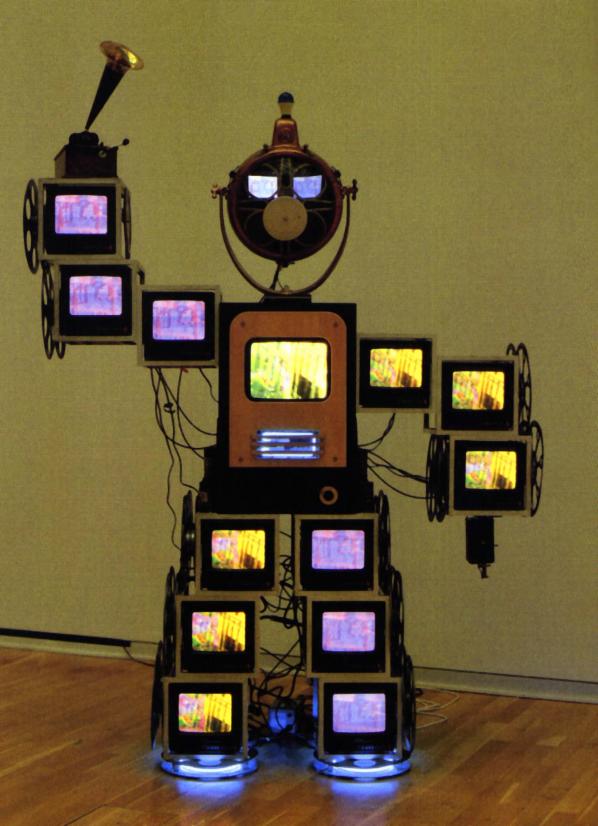
MG: What is especially interesting is that all the tweets submitted by the public are unfiltered. How important is it to you that people’s own messages are not censored when going into space?
SK and NS: Absolutely. Tweets in Space is by no means the first project to transmit cosmic messages with METI technologies (Messaging to Extraterrestrial Intelligence). Our fellow earthlings have sent songs by the Beatles, photos of ourselves shopping at supermarkets, images of national flags, and even a gold record inscribed with human forms – controversially, where the man has genitals and the woman doesn’t. These slices of hand-picked content exhibit what a select few believe to be important, but ignore, or willfully exclude, our varied and collective modes of thinking and being.
Tweets in Space is “one small step” with alien communications, in that it is open to anyone with an Internet connection. It thus represents millions of voices rather than a self-selected few. More than that, our project is a dialog. There have been, very recently, a small number of projects that similarly “democratize the universe” but none are like ours: uncurated, unmediated thoughts and responses from a cooperative public. We can speak, rebut, and conclude, and nothing is left out. Our transmission will contain the good, the bad, and the provocative, the proclamations, the responses, and the commentary, together, a “giant leap” for all of humankind – as well as our soon-to-be friends.
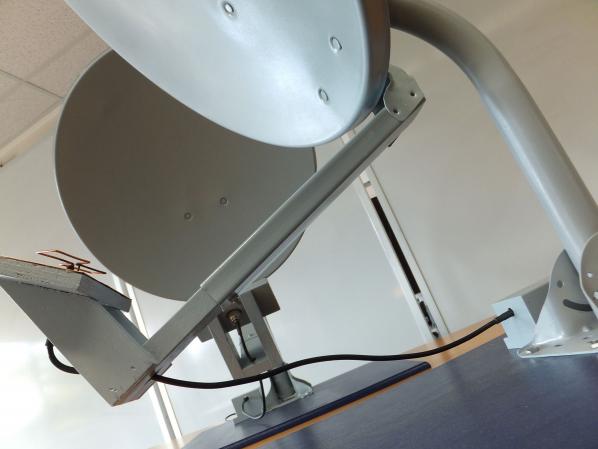
Furthermore, by limiting the event to a small window of only 30 minutes, we are encouraging all our participants to speak then respond, conversing with one another in real-time, through networked space. We are not just sending lone tweets, but beaming a part of the entire dialogical Twitterverse, as it creates and amplifies meaning. Tweets in Space is more than a “public performance” – it “performs a public.”
MG: Now, you will be transmitting real-time tweets toward the exoplanet GJ667Cc, which is 22 light-years away. How long will it all take to get there?
SK and NS: Well, first off, we’re collecting all of the tweets in real time, but only sending them out later in October. The main reason for this is that we have to wait for the planets to align – literally. We want line of sight with GJ667Cc from where our dish is. The added bonus of time, however, is that this will allow us to really flesh out how we send the messages in a bundle. We want to include a kind of Rosetta Stone, where we will not only send binary ASCII codes of text in our signal, but also analog images of the text itself. We additionally intend to choose the most frequently used nouns in all the tweets from our database, then give a kind of “key” for each. If “dog” is common, for example, we can transmit: 1. an analog image of a dog, like a composite signal from a VCR; 2. a text image of the word “dog” in the same format; and 3. the binary ASCII code for the word dog.
In terms of time/distance, when speaking in light years, these are the same thing. A light year is the distance light can travel in one year of Earth time (about 9.4605284 × 10 to the 15 meters). Since radio travels at the speed of light, a big dish on GJ667Cc will pick up the signal in 22 years. We should start listening for a response in 44 – though it may take them a while to get back to us…
MG: Will the code used for the project be open source, and if so, when and where can people expect to use it?
SK and NS: Yes it is! The most useful part of our code is the #collector, which saves real-time tweets to a database, that can then be used for live projections or web sites, or accessed and sorted later via all kinds of info. The problem is that it’s not really user friendly or out of the box – folks need a suped up server (VPN), and to plug into a few other open source wares. The main portion of the backend we used is actually already available at 140dev.com, and then we plugged that into Drupal, among other things. For now, we’re telling interested parties to contact our coder, Chris Butzen, if they want to use our implementation. And we hope to do public distribution on tweetsinspace.org if we are able to package it in a more usable format in the next 6 months.
MG: Are there any messages collected so far, grabbing your attention?
We’ve had thousands of tweets so far – even while just testing the ware in preparation for the performance. We’re anticipating a lot of participation! The tweets we’ve seen have ranged from variations on “hello [other] world” and “don’t eat us,” to political activism and negative commentary, to a whole surreal narrative of about 30 tweets per day over the last 3 months.
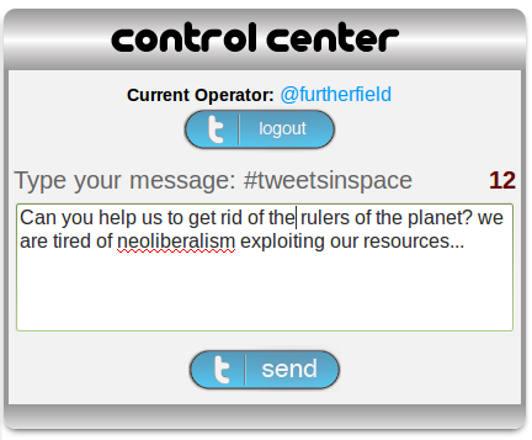
go to tweet aliens to add your own words…
Some of our favorite tweets have been those that question how to make our own world better. These speak to both the hope of space age-ike technology, as well as the hope in collective dialog – both of which our project tries to amplify. Such tweeters ask about the alien planet’s renewable energy sources, tax structures, education, art, and more.
We imagine the 30-minute performance will see a much more potent discussion about such things, and hope your readers will participate. The final transmission will be archived permanently on our site once we’ve prepared it for launch.
As part of the International Symposium on Electronic Art in New Mexico (ISEA2012). We will collect your tweets and transmit them into deep space via a high-powered radio messaging system. Our soon-to-be alien friends might receive unmediated thoughts and responses about politics, philosophy, pop culture, dinner, dancing cats and everything in between. By engaging the millions of voices in the Twitterverse and dispatching them into the larger Universe, Tweets in Space activates a potent conversation about communication and life that traverses beyond our borders or understanding. http://tweetsinspace.org/
AND THEY WILL BE SENT INTO DEEP SPACE!!!
Watch the stream LIVE here – http://tweetaliens.org/tweets/tweets.php
So ArtForum have launched a special September issue investigating the, lets say broader, relationship between new media, technology and visual art.*
Of worthy mention is the essay Digital Divide by the art world’s antagonistic critic of choice Claire Bishop, a writer whom a little under 8 years ago, deservedly poured critical scorn over the happy-go-lucky, merry-go-round creative malaise that was Bourriaud’s Relational Aesthetics and all of the proponents involved. Since then Bishop’s critical eye has focused on the acute political antagonistic relationships, within the dominant paradigms of participatory art and the concomitant authenticity of the social.
In Digital Divide, Bishop asks a different question, and its delivered even more bluntly than usual. Why has the mainstream art world, for the most part, refrained from directly responding to the ‘endlessly disposable, rapidly mutable ephemera of the virtual age and its impact on our consumption of relationships, images and communication.‘ This is not to say the practices of mainstream artists do not rely on digital media (in almost all cases, it now cannot function without it), but why hasn’t the shifting sands of digital culture been made explicit? In Bishop’s words;
“[H]ow many really confront the question of what it means to think, see, and filter affect through the digital? How many thematize this, or reflect deeply on how we experience, and are altered by, the digitization of our existence?”
Clearly, there are exceptions and she mentions three examples by art stars Frances Stark, Thomas Hirschhorn and Ryan Trecartin which flirt here and there with digital thematisation. Conversely artists who once specialised in digital art, Cory Arcangel, Miltos Manetas – to name two very famous examples – have previously broken out into the mainstream.
But for Bishop, there is of course, “an entire sphere of “new media” art, but this is a specialised field of its own: It rarely overlaps with the mainstream art world (commercial galleries, the Turner Prize, national pavilions at Venice)” – (one could add art fairs here). But nonetheless “these exceptions just point up the rule“. Bishop’s focus is on the mainstream and, moreover, she contends that “the digital is, on a deep level, the shaping condition—even the structuring paradox—that determines artistic decisions to work with certain formats and media. Its subterranean presence is comparable to the rise of television as the backdrop to art of the 1960s.” True enough, this structuring paradox is an implicit problem with the mainstream art world, but thats not the problem tout court.
From the responses I’ve read both in the article comments and in subsequent blog posts, a particular issue has been marked with Bishop’s statement that “new media” art is a specialised field. Whilst it doesn’t qualify as a dismissal, one could certainly suggest that Bishop is partly guilty of the same disavowal she throws at the mainstream art world when she relegates this sphere as an ‘exception’. In a blog-post response, Kyle Chayka makes a similar point; “Bishop understands that digital technology forms a seedbed for art as well as life, but fails to uncover the artists who are already critiquing that context.” I’m not a Lacanian, but maybe this is a symptom of something.
If mainstream art is ‘the rule’, (and I’m insinuating ‘the rule’ as anti-metaphor here) perhaps ‘the rule’ isn’t worth paying attention to, considering that the new media art exception is too much of a ‘specialisation’. In as much as one can only agree with Bishop’s call for mainstream art’s negotiation with digital thematisation, has she not missed the same aesthetic questions already posed and re-composed in this exceptional sphere? Why should the qualifier of the mainstream be such a factor of importance here? Why not cut off the need to reconcile digital thematisation with a set of historical, and commercially ideological principles which may not take kindly to the more ambitious and darker questions that the social and political arena of global digitalisation have thrown up. This is not to say that Bishop isn’t seeking those questions nor does she wish to reconcile those principles, but the specialised sphere of ‘new media art’ may quench the questions she herself raises.
Case in point: all Bishop would have needed to reference is something like the Dark Drives exhibition for the transmediale festival earlier this year; the tag line “uneasy energies in Technological Times” sums up her main descriptions of a digital epoch quite nicely. For instance, the artist group Art 404’s 5 Million Dollars 1 Terabyte, renders explicit one subset of the absurd, copyright, exploitative logic of proprietary software, by saving one terabyte’s worth of unlicensed software onto a single hard drive. Next to it was JK Keller’s idiosyncratic piece Realigning My Thoughts on Jasper Johns, which showed off a glitchy, abstract bastardisation of a Simpson’s episode Mom and Pop Art – regurgitating haggard mainstream perspectives. Crucially the success of the show was down to the implicitness of the exhibition’s technical triumphs – where technical jargon is often touted as a reason for the mainstream’s averted gaze. Whilst the viewer didn’t need to know the technics, but a richer understanding emerged should they have wanted to know.
There isn’t any need to clog up this article with a bottomless plethora of pieces from other equally important exhibtions and shows (I’m sure many others are better qualified in doing so); my point here, is that Bishop cannot relegate new media art as an exception to the rule, when the digitalisation of media is becoming the rule, which she herself explicitly admits. Choosing to focus on the failure of the mainstream in this arena gives the essay a healthy line of questioning, but in relegating an entire sphere which has – for some time – repeatedly dealt with these questions and more, it raises what is effectively a pointless query. To be fair to Bishop, she isn’t trying to force a fecund translation of new media with mainstream values, but looking for methods where digitalisation can instigate the change of those values.
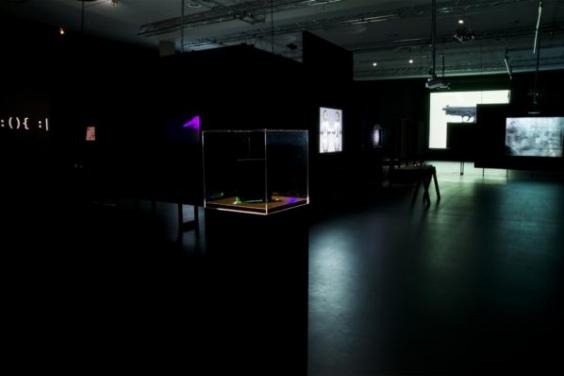
Granted, Dark Drives is one major show in a major Berlin new media festival – the top of a very extensive collection of disparate voices and influences – but it inadvertently highlights a salient thought. What if Bishop’s call to bridge the ‘Digital Divide’ was actually met by a new generation of artists thrust into the mainstream, where digital themes were translated into its own methods of commercial production? We’ve gotten over the myth that ‘virtual’ commodities are unmarketable, so it’s not as if I’m being negative for the sake of it. Where would this leave festivals like transmediale, or not-for-profit collectives like Furtherfield – how would they respond? It’s an uneasy question, one which for speculative purposes cannot be answered quickly at present, if at all.
In the throws of conjecture, there is perhaps another division at play here. Towards the end of her essay, Bishop makes a reference to the difference between the non-existent embrace of the digital medium today, and the rapid embrace of photography, film and video in the 60s and 70s.
“These formats, however, were image-based, and their relevance and challenge to visual art were self-evident. The digital, by contrast, is code, inherently alien to human perception. It is, at base, a linguistic model. Convert any .jpg file to .txt and you will find its ingredients: a garbled recipe of numbers and letters, meaningless to the average viewer. Is there a sense of fear underlying visual art’s disavowal of new media?”
This is a division which is even more striking; more aesthetically and philosophically significant in comparison to marketable rules and unmarketable exceptions. I think Bishop is really on to something when she chastises the hybrid solutions of old media nostalgia, evidently favoured by the market and contrasts it to the alien nature of code, but it’s not without problems.
Some may consider there to be nothing inherently alien about digital media; many artists, who also work as programmers and write, design and engineer artworks together with code without any recourse to an alien nature (however I vehemently disagree with the notion that code be solely reduced to human production, but it must be pointed out) Likewise, any 90s utopian reading of the ‘digital revolution’ is mired from the start, once you take into consideration, closed proprietary devices and services which falsify other meaningful alternatives (one only needs to trace the important work of the Telekommunisten art collective to realise how advanced these questions are, in what is supposed to be a specialised field).
If there is a fear underlying visual art’s disavowal of digitalisation, it’s not just a critical bemusement of code, but of the material which composes computational media; wires, LCD screens, motherboards, caches, firmware, sorting algorithms. Bishop’s call for mainstream contemporary art to be aware of its own conditions and circumstance is admirable, but unless art can actually get its hands dirty with the material processes of new media and more importantly the underlying computational conditions concerning the digital (because thats what it is), the project of explaining these circumstances will be quagmired from the start. It’s not enough to explain ‘our changing experience’ with computation, but to explain the experience of computation in itself.
But for now, lets keep the divide going, not least because antagonisms are fun (Bishop should know), but because the contemporary digital arts are not hindered with the burden of seeking the mainstream’s attention. They can get away with a lot more as a result. Digital or Computational art needs to be cheaper and nastier, as the artist’s tools of use are getting increasingly dirty with critical engagement and proflierfation of code (one cannot avoid mentioning Julian Oliver et al’s important project of critical engineering in this sense). Only then, can Bishop speak of a moment, where the “treasured assumptions” of mainstream art are brought to bear through the criticality of the digital.
——————
* Just to make it clear, I am aware that key terms in this article such as ‘new media’ ‘digitisation’, etc carry little to no relevance anymore, (I prefer computational to be more relevant myself), and they’re only used as a replying dialogue with Claire Bishop’s essay which relies on them throughout.
Charlie Gere is a Media Theory and History professor in the Lancaster Institute for Contemporary Arts, Lancaster University. Co-curator of FutureEverybody, the 2012 FutureEverything exhibition in Manchester. In 2007 he co-curated Feedback, a major exhibition on art responsive to instructions, input, or its environment, in Gijon, Northern Spain. He has given talks at many major arts institutions, including the Centre de Cultura Contemporània de Barcelona, the Architectural League in New York, Tate Britain, and Tate Modern. Gere’s new book, Community without Community in Digital Culture (Palgrave MacMillan, 2012), is out now.
Previous titles include: Digital Culture (Reaktion Books, 2002), Art, Time and Technology (Berg, 2006), Non-relational Aesthetics, with Michael Corris (Artwords, 2009). Gere was co-editor of White Heat Cold Logic (MIT Press, 2009), and Art Practice in a Digital Culture (Ashgate, 2010), as well as writing many papers on questions of technology, media and art. He is also co-editing with Robin Boast an anthology entitled Allegories of the Information Age (forthcoming).
Marc Garrett: Digital Culture was originally published in 2002, which happens to be the version I’ve had all these years. In 2008 it was republished, revised and expanded. Now the book has an extra chapter ‘Digital Culture in the Twenty-first Century’. Of course, we already know that digital technology and society has changed dramatically since 2002. So, what themes and historical contexts did you choose, as necessary to include in this new and last chapter?
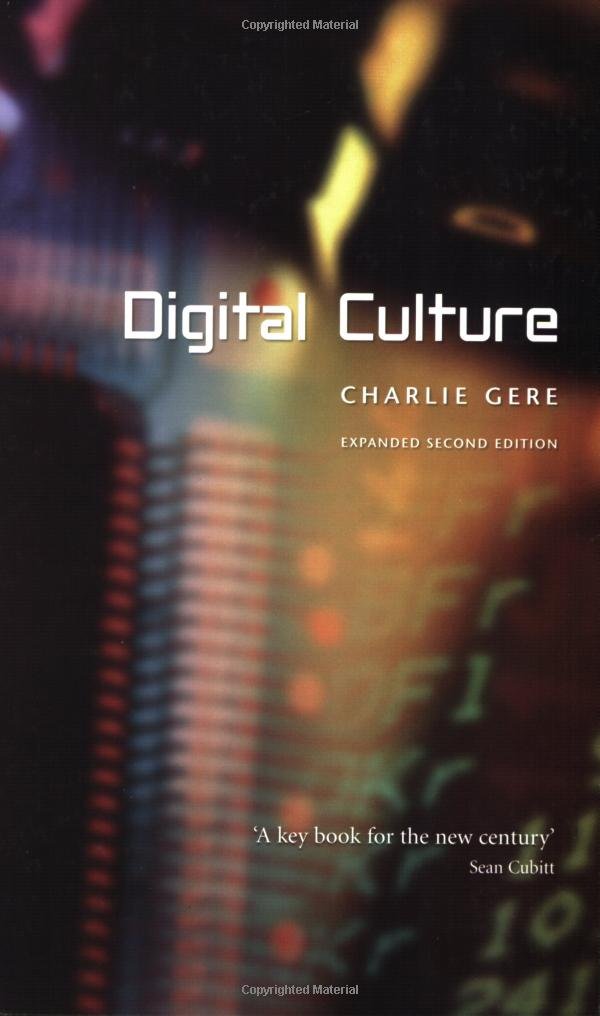
Charlie Gere: What happened after the first edition’s publication was of course, the rise of so-called Web 2:0, which was simply the greater exploitation of the reciprocal possibilities of the Web. I tried to reflect on how this reciprocity was visible beyond the Web itself and was becoming part of a more general culture of engagement and exchange, not that I share some of the more utopian visions of this phenomenon. Indeed, in my new book Community without Community in Digital Culture, I try to counter the, for me, more naive visions of community in relation to digital technology. I advocate a more ‘non-relational’ approach that does not deny the transformative effects of new media in terms of community but thinks of it more in terms of hospitality to the other.
MG: Many of the artists we have worked with are using new media to explore and critique the utopian assumptions you discuss: YOHA, IOCOSE, Liz Sterry, M.I.G (Men In Grey, Julian Oliver and Danja Vasiliev), Heath Bunting, Face to facebook (Paolo Cirio and Alessandro Ludovico), Annie Abrahams and more. Each of them work in a deeply relational way to intervene in the mythologies projected about digital technology; and, with a knowingly crtical eye of the technical limitations and the social controls at work when using networked technology. At different levels, all are producing work that ‘consciously’ incoporate relational contexts, in some way or another, this includes ideas and approaches with autonomy as part of their art, but not necessarily advocating technology as a singular, saving grace.
How do you view the role of this practice in the context of the wider corporate and state impact on the way technical cultures are evolving. How do you see the notion of hospitality working between the arts and these other more mainstream cultures?
CG: I greatly admire and like the work of the artists you mention and others doing similar things. For me they exemplify the complexity of the idea of hospitality. In general the Web is about exchange, whether that of money for goods, social links and relational exchanges in social networks, or the exchange of speech and dialogue in on-line fora. The work of these artists refuses this demand for exchange and profit within a restricted economy. Thus they are in a sense parasitical on the Web. The word ‘parasite’ comes from ‘para sitos’, meaning ‘beside the grain’, and refers to those animals that take advantage of grain stores to feed. They are the creatures to who must be offered hospitality, as a gift, without expectation of return, which means that while they are bound up with the technological systems that comprise the Web, they are not part of the restricted economy of exchange, profit, and return that is at the heart of capitalism, and to which everything else ends up being subordinated and subsumed. Thus they find an enclave away from total subsumption not outside of the market, but at its technical core.
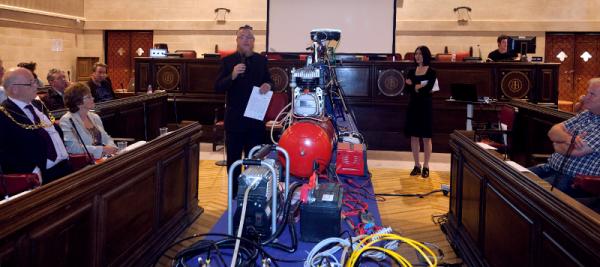
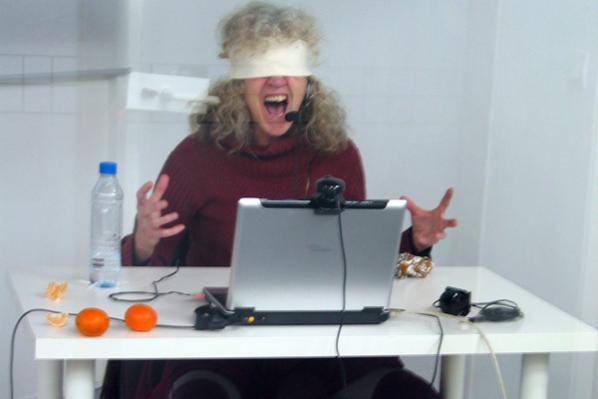
MG: Many are aware that technology and digital culture have changed the world we live in and appreciate their immediate effects on our everyday behaviours and situations. But there is a bigger story to tell, and history can offer us insightful glimpses, important clues and ways into this story about our relationship with technology and digital culture. One of the arguments outlined in your book ‘Digital Culture’ is that digital culture is neither radical, new nor technologically driven. With this in mind, which past developments do we need to acknowledge and be reminded of and why?
CG: For me the emergence of digital technology is part of a much longer story of abstraction, codification, quantification and mathematisation that can be traced back to numerous points in the history of the West, from Ancient Greece, to early Modernity to the rise of industrial capitalism. Here one might think of Heidegger’s use of ‘cybernetics’, a word we normally associate with post-war computing culture, to describe the technology and calculative enframing of modern society which he traces back to the Ancient Greeks and especially to Plato. I am not a particular advocate of digital technology, and while I appreciate its uses, I also think we must try to be aware of how it determines the way in which we think, and in which we conceive of the world. Above all we should not regard it as merely a conduit to an uncomplicated world simply out there, but rather the means by which a particular world comes to be for us. That said, this is very hard, given that in my view, and to adapt a well-known phrase from Derrida, il n’y a pas de hors-media, there’s no Archimedean point outside of our medial condition, from which we can understand it as from a god’s eye view. ‘Media determine our situation’ as Friedrich Kittler put it.
MG: In Digital Culture, you write about the composer John Cage and how he “has had the most profound influence on our digital culture”, and how his influence has opened up various different avenues of creative engagement. And, many of his ideas on interactivity and multi-media not only “have repercussions in the art world”, but also a strong influence on how computers are used as a medium. Which art movements in particular did he influence and what kind of legacy did he leave for others in relation to computers?
CG: Actually Cage’s influence on those using computers in the arts is probably less to do with what he himself did with such technology and more to do with his use of aleatory methods in many his different projects across many artforms. Also there is something about Cage’s own refusal of a normative Western subjectivity that is also consonant with aspects of our hyper-technologised existence with its emphasis on decentering the individual. Both the refusal of such subjectivity and the aleatory work together to produce a new model of the artist as conduit of contingent social forces rather than protean demi-urge or genius.
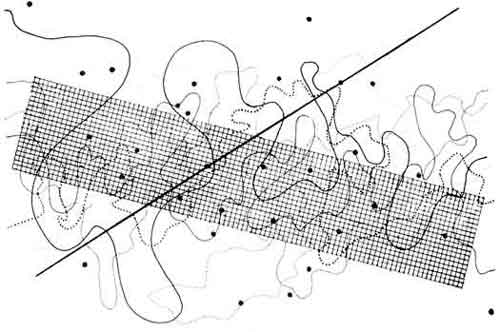
MG: Your new book ‘Community without Community in Digital Culture’, has come out at the same time as Geert Lovink’s ‘Networks Without A Cause: A critique of Social Media’. Lovink asks “How do we overcome this paradoxical era of hyped-up individualization that results precisely in the algorithmic outsourcing of the self? How do we determine significance outside of the celebrity paradigm and instead use intelligence to identify what’s at stake?” [1]
Where are your thoughts in regard to Lovink’s question, and does it relate to what you propose in terms of “hospitality to the other?”
CG: I haven’t read Geert’s book, yet at least… But I am highly sympathetic to what I take to be his position. My view is that the Web is part of a broader set of developments that apparently concern relationally, but actually emphasize the sovereign individual and autonomous subject of modernity, as well as promoting spectacular and image-bound forms of presentation and relation. The problem is that one alternative to this individualization is a kind of fascistic identification with the mass, in the form of fusion that negates the individual. A solution maybe to engage with the idea of the other in terms of difference, as both relational and separate, and yet also that which we depend on for our identity in a process of differentiation; thus the idea of hospitality as a reception of the other in difference.
MG: Community without Community in Digital Culture, is a curious title. It proposes contradictory meanings and these contradictions are clearly explained in the introduction. Although, the last sentence says “In this such technologies are part of the history of the death of God, the loss of an overarching metaphysical framework which would bind us together in some form of relation or communion. This can be understood in terms of contingency, which has the same root as contact.”
Could you unpack this last sentence for us, I’m especially interested in what contingency means to you?
CG: I owe my understanding of contingency to the work of philosopher Quentin Meillassoux, whose book After Finitude is causing a stir. Meillassoux is one of a small number of young philosophers sometimes grouped together under the name ‘speculative realism’, mostly because of their shared hostility to what they call ‘Kantian correlationism’, the idea that there can be no subject-independent knowledge of objects. Meillassoux follows the work of David Hume, who questioned the whole notion of causation; how one can demonstrate that, all things being equal, one thing will also cause another. For Hume causation is a question of inductive reasoning, in that we can posit causation on the grounds of previous experience. Meillassoux pushes the implications of Hume’s critique of causation to a point beyond Hume’s own solution, to propose the only necessity is that of contingency, and that everything could be otherwise, or what Meillassoux calls ‘hyperchaos’.
![Community without Community in Digital Culture [Hardcover]. Dr Charlie Gere. Palgrave Macmillan (2012) http://www.barnesandnoble.com/w/community-without-community-in-digital-culture-charlie-gere/1110025572 See on Amazon.](http://www.furtherfield.org/wp-content/uploads/2012/09/179510500.jpg)
I use his ideas to think through the implications of the ‘digital’. According to the Oxford English Dictionary ‘digital’ has a number of meanings, including ‘[O]f, pertaining to, using or being a digit’, meaning one of the ‘ten Arabic numerals from 0 to 9, especially when part of a number’, and also ‘designating a computer which operates on date in the form of digits or similar discrete data… Designating or pertaining to a recording in which the original signal is represented by the spacing between pulses rather than by a wave, to make it less susceptible to degradation’ (the word for data in the form of a wave being ‘analog’).
As well as referring to discrete data the dictionary also defines ‘digital’ as ‘[O]f or pertaining to a finger or fingers’ and [R]esembling a finger or the hollow impression made by one’, thus by extension the hand, grasping, touching and so on. Much of the book concerns deconstructing the ‘haptocentric’ implications of contact, and communication, especially in relation to the claims made for social networks, and to engage with what I understand as the relation between ‘contact’ and contingency’. ‘Contingency’ is derived from the Latin con + tangere, to touch. ‘Contingency’ enables us think through the implications of the term digital, by acknowledging both its relation to the hand and touch and also to the openness and blindness to the future that is a concomitant part of our digital culture after the death of God.
MG: What other subjects can we expect to read about in the publication?
CG: Touch in Aristotle and medieval theology, cave painting, mail art, Darwin and Dawkins, Luther Blissett, On Kawara, Frank Stella, Bartleby the Scrivener, Christianity – among other things… oh, and a lot of Derrida.
MG: If there is a message you’d like to send to the world, as it carries on regardless with its “permanent exposure of life, of all lives, to ‘all-out’ control […] thanks to computer technology” [2] (Virilio 2000), and it was printed on a banner, or on a billboard in the streets, what would it be?
I am reading Blanchot at the moment, so perhaps something like ‘the disaster has already happened’ (it’s suitably enigmatic to annoy people).
<———————————- The End (for now) ——————————>
This conversation follows in a series of interviews with women who work at the intersection of art and technology. Amy Alexander’s work as an artist, performer, musician, and professorapproaches art and technology from a performing arts perspective, often examining intersections of art and popular culture.
Amy Alexander is an artist and researcher working in audiovisual performance and digital media art. She has worked under a number of pseudonyms including VJ Übergeek and Cue P. Doll. Coming from a background in film and music, she learned programming and began making time and process-based art on the Internet in the mid-1990’s with the Multi-Cultural Recycler and plagiarist.org. Amy has performed and exhibited on the Internet, in clubs and on the street as well as in festivals and museums. Her work has appeared at venues ranging from the Whitney Museum and Ars Electronica to Minneapolis‚ First Avenue nightclub. She has written and lectured on software art and audiovisual performance, and she has served as a reviewer for festivals and commissions for new media art and computer music. She is an Associate Professor of Visual Arts at the University of California, San Diego. During summer/fall of 2012, Amy is Artist-in-residence at iotaCenter in Los Angeles.
Rachel Beth Egenhoefer: You’ve taken on many roles as an artist, musician, performer, coder, organizer, professor. How would you explain what you do to the “average Joe” who has not idea what a code artist is?
Amy Alexander: I usually don’t try to explain to people what a code artist is. I generally just tell them about the types of projects I or my students do, (“museum installation,” “club performance,” etc.) and what some of them are about. Then I explain that it’s done by writing software, building electronics, making videos, etc. But the point is more about the projects, not about how specifically they are made.
I also think talking about code-as-art is both less necessary and less difficult than it was five or ten years ago. What motivated me and a lot of other code artists back then was a concern that algorithms had a cultural impact that wasn’t well-recognized. Nowadays, people are familiar with the idea that Google sorts your search results in a particular way, websites you visit develop demographic profiles of you, etc. – they’re already concerned about algorithms. So I think it frees up both artists and audiences to focus on other aspects of the work. Of course, there are definitely some situations in which focusing on algorithms-as-art is important. Just like photographers sometimes focus on the nature of photographs, video artists on video, etc.
RBE: You’ve worked as yourself, as well as other performers such as Cue P. Doll and Übergeek. Can you describe the differences between some of your characters, and how do you see identity as a key element in your body of work?
AA: Some of the online characters just evolved. I tend to anthropomorphize things, and I like to break into characters; I’ve just always done those things. So in some cases when I’m developing a project from a particular perspective, a character emerges who personifies that perspective. For example, The Original Plagiarist.org (1998) website was a collection of projects in which grandiose attempts to opportunistically plagiarize from the Internet always turned out to be transparent. So the character of Plagiarist emerged as the proud proprietor of this site and creator of all its projects – and the only person who couldn’t see the futility of the plagiarisms.
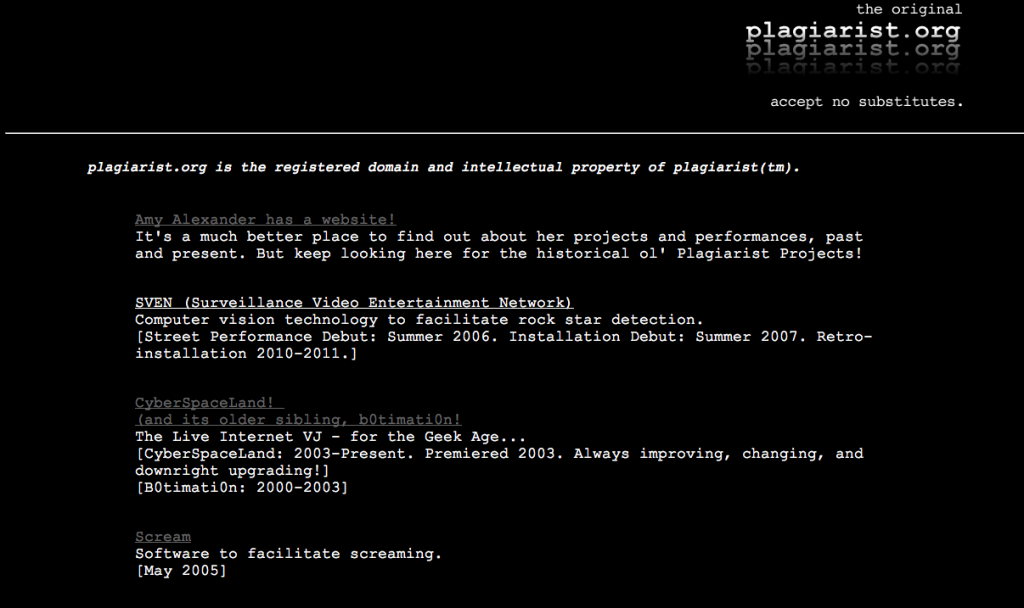
Übergeek is different, since I physically go out and perform as her. She’s both a theatrical character and actual club performer – in varying proportions depending on the context of the show. The theatrical character is a geeky rockstar wannabe. That opens up space for Übergeek to exaggeratedly escape the physical restrictions of performing on a computer – by waving around an “air mouse,” dancing on a DDR pad, etc. The club performer comes from my growing up performing music. I’d never thought about it, but the zone musicians go into to perform is really like playing a character. You have to become someone else. A few years ago I heard Steve Schick explain that when he has to perform a difficult piece of music, he imagines he’s someone else – and that other guy can play the piece. Eventually I realized that any performance of any kind I’d done that I’d been remotely satisfied with, whether music, VJ show, or performance art – I’d mentally become some other person. Going into character is really important, even if the character is just, “the performer.” It can be easy to forget the crossovers between performing arts and visual arts, but there’s a lot we can learn from one another.
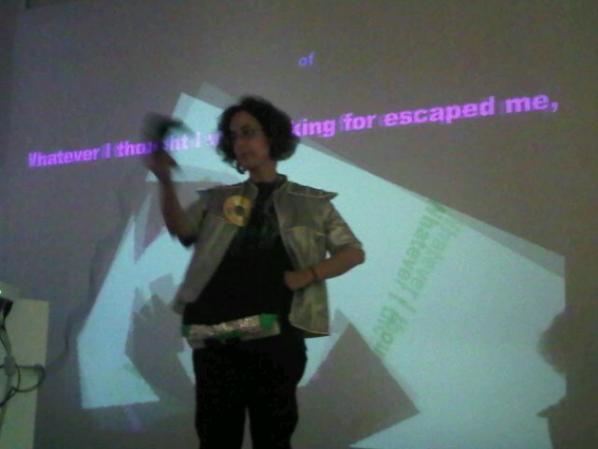
RBE: Do you think this happens to us when we interact online, that we become performers? (Some people believe for instance that Facebook is really a performance of ourselves, not our real selves) Do you see any intersections of performance in “online” vs “physical/ in person” interactions? (I realize this gets into an entirely different question, the idea of intentional performance and unintentional, but perhaps you see an overlap?)
AA: I think there’s an overlap, but there’s also an overlap between the kind of “performances” we do online and those we do in “real life.” I don’t buy the dichotomy that the physical world is real/true and the online world is fake. We perform different sides of ourselves in different real life situations – work, friends, family, large group, small group, etc. Sometimes we perform more consciously than others. On the other hand, sometimes we feel less inhibited in online interactions, so we behave more naturally.
That’s not to say there’s no difference between online and offline interactions – but then again, these differences didn’t just suddenly emerge when the Internet came along. Think back to when people sometimes had pen pals by snail mail, for example. The relationships could be friendly, intimate, or performative. When things like immediacy and nonverbal communication disappear, that invites a different kind of behavior – be it more natural, more performative, or a combination.
RBE: What connections do you see between identity, code, and performance?
AA: I guess I’ve responded to identity & performance in the question above. As for code & performance: people have pointed out that code parallels musical notation, in that both are executable languages. If you think about scores by people like John Cage, where scores could actually be diagrams or verbal instructions to the performers, the connection between performance and instruction set becomes even clearer. This is interesting historically and theoretically, but for many of us who use code in performance, the connection becomes self-evident in practice. Code launches processes and actions, and performance *is* processes and actions, and there’s a back and forth between the performer and software. It’s not that much different for me performing software than performing a musical instrument; if I play violin, I finger, bow, pluck in various ways to get various sounds. You can think of the violin as interface, the notes and gestures as parameters, or whatever. But to be honest, trying to create precise analogies is a recipe for disaster. The point is, you perform both of them, and you have to learn how to do it. The difference with software is, you build your own instrument; that’s both a blessing and a curse. So you try to balance playability with flexibility, and so on. Because of my experience playing music, I keep trying to build ones that will accommodate clumsy performers like me!
RBE: Do you see all code as being “performed”? (Or perhaps is saying code is executable the same as saying code is performed?)
AA: It depends on which sense of the word “performed” you’re using. In the sense that means to do some sort of process – like to perform your job duties – yes. You can think of data as nouns and algorithms as action verbs. You “run” code, and though the physical metaphor might be an exaggeration, in general, some sort of an action happens. So in that sense, the processor is performing the code.
But in the other sense of the word – intentional performance, performing arts, performance art, etc. – running code is innately no more of a performance than breathing. People like John Cage have made interesting performances out of breathing, and people like Alex McLean have made interesting performances out of running code. But it’s not that way on its own, except in the Cagean sense of it being performance if you think of it that way. I think that’s interesting, but I’m personally more interested in code’s cultural, rather than formal, implications. In other words, I’m not so excited that processes are dynamic and self-repeating for their own sake. I’m more interested if, for example, that means we have increasing difficulty finding unpopular or obscure information online, because the popular perspectives have formed an algorithmic echo chamber.
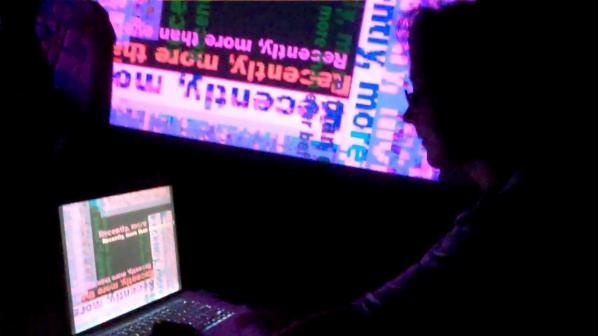
RBE: Your newest work is using audiovisuals, performance, solar energy, and the history of dance in cinema. How did you arrive at this combination of ideas?
AA: The project is Discotrope: The Secret Nightlife of Solar Cells. It’s an audiovisual performance – a collaboration with Annina Rüst, with algorithmic sound design by Cristyn Magnus. There’s really two parts to the project: the projection system, and the content and performances that we develop for it. The system is a disco ball where some of the mirrors have been replaced by solar cells. The cells power the motor that turns the ball. We project video onto the ball instead of colored light. The result is, reflected, fragmented video images move around the room. Since the video projections “solar”-power the ball, the speed at which the images move around the room varies with the brightness of the images.
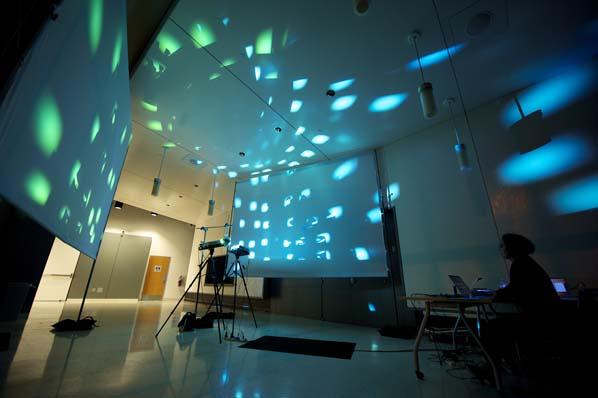
The way this all came about was I’d been interested in the philosophy behind hybrid cars and various other things – that when we “waste” energy, we might actually be creating it. I kept wondering if this idea could be applied to media somehow, and I kept trying various experiments with video: could the talking heads on cable news power an LED? etc. Never quite found the right outlet for this idea, though. At some point, Annina and I came across a disco ball, and we noticed the similarity between its mirrors and small solar cells. Then the idea of projecting videos onto it hit us, and it all came together as a “media-powered” system. Of course, that was just the general idea. After Annina built the initial prototype of ball, it took many hours working with it the studio for the “instrument” to reveal itself – i.e. how exactly does a video-powered disco ball become useful visually and performatively? Figuring that part out was just elbow grease – but getting from rough idea to what-is-this-really always is for me; I have to get my hands on things and play with them.
The content framework we’re working with for at least our initial round of performances is “the history of dancing ‘at’ cameras.” Since it’s a disco ball, we envisioned performing it at community dance parties, etc., and so people dancing seemed like the obvious thing to project. We started from the idea of projecting the people at the party onto it live – but we realized we also wanted to expand beyond that. Again, the elbow grease process: I’d try different clips of people dancing on YouTube, old movies, TV shows. Eventually a connection emerged between early cinema clips and contemporary YouTube clips. In both cases, people dance pretty much like vaudeville performers, directly for the audience – as opposed to cinematic narrative style, in which the viewer is a fly on the wall. In the dancing “at” cameras style, there’s a more direct, intimate connection between dancer and audience. We’ve written some things about this on the Discotrope blog – and I’ll probably write more there soon. Another thing we became interested in is how representation (gender, physical, etc.) does and doesn’t change from early movie camera demos and Hollywood films to YouTube, where people are generally self-cast and self-directed. And I’m really interested in the relationship between all of this and the muddy space between exhibitionism, voyeurism, and surveillance. That’s a theme that’s run through a number of my projects, and dancing at cameras certainly exemplifies that murkiness.
Of course, a lot of the dancing at cameras perspective relates to film history in general – cinema’s origins in theatre and vaudeville, the development of montage, etc. So it’s interesting to see it return with YouTube. Teresa Rizzo has written a really interesting article related to this called, YouTube: The New Cinema of Attractions.
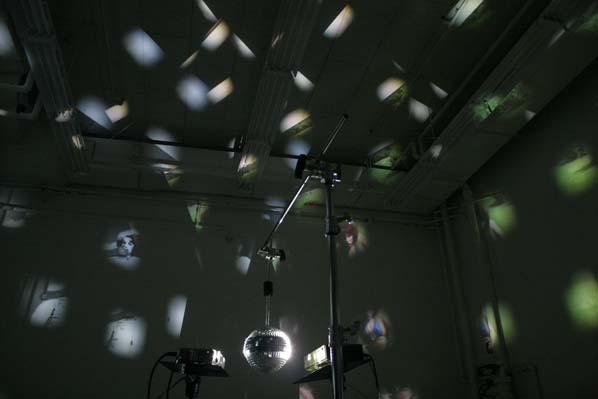
RBE: When you say “people dancing at cameras” I immediately thought of surveillance cameras. Is your disco ball a type of surveillance camera?
AA: I’m really interested in the blurring between surveillance, exhibitionism, and voyeurism. The Multi-Cultural Recycler, SVEN, and CyberSpaceLand all hit on that theme in one way or another; this time it’s cinematic dancers. The cinema/YouTube performers who appear in Discotrope all knew they were on camera, so overtly it’s more about exhibitionism and voyeurism. Glamorous 1950’s female burlesque dancers did their strip tease acts for the camera; sixty years later, not-so-glamorous scantily-clad men proudly stomped through the Single Ladies dance on YouTube. One group does work-for-hire within the Hollywood studio system; the other does what they want. Does that make one voyeurism and the other exhibitionism, or is it more complicated than that? in some cases, we see the performers much differently than they probably saw themselves. Does that make it surveillance? I think it’s all very muddy, and that’s what I find interesting.
The flip side is that there are people in some of Discotrope’s YouTube videos doing things like dancing in Walmart, which gives the video a surveillance camera look even though it’s obviously not surveillance (in the traditional sense, at least.) People turn the tables on surveillance video and make their own production numbers in surveilled/controlled areas – for fun and as a type of resistance. That’s one of my favorite parts of Discotrope. Then we get to recreate those Walmart spaces in the big Discotrope projection. It makes it even more like an old Hollywood production number, and it makes it weirdly immersive. This is fun for us, because Walmarts are not the kind of thing normal people like to recreate immersively. 🙂
RBE: For this piece you are creating something for other people to perform with. Are there any differences for you in creating work that you will perform vs. others performing?
AA: Ah, those pesky multiple senses of “performance” again!. 🙂 I do the visual performances for Discotrope, so for now I’m primarily building the software system for myself to perform. So far Annina is the only other person who performs with the software. Like anything, it’d require some tweaking to be distributed for more general use, though I’ve tried to make it not too terrible in that regard. 🙂 More challenging/interesting might be for performers to get the feel for moving the ball – like anything, it takes practice to get proficient.
But perhaps you’re talking about performers in terms of the audience who can dance to Discotrope, or the parts of the show where audience members can dance on camera interactively. In this case, they’re both performer and audience at the same time. That’s an interesting challenge, because in designing the show, we have to think about them in both ways.
RBE: You are starting a residency at the iotaCenter in Los Angeles, what will you be working on there?
AA: It’ll be mainly exploratory/preliminary research; things will likely be changing/developing as I go along. But my general plan is to explore two threads: gestural and spatial cinematic performance. In performing CyberSpaceLand over the years, I found myself unconsciously developing certain gestural/structural performance techniques that were much different than what I’d consciously designed for the piece. That spawned some ideas about gesture, time and space that I’m going to try to take further. The spatial thread grew out of some things we’ve played with in Discotrope in terms of deconstructing cinematic narrative in a 360 degree space. I’ll be exploring these spatial cinema ideas both in regards to Discotrope and as broader research.
iotaCenter’s a great place for doing research in abstract / formal and experimental cinema, visual performance history, etc. They’ve got a terrific collection of films and texts. I’m hoping to also use the opportunity to get together with other experimental cinema and visual performance folks in LA. It’d be great to organize some fun/intellectually-stimulating/breathtakingly-earthshattering screening/performance events.
RBE: This interview is going to be part of a series of interviews with women working in art and technology. What do you consider to be important today about being a woman working in art & technology? Do you think it is still useful to discuss the female voice as a separate voice in the field?
AA: It’s a tricky subject, because we both need to hear women’s voices and avoid tokenizing or homogenizing them. Women artists working with technology do tend to have different perspectives than men, and there are far fewer of us. So often when the dominant themes emerge, they tend to be the “masculine” themes by virtue of sheer numbers. A corollary is that often women artists feel pressured to focus on gender issues or certain types of social issues. Again, it’s a problem of critical mass and self-perpetuating themes. Since a fair number of women are already involved with those topics and many women’s interests overlap there, they have momentum. But this ends up discouraging women from discussing or doing work on other topics they’re interested in, So, while we need to talk about shared experiences among women in art and technology, we also need to recognize that they have a diverse range of work and perspectives.
RBE: How have you seen perceptions of gender change through the years either in teaching, performing, or working as an artist?
AA: It’s interesting to think that the first programmers were women, and that at the time it was considered clerical work. (See Researcher reveals how “Computer Geeks” replaced “Computer Girls” by Brenda Frink.)
As men started to fill programming jobs, the perception of programming shifted. It became something “technical” that was somehow inherently “man’s work,” even though it had been clerical “women’s work” only a few decades earlier. I’ve seen something similar happen as a female computing artist. I think there are more of us now – at least we don’t seem to be the novelty we were ten or fifteen years ago. And I’ve seen a shift in attitudes and perception among undergraduate computing arts students: by now both the men and women have grown up playing video games and doing a variety of Internet activities that might have seemed like “boys-with-toys” pastimes a decade ago. So their perceptions of what they’re learning to do as computer artists is a little more open and less gendered. But unfortunately, there are still circular perceptions in all age groups that whatever technical work women are doing can’t be too serious by virtue of the fact that a woman did it. It would seem to parallel the current political debate in the US about the pay gap between women and men. There are always arguments that women’s jobs aren’t as demanding, and they usually end up with someone saying, “I can’t believe we’re still talking about this in 2012!” So on one hand, the more things change, the more they stay the same. On the other hand, as more women computing artists emerge, we’ll hopefully soon achieve sufficient critical mass for world domination. Don’t say I didn’t warn you.
Featured image: “Born in 1987: The Animated GIF” from the site’s page.
Marc Garrett interviews Katrina Sluis, the new curator of the Digital Programme at The Photographers’ Gallery, London. We discuss about the gallery’s recent show Born in 1987: The Animated GIF and what kind of digital exhibitions and projects we can expect from the gallery in the Future.
An edited selection shown on the London Photographers’ Gallery’s new digital wall, during the final weeks of the show. http://thephotographersgallery.org.uk/the-wall-2
The exhibition microsite. An open conversation where anyone can join in and contribute their own GIFs. http://joyofgif.tumblr.com/
Marc garrett: You have joined The Photographers’ Gallery and as part of the new digital programme launched the exhibition “Born in 1987: The Animated GIF”. Could you tell us about this project?
Katrina Sluis: The digital programme presents projects both online and offline, which respond to recent dramatic shifts in the digital image as it becomes increasingly screen-based and networked. As part of this new programme we have launched ‘The Wall’ – a permanent exhibition space on the ground floor of the Gallery, visible both to visitors and passersby on Ramillies street. The Wall itself is a 2.7 x 3m Sharp video wall which we installed after considering a number of different technologies. We were conscious not to use digital projection as it would locate the project within traditions of cinema and video art, and we wanted the screens to respond to the reception and distribution of images within wider visual culture.
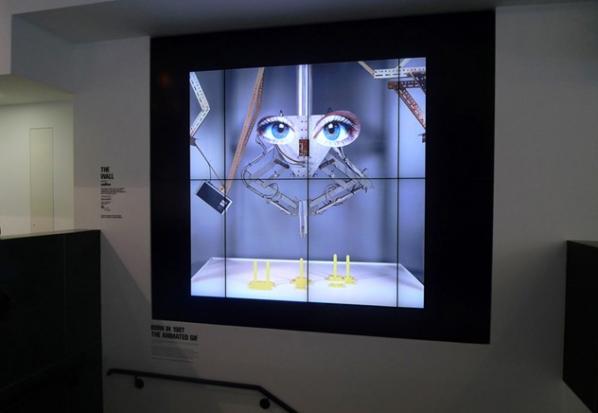
For the opening show, we decided to focus on the animated gif for a number of reasons. Firstly, the gif is a uniquely screen-based image format, in which the specific characteristics and limitations of the image file are inherent to the form, in contrast to the other kinds of images the gallery might show which might adopt digital techniques but result in traditional print-based photographic work destined for the gallery space.
I also wanted to disrupt certain expectations about the screens – the fetishisation of resolution and image quality, and what kinds of photographs The Wall’s programme might seek to address. The animated gif in this sense is very interesting – it is one of the first image file formats native to the web, and although it is 25 years old this year it has been undergoing a resurgence on platforms such as Tumblr. In a commissioned essay for the show, Daniel Rubinstein speculates that current resurgence of the gif “is not only part of the nostalgic turn towards the blurred, the unsharp and the faded but it is also a marker of a moment when the history of the network becomes the material from which the digital image draws its living energy.”[1] Frequently authorless and contextless, the gif image works on a different economy in which its value is based not on its uniqueness and scarcity (as in certain forms of art) but its circulation and proliferation. Although there have been significant practitioners of the gif form, it is a format which ultimately resists canonization. And, in the context of a photography gallery, it opens up other debates concerning medium specificity and the ‘post-photographic’.
In approaching the exhibition, I was keen to ask a diverse range of photographers, writers, organizations and other practitioners to contribute a gif for the show. In keeping with the unmonumental nature of the form, I asked contributors to respond within a short timeframe of 7 days. For many contributors, this was the first time they had made a gif; but other contributors already had large followings on Tumblr and some were established net artists. This opening show and associated Tumblr site (http://joyofgif.tumblr.com) became a starting proposition for the project in order to then open up The Wall to gif contributions from the wider public. We will continue to update The Wall with public responses on a daily basis until the final day of the show on 10th July.
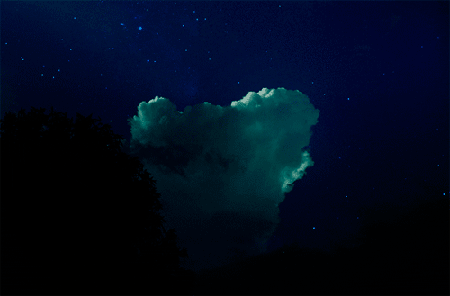
MG: At first, some may assume that the first part of the exhibition title ‘Born in 1987’, refers to the fact that today so many young people using computers these days were born in 1987. Yet, the GIF format, short for ‘Graphics Interchange Format’, was introduced to the world of computers by CompuServe in 1987. Was the title of the show deliberately playing with both notions?
KS: I like this idea! The title does self consciously play with the way in which the digital is valorised for its endless ‘newness’ and novelty but yet has this long and frequently overlooked history of creative experimentation. You can also see this reflected in the recent hype around the work of Kevin Burg and Jamie Beck who have (problematically and entrepreneurially) re-branded the gif as the ‘cinemagraph’.
MG: Do you consider this project to be net art, if so, how does it relate to other forms of net art?
KS: The project (and The Wall’s programming) does pose certain problems as it seeks to relocate certain forms of online practice(s) into the space of the art museum. At the same time, the project exists in an online context with its own very different life on Tumbr, where the work circulates in a very different context with a very different audience. I think there are many interesting opportunities which emerge from this intersection of the institutional frame of the museum (with its associated issues of cultural and curatorial authority and the legacy of aesthetic modernism) and the values and politics which inform certain kinds of networked arts practices.
But I also think the project also needs to be understood in the specific context of The Photographers’ Gallery, its history and audience. Whilst the project shares the concerns of net art by raising questions concerning authenticity, authorship and ‘the social’, it is also motivated by the need to rethink familiar notions of photography and temporality, indexicality and the economy of the image – concerns which presently haunt the field of photography theory.
![Kennard Phillipps. GIF image by Peter Kennard and Cat Phillipps. Born in 1987: The Animated GIF. The Photographers' Gallery 2012 [2]](http://www.furtherfield.org/wp-content/uploads/2012/07/fuck-the-markets-latest1.gif)
![Rad Racer glitch 3. GIF image by tracekaiser. Born in 1987: The Animated GIF. The Photographers' Gallery. 2012 [3]](http://www.furtherfield.org/wp-content/uploads/2012/07/tumblr_m5tqfl62wl1qew2moo1_400.gif)
MG: In what way do you see this form of creativity relating to others who may not be so well versed with net art culture, or digital networked practices?
KS: The Wall presents an opportunity for the Gallery to collaborate with diverse communities who can bring their distinct expertise and experiences to the programme, and the net art community has much to offer in this respect. For this reason, we aim to develop The Wall’s future programme through the framework of ‘collaborative research’, in which our audience, along with the organizations we partner with, are potential co-researchers. The co-researcher model developed as an approach to research democracy in the Social Sciences, particularly in the approach of Action Research in the NHS but in a more relevant cultural example was used extensively in the Tate Encounters: Britishness and Visual Culture research project. Co-research recognises both the collaborative and collective nature of meaning construction, through a process which attempts to trace and reveal the complex manufacture of meaning.
At the same time, there is still another related project to be done in highlighting and responding to digital projects whose life is online – this is of course something I admire Furtherfield for doing so brilliantly. On a smaller scale and with a more narrow focus, we hope to launch a blog which will draw attention to online work which relate to photography as it becomes polluted, valorized, hybridized and networked.
![GIF image by Paul Flannery. Born in 1987: The Animated GIF. The Photographers' Gallery. 2012 [4]](http://www.furtherfield.org/wp-content/uploads/2012/07/tumblr_m442xish4q1rvlji4o1_500b_0.gif)
MG: Some, may view this this exhibition as relating to Internet Folk Art. There is an interesting article by Kenneth Goldsmith[1] where he discusses the digital theorist Rick Prelinger’s claim “that archiving is the new folk art, something that is widely practiced and has unconsciously become integrated into a great many people’s lives, potentially transforming a necessity into a work of art.”
Now, this is not directly relating to the show itself, but it resonates something regarding the inclusiveness of the show. So, in respect of it ‘possibly’ possessing aspects of Folk Art, what connections do you see as relevant or not, and what does it mean to you?
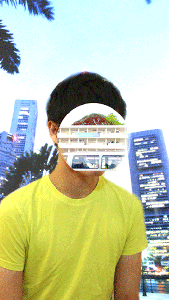
KS: By focusing on the gif the show does problematise the distinction between artist and audience, in which participation, openness and the ‘crafting’ of the image becomes key. However I have reservations about the use of the term Internet folk art, which could be construed as imposing a certain modernist logic on the discussion, burdening it with an analogue modeling of high and low culture. The research approach has been adopted precisely to avoid the trap of binary nominalism, and to problematise the tendency to shoe horn internet practices into the language of cultural studies and aesthetics.
MG: The Photographers’ Gallery was the first independent gallery in Britain devoted to photography and has been going since the 70s. It is the UK’s primary venue for photography and has been dedicated in establishing photography as an essential medium, representing its practice in culture and society. It seems that The Photographers’ Gallery is going through another transition. You have already mentioned how hybridized and networked the nature of future projects will be. So what kind of exhibitions and projects can we expect in the future?
KS: Because digital technology is not in itself a new photographic medium, but essentially a hybrid and converged set of technological practices, it raises many interesting problems, both theoretical and practical for a Gallery focused on photography. To the computer, the photograph is indistinguishable from the other binary blobs of data we used to call books, films and songs. The crisis of digitization and medium specificity now extends to the domain of the camera – Digital SLRs are coveted for their ability to shoot high quality digital video, and we turn to our mobile phones when we want to take snapshots. This is a very rich context for the programme to explore, and ideally the future projects will respond to the technical, creative and cultural languages of photography as produced by computer engineers, web developers, photographers, artists, networked communities, social scientists and other practitioners.
Our next show on The Wall (opening 13th July) features the practice based research of Susan Sloan into portraiture using motion capture and 3D animation techniques widely used in entertainment, medicine and the military. Her motion studies refer to the traditions and conventions of portraiture and the changing role of the camera as a recording device. At the same time, her work raises questions concerning the convergence of painting, animation, film and photography in the digital realm.
The future digital programme which will occupy different spaces and address various photographic practices including augmented reality, social media, electronic publishing, interactive media, mobile computing and synthetic imaging.
The Joy of GIF – the London Photographers’ Gallery’s new digital wall. Article by Wendy McMurdo.
http://www.foam.org/foam-blog/2012/may/photographers-gallery
So Alan Turing was born 100 years ago today. More or less every esteemed field of technological discovery has been plugging certain events and exhibitions surrounding the Turing centenary this week, each one steadily demanding a greater recognition of Turing’s astonishing legacy and achievement. There have been articles aplenty; some seeking to identify Turing alongside other persecuted scientists. Others argue that Turing’s achievements should be listed alongside calculus and relativity – perhaps something which should have been common-place anyway given the precarious computer age which surrounds us – (rather bewilderingly, despite the increased media coverage the UK Government are still failing to issue a full pardon for Turing’s shocking treatment in the last two years of his life).
It’s a testament to Turing’s fascination with nearly everything that 76 years since his first major paper, there’s still so much to write about his work. Expect this week to offer more events and glimpses into these projects: Neuro-computational studies into the functional basis of cognition. The ever forward march for genuine artificial intelligence. New methods of simulating the complexity of biological forms nearly 60 years after Turing’s paper on the chemical basis of morphogenesis (indeed this area of complexity theory is now an established area of major research). The slippery mathematical formalist discoveries which define what can or cannot be computed. And not forgetting key historical developments in cryptography, perhaps the field which Turing is most respected for. Moreover, Turing wasn’t just one of the greatest mathematicians of the 20th Century, but also one of the greatest creative engineers; someone who wasn’t afraid of putting his ideas into automation, through the negotiation of materials.
So for the positivist sciences and technological engineers, Turing’s curiosity continues to bequeath low hanging research fruit ready to be picked. But what of the arts and humanities? How have they contributed to the Turing centenary? How are they influenced by Turing?
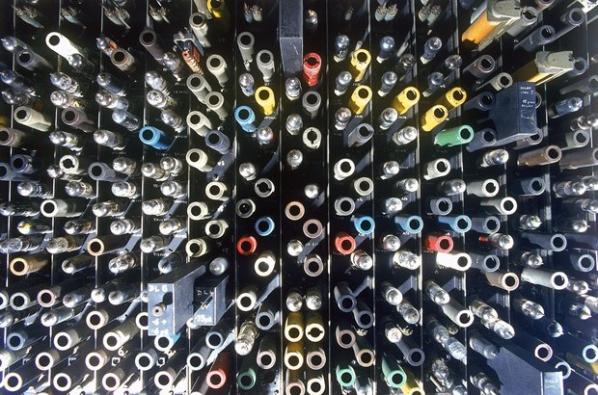
Indeed, its always more deeper than is actually realised. Clearly, in Analytic Philosophy where cognitive science is dominant, Turing’s legacy continues to elevate epistemological, ethical or moral questions about the nature of the human mind – with many offering high bids on the future foundation of a computable brain, by reducing the cognitive understanding into its putative evolved material constituents (see Daniel C. Dennett’s recent article in The Atlantic) – Others completely vilify the idea that consciousness could ever be fully engineered. Others speculate (naturally).
In the arts, a special Alan Turing centenary committee has been set up to fund art projects which deal with Turing’s legacy in various ways. The “Intuition and Ingenuity” exhibition in particular features work by Ernest Edmonds amongst others. In a more direct link, the mathematician Robert Soare has even argued for the existence of a pesudo-cryptic ‘Turing Renaissance’, establishing a link between classical recursion theory and the classical art of the Italian High Renaissance (which has more than a potent ‘Da Vinci Code’ whiff about it).
Some academics have chosen to focus on the biographical details of Turing’s own short life. In particular Homay King (and I only found out about this in conversation last week) has offered key insights into Turing’s research methods using Queer Theory, not simply because Turing was openly gay and speculated on thought experiments involving gender, but because Turing wanted to understand peculiar sociabilities of ambivalent miscommunication. Evan Selinger has written a recent article on how social scientists are using the “Turing test” to observe and understand deception in social groups. And also influenced by these same deceptive qualities, Prajwal Ciryam clarifies its influence on psychopathy and predicting when a psychiatric patient should be released. Here, difficult questions emerge as inspired by the difficult questions Turing himself raised, even if the fields wildly diverge from his own.
But here’s a question – could the arts and humanities move further into Turing’s legacy than admirable commentary on specific biographical revelations of his life, or questions which bother cultural ambiguity?
Perhaps we should ask whether the Turing Centenary will actually convince the humanities and the sciences to attentively read Turing’s work? Forgive the disingenuous patronising structure of the question; I clearly realise that people have read Turing’s work, especially his most famous and readable article, Computing Machinery and Intelligence published in 1950. But think back, have you actually read it?
Written off the back of a report done for the National Physical Laboratory between 1948-1949, Turing’s succinct article famously speculated on machinic intelligence, as well as launching the infamous Turing Test (the moniker “Turing Test” is a bit of a misnomer, Turing himself called it an imitation game). And yet, it strikes me as absurd that more hasn’t been written on how strange, bizarre, hysterical, paradoxically informal and wonderfully written this text is, as a text. Especially since it is a text which is often considered ‘scientific’ and ‘academic’ as opposed to ‘mere literature’.

In a 2008 article, which again, no-one seems to have read (‘Powers of the Facsimile: A Turing Test on Science and Literature‘, written for an edited collection on the novelist Richard Powers) – Bruno Latour makes this strategic point about the ambivalent qualities of Turing’s 1950 article. For him, Turing’s text contains not clear analytic rigour, but “metaphors, tropes, anecdotes, asides and self description”; features of what he calls “matters of concern”. Turing considered the idea of machines having intelligence through the “most bizarre, kitschy, baroque text ever submitted to a scholarly journal“. Latour even jokes that Alan Sokal would no doubt have interpreted it as a hoax. It’s no wonder that Turing’s friend and logician Robin Gandy said of the essay that, “it was intended not so much as a penetrating contribution to philosophy but as propaganda […] He wrote this paper – unlike his mathematical papers – quickly and with enjoyment. I can remember him reading aloud to me some of the passages – always with a smile, sometimes with a giggle.“
“The problem” Latour states, “is that people never read.” Well, by ‘reading’ Latour means that the analytic sciences didn’t really pay attention to what Turing is saying. Even worse, some just ignore the deliberate ambiguity of Turing’s text by reading through it as a transparent window onto whether the mind is computational in nature or whether machines can actually think or not (a question which in the same article and subsequent lectures, Turing considered “too meaningless to deserve attention”, as well stating that his aim wasn’t to give a definition of thinking).
This, for Latour, begs a different type of Turing test; can one distinguish between a Richard Powers novel of realist literature (an exposition of which is given in the first half of the paper) and the scientific realism of Turing? If one is sufficiently fooled, then Latour “will have at least indicated that matters of concern might be best accessible through the joint inventions of literature and science.” And it’s here where the humanities and the arts should claim Turing as a kindred spirit, for Latour’s test terminates any significant difference between “an important scientific text and an important novel” precisely insofar as one cannot distinguish “dealing with demonstrations while the other deals with rhetoric, one dealing with proofs while the other deals with stories[…]” Turing had the nerve to slice and dice allusive, eloquent and creative persuasion together with an empirical understanding of electrical computation. I doubt various scientific proponents of the Turing centenary would take this significance with much seriousness, but I’m convinced artists and literary scholars would do.
So this begs a question, which should resonate loud and clear on Turing’s 100th birthday. What happens when we treat Turing even more seriously; not just as a mathematician, engineer or scientist, but also as a cryptic creative thinker and writer? What happens if we follow his words and not just his conclusions (although certainly the conclusions are worth following, if not extensively by others).
One element which stands out time and time again, is how much Turing was influenced by the reality of unproved conjecture rather than designating reality through deductive proof. This isn’t a quirky coincidence. Turing’s negative solution to Hilbert’s decision problem in his equally famous 1936 paper On Computable Numbers – the paper which conceived the computer as an abstract mathematical concept – showed that there was an intrinsic paradox at the heart of automation. It’s impossible to systematically predict what a certain function will do before you execute it. So in Turing’s 1950 article, we shouldn’t be at all surprised when he espouses the following point;
“The popular view that scientists proceed inexorably from well-established fact to well-established fact, never being influenced by any unproved conjecture, is quite mistaken. Provided it is made clear which are proved facts and which are conjectures, no harm can result. Conjectures are of great importance since they suggest useful lines of research.” Computing Machinery and Intelligence, p.49.
Another point of semblance is how uninfluenced Turing was by the work of his peers. Max Newman one said of him that it was a “defect of his qualities that he found it hard to use the work of others, preferring to work things out for himself.” I very much doubt it was a defect. To consider it so, probably undermines what was so particular and unique to Turing’s creativity. Turing wasn’t persuaded by other interpretations of computing machines other than his own personal tinkering, and this leads to some important insights worthy of aesthetic concern.
For instance in a surprisingly frank passage, Turing lays bare how little knowledge he has when it comes to speculating on the constructions he himself had constructed.
“A better variant of the objection says that a machine can never “take us by surprise.” This statement is a more direct challenge and can be met directly. Machines take me by surprise with great frequency. This is largely because I do not do sufficient calculation to decide what to expect them to do, or rather because, although I do a calculation, I do it in a hurried, slipshod fashion, taking risks. […] These admissions lay me open to lectures on the subject of my vicious ways, but do not throw any doubt on my credibility when I testify to the surprises I experience.” Computing Machinery and Intelligence, p.56-57.
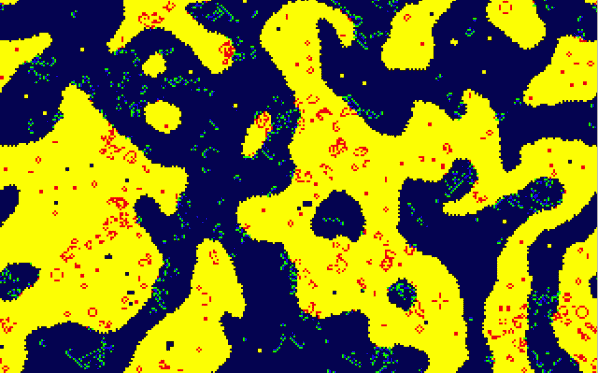
If Turing – the godfather of universal computation – had little knowledge on the output of his own discovery, what does this say about us now? (what does it say about Google’s own recent tribute?) Turing’s famous article lays bare a different interpretation; that he certaintly didn’t envisage computers as simple communication tools for human whims, but did he indirectly expose automatons with agency. What the hell is an automaton?
How he came to define what this agency is, was brutally cut short. However it’s clear from his work on morphogenesis (which Turing began at the same time as his theoretical forays into machinic thought) that some preliminary form of complexity theory was the way forward. It certainly undermines the positivist wing of artificial intelligence research which invests in some predictable form of knowledge where machinic intelligence can only be ‘known in advance’ when it passes for sentience. Do real world formal language systems already contain the type of surprising ambivalence which Turing noticed? Furthermore, do machines experience this level of ambivalence between each other themselves? This is a question which the transparency of analytic rigour and scientific provability would remove for being undisciplined. Turing’s own words suggest otherwise.
In a subsequent lecture broadcast on BBC Radio in May 1951 called “Can Digital Computers Think?“, Turing elaborates on this further using some exquisite metaphors and analogies;
“It is not difficult to design machines whose behaviour appears quite random to anyone who does not know the details of their construction. Naturally enough the inclusion of this random element, whichever technique is used, does not solve our main problem, how to programme a machine to imitate a brain, or as we might say more briefly, if less accurately, to think. But it gives us some indication of what the process will be like. We must not always expect to know what the computer is going to do. We should be pleased when the machine surprises us, in rather the same way as one is pleased when a pupil does something which he had not been explicitly taught to do.”
We have here, in the pangs of its birth, a self-confessed weird quality to the construction of computing in its preliminary stages. It’s this otherness, notably absurd quality to the agency of computing which the humanities (and especially the digital arts) could re-appropriate for it’s own unpredictable ends.
And to some extent this hardly exists as new territory for practising artists who began working with early structural computing systems from the late 1960s – the surprising reality of deterministic rules. I’m sure many artists and programmers, especially those who constantly negotiate their way through complex compilers, stack libraries, code, bugs, glitches and information loss, testify to the same surprises that Turing experienced. For it was Turing who originally suggested that writing and mechanism were almost synonymous.
While I’m sure no aficionado of the Turing Centenary would refute our own particular conjecture, they wouldn’t admit to a conflict between the rhetorical primacy of Turing’s text against the dominant and subsequent scientific uptake. For while the sciences of predictability continue to locate Turing’s legacy as their own, they leave open the chance for the humanities to account for the unpredictable qualities of Turing’s legacy which are ignored. I look forward to the next 100 years.

“Human Readable Messages_[Mezangelle 2003-2011]” is a book published by Traumawien containing almost a decade of Mez Breeze’s “Mezangelle” writings. Mezangelle is hand-crafted text with the aesthetics of computer code or protocols. What marks Mezangelle out is how deep its use of those aesthetics go and how effectively it uses them.
Computer programming languages have their own logic, and it is not captured by holding down the shift key and bashing the top line of the keyboard to add what looks like a cartoon character swearing or random line noise to text. It’s true that programming languages can look incomprehensible to the uninitiated. This Perl code:
y/A-Za-z/a-zA-Z/
will swap the case of lower and upper case English letters. But the conciseness of this notation hides a clear informational structure only in the same way that mathematical or musical notation do.
Likewise the markup language HTML that this article is written in:
<p>looks “<em>gnarly</em>”</p>
and a computer protocol such as email transmission via SMTP:
220 smtp.example.net ESMTP Postfix EHLO someone.example.org 250-smtp.example.net Hello someone.example.org [192.0.2.201] 250-SIZE 14680064 250-PIPELINING
is incomprehensible without reference to detailed technical documents. But all express clear semantic structures and instructions to the computer systems that have been programmed to understand them.
These notations have been created to express data and concepts in structured ways that are possible for computers to work with. They may look typographically arbitrary but they do involve aesthetic choices and historical precedent. They have associations, they have resonances.
We do not usually see the codes involved in our use of computers and the Internet when they function effectively, but they are always there. When they successfully empower or coerce us they become invisible. In the age of social networking, ecommerce, and mobile devices they are pervasive.
What, then, are we to make of Mezangelle? Human written, but intentionally structured in the style of computer code, it recreates the expressive, communicative underpinnings of software syntax rather than simply its surface aesthetics.
To read Mezangelle is to parse it. Parsing in computer software is the process whereby a computer breaks down textual input into smaller and smaller but more and more closely related chunks of meaningful information. Parsing Mezangelle requires the human reader to group and regroup word fragments into shifting webs of meaning. It takes time to do this, and different textual characters and formatting take different amounts of time, adding rhythm and pacing to the meaning of the text.
The history of literary typography, of mathematical notation, and of programming language design has lent a rich range of often contradictory precedents both to software and to writing that draws on its aesthetics. A dot can mean a fraction or a part of an object. A square bracket can instruct a computer to construct a list in memory, to access an element of an array, or to send a message to an object. As can a colon or two, or various arrows. Hashes can indicate comments, identifier numbers, or other entities.
The raw typographic aesthetics of character glyphs spring from their visual form (smooth, straight, long, slanted), size, and relative visual complexity. A full stop or a vertical bar is simpler than a hash or an ampersand. These factors affect how long it takes to perceive them and the effect they have on the eye as we look across them. The glyph-level and code level visual arrangement of code affects the pacing of our reading, building pace and meter. The more semantic aesthetics of the way these glyphs are used to structure code build on and interact with this. And it affects the relations and meanings that we build as we read the text.
Like computer program code, Mezangelle structures its content in order to communicate to and invoke the resources of its parser. Crucially this is a human parser rather than a software one so those resources are aesthetic and cultural. As well as pacing the experience of the text as spoken performance would, these destabilize and expand its meaning as the attention of critical writing does.
The intrusion of quoted plain English text such as an Alan Sondheim piece or an email from a mailing list that have been the inspiration for an answering piece of Mezangelle serves both to show how different Mezangelle is from written English and how effectively it can be part of a conversation.
Here is a line of Mezangelle (broken by the format of this page):
.. my.time: my time: it _c(wh)or(e)por(ous+h)ate_ _experience____he(u)rtz___.] [end]
Read as code, the underscores mean private data and variables, the square brackets mean list construction, message passing, references to individual elements of data structures. The full stops are decimal fractions or references to data or functions that are parts of larger objects. They do not decorate (in the sense of being frivolous), they evoke.
They also semantically structure and pace, allowing reading and re-reading as poetry. Underscores creates distance, brackets group and shift the meaning of words and fragments of words. Addition signs and colons combine concepts and further disrupt the parsing of language as a flat, linear, structure.
Mezangelle is distinct from much historical code poetry in its structural and semantic mastery of the aesthetics of code. It is distinct from concrete poetry in its semantic, destabilizing, temporal rather than merely structural use of typography.
Mezangelle is net art, it is produced and encountered in the environment of the Internet. Mezangelle lives in blogs and on mailing lists. But it does not die on the printed page, far from it. “Human Readable Messages” is typeset in Donald Knuth’s Computer Modern font, a beautifully spindly artifact of the early days of computer typesetting, with the occasional intrusion of Courier-style monospaced teletype/typewriter fonts. This gives the printed text a digital, online feel retaining a genetic link to the environment it originated in.
Mezangelle surfaces and integrates the hidden aesthetics of computer mediated human activity, setting computing and human language in tension and synthesizing them. It expands the expressive possibilities of text and is a form of realism about the conditions in which human reading is currently flourishing. “Human Readable Messages” provides an ideal opportunity to familiarize ourselves with Mezangelle in the depth that it deserves and rewards.
The text of this review is licenced under the Creative Commons BY-SA 3.0 Licence.
This conversation follows in a series of interviews with women who work at the intersection of art and technology. As someone who works as an artist, curator, organizer, professor, researcher, and board member Sue Gollifer embodies this intersection across many venues.
Sue Gollifer has been a professional artist and printmaker for more than thirty years, Gollifer has exhibited her work worldwide and been collected by major international public institutions. A pioneer of early computer art, she has continuously explored the relationship between technology and the arts and has written extensively on this subject. Gollifer is a Principal Lecturer in Fine Arts and the University of Brighton where she is also the Course Leader of the MA Digital Arts Program. She has been instrumental in shaping major international arts communities including: the Design and Artists Copyright Society (DACS), the Computer Arts Society (CAS), and the College Arts Association, (CAA), ISEA, SIGGRAPH, Lighthouse Brighton, and many others. Gollifer is currently also the Director of the ISEA International Headquarters.
Rachel Beth Egenhoefer: Given the many hats you wear as an artist, curator, organizer, professor, many people describe you as many things… how do you describe yourself?
Sue Gollifer: I am an artist.
RBE: But you do other things too?
SG: I know I do. At the moment I’m more of a curator and an organizer, but at the end of the day I am still an artist.
RBE: How do you define your role as an artist in relation to being on the many board of directors you are on (such as ISEA, CAA, DACS, and others)?
SG: I’m not a theorist or in a senior management position but I think that these organizations need people who have a broad sense of the discipline to be on their boards to make sure that people like me and people like you have a voice.
RBE: So you see yourself as representing artists?
SG: Yeah, and I think the fact that I have a European background gives me a broader image as well. When I think about being on the board of some local organizations like Lighthouse or Phoenix in Brighton they value that I’m also part of an International network such as CAA and SIGGRAPH and ISEA. It’s quite reciprocal too. The bigger organizations value my spectrum.
RBE: What do you learn as an artist from doing all these other organizational things?
SG: I think what it does is it starts me making work. It’s like any of those things. But I think it started off when I was a consultant to Higher Education in the UK and I just got used to facilitating and networking and telling people about things. And I realized I was really quite good at that.
RBE: Networking?
SG: Yeah. But not just networking. I organize a lot of mailing lists, where I act as a kind of filter for people, letting them know about events and festivals, and ideas that are going on.
RBE: So given that you work in all of these roles, as an artist, as an organizer, as a filter, what changes have you seen over the years of working in these fields?
SG: Well, technologies have changed our lives with the Internet and mobile phones. You know I travel a lot, but half the time people don’t know that I’m not really there, because I still do what I’m doing somewhere else. Where you are doesn’t really matter. You still kind of function, which has its good points and its bad points really, cause you’re always on call.
RBE: What about changes in content or questions that people are asking? Either in art practice or education or conferences and festivals, have there been any changes?
SG: I think the reason why ISEA is successful is because, although we all have our distributed networks and we’re always in constant touch, I think the act of physically bringing people together is really important. But I do think also that a lot of the organizational things like content management systems and the ways that you hear about various festivals and things is made so much easier. At the same time there are so many of them. It’s really important with my ISEA hat on that I’m thinking about the “un-conference” and that you don’t get stuck in a rut. There is a changing landscape and environment and you need to keep up with that.
But with my educator’s hat on, thinking about PhDs and research papers, there’s a lot more to do with money and research and getting money from science backgrounds now. But the idea of research gets lost. What they value is that people are writing about stuff, they’re not actually doing it, but writing about it, using research as evidence.
RBE: What is the role of research in art?
SG: I don’t know. What do you think? Do you think it’s the work? Do you think it’s making the work?
RBE: Well, I think research can inform the work, and work can inform research. But I think the point you brought up about research and the sciences and the value of it, it seems like it can become problematic when it is seen as a moneymaker. Or when the purpose of it is to get money and not the purpose being to inform the work.
SG: Yeah, I was involved in a science project and there was a lot of money in it and they obviously valued the significance of the artists being in there but really you have to fit your research around the money rather than the other way around. It just got out of sink.
RBE: Does that map at all on to how conferences and festivals are set up? Does the work dictate what will be at the event, or does the event dictate what will be made by artists?
SG: Well, to get back to the research thing. Research as evidence of something, even if you are putting work in an exhibition or putting work in a paper or something, you still need evidence.
RBE: But as far as themes or content, how is that dictated? For example the upcoming ISEA is all about “Machine Wilderness”. Was that a result of artists making a lot of work in that realm and we should have a festival about it, or do you think that it was a decision to have a festival about this and encourage artists to think and make work like this?
SG: Well when people put in a bid to host ISEA, they put in what they think the nature of what ISEA will be about. Obviously when we look at proposals we look at not only the relevance but also the integrity of the people delivering it. “Machine Wilderness” in this case is very much around the themes that Andrea Poli is interested in. The theme of ISEA in Istanbul was “Contained/ Uncontained” which was similar but also a bit broader.
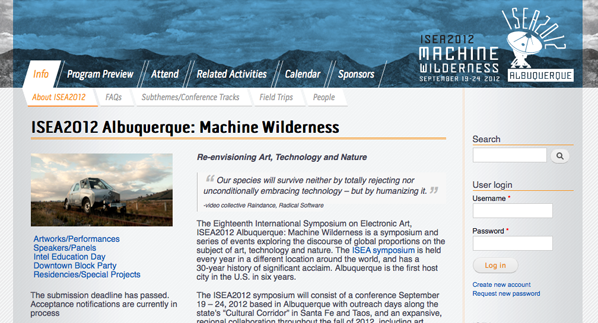
RBE: How do you see the differences in cultures influencing different ISEA’s? ISEA purposely has the festival in different cities around the world, how does that influence the work or the field or what people are thinking and doing?
SG: Well if you take the case of the ISEA in RUHR, Germany, it was to do with the Creative Industries, and creating awareness of new industries. You know we come in and inform people about new things. There’s the idea that we can change things. Or bring things to a city in a way of education and outreach. It shouldn’t be just us sitting in a dark room talking to each other.
RBE: So you see it as a way to bring new media awareness to these different cities?
SG: Yeah.
RBE: But then what do the artists and participants get in return? Or what does ISEA get in return?
SG: You get to travel and meet people! I think you get a different perspective.
We did have two bids coming through for ISEA2014 from Zayed University, Dubai, UAE and Simon Fraser University, Vancouver, BC. Recently the ISEA Board agreed that the Dubai bid, with its focus on the burgeoning field of art and technology in the Arab World would provide a unique opportunity for ISEA to connect audiences and artists from the Middle East with the international electronic art community.
A strong aspect of the bid was the focus on women’s education and ensuring that young women have the potential to influence the future of the region and develop international contacts.
I hope that ISEA can leave a legacy somewhere. I mean otherwise we might as well just have it over Skype calls. The overarching theme of ISEA2014 ‘Location’ will explore strands such as Technology; Science & Art East Meets West; Emerging Economies/Emerging Identities; Nomadic Shifts and Digital Archaeology and Collaborative Spaces.
RBE: This interview is part of a series of interviews with women using art and technology. What do you think is important in having a female voice in today’s art world?
SG: I talk to my students about my role and my job and things like that, and my female students think that it’s really great that I run a digital arts course. If I were a man it would be very very different. I think it’s equally important that students aren’t just taught by women, but women of all ages, those that are married, not married, children, no children. I think we do have to establish role models to a certain extent.
I was a feminist in the 60s and 70s but I never thought that we should be different. I just wanted to be accepted for who I was really. That might be a bit anti-feminist, but I always fought for women for education and opportunities. This goes back to the Dubai thing to a certain extent, the university there started off because one of the princesses wanted to learn about art but there was no place to do so. So it started and went on to have a validated degree. And maybe one day it will have a masters program and women can apply for scholarships and travel abroad?
RBE: Do you think it’s important to have “Women Art & Technology” as a separate category? Or should it just be “Art & Technology”?
SG: Art and Technology.
RBE: Aside from being a female role model for your students and talking about the female voice, what else do you think is important for your students to know right now or learn right now?
SG: Code! (laughs) But I don’t like to think we’re bringing them up differently?
RBE: Or even taking gender out of it, what do young people need to know?
SG: They need to be aware of things. But it depends on what they are trying to do and what direction they want to go in… A big thing is confidence. A lot of my women students do lack confidence.
RBE: Why do you think that is?
SG: I don’t know what it is.
RBE: So what do you do to boost their confidence?
SG: I give them a voice. I give them a space and an opportunity in the class.
When I used to do interviews for undergrad programs in Printmaking, it always started off that the women had better grades, better portfolios, better skills, but at some point it switches. And they loose that confidence and that voice. I don’t know what it is really.
Do you find that?
RBE: The program I teach in has a majority female students. I think that it might be easier for them. I do wonder though sometimes if they are more confident when they are in a classroom with me verses one of my male colleagues or just a different background. But I think there’s also the other end of the spectrum where they are overly confident because they are growing up in this world where you have to be liked constantly on Facebook. You know, like me, like my image, like me, like me, like me… They need to be constantly validated and that spirals into “I’m amazing”. But those aren’t the ones who are asking the tougher questions; those are the ones who want to be liked.
SG: There’s another aspect. Maybe not about confidence, but I think there’s a smoke and mirrors element. There are some men that seem to have all the jargon without actually any credibility. And the women I know with credibility don’t necessarily tell everyone that they do it.
RBE: There are actually studies about that, and how male and female brains are wired differently to behave differently.
SG: I think they address issues in a different way.
RBE: What are you working on now?
SG: Alan Turing!
RBE: What is your role in the Turing Project?
SG: I’m putting together with Anna Dumitriu the exhibition ‘Intuition and Ingenuity’, a group exhibition that explores the enduring influence of Alan Turing – the father of modern computing – on art and contemporary culture. 2012 will be the 100th anniversary of the birth of Alan Turing, one of the greatest minds Britain has produced; the world today would have been a very different place without his ideas.
I’m also curating a projected drawing Exhibition for the Drawing Research Network (DRN) conference in Loughborough in September.
I have also just been part of selection partnership for two newly commissioned pieces of work for Brighton Festival, ‘Sea of Voices’, and ‘Voices of the SEA’. Plus reviewing work for SIGGRAPH art gallery 2012 and for ISEA2012, and papers for the journal ‘Digital Creativity’, of which I am assistant editor.
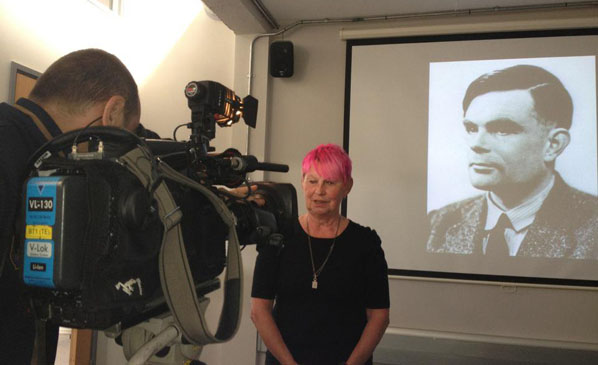
RBE: What excites you about the future?
SG: I don’t know really. I hate to get gloomy about the future, but I do think it’s going to get worse. I mean you live in San Francisco and I live in Brighton so I don’t think it’s hit us quite yet, but I am starting to notice a lot of shops closing. And I know that things I took for granted like buying a house, having children and having a job, I don’t think they have these choices anymore.
RBE: How do you think this will impact the art community?
SG: There are surprisingly good opportunities for the use of vacant shops and offices for exhibition spaces and studios and surprisingly people buy art because they think it’s an investment for the future.
RBE: Do you have anything else you want to tell the Furtherfield readers?
SG: I think it’s going to be interesting and exciting in the future, despite all this, I think it’s going to be exciting to see what comes next.
Other interviews in this series:
Woman, Art & Technology: Interview with Lynn Hershman Leeson By Rachel Beth Egenhoefer
Women, Art & Technology: Interview with Sarah Cook
Featured image: Ein Identity-Workshop mit dem britischen Künstler Heath Bunting. Vertiefung Mediale Künste, Sihlquai 131, 8005 Zürich. Dienstag,
Whether Bunting is climbing trees, skateboarding, canoeing or working with technology he approaches it all with the same critical attention. He hacks around systems, physical or digital. Right from when he built his first computer at the age of 14, his life has been an experimental research project. His practice consists of a dry sense of humour and an edgy, minimal-raw aesthetic, mixed with a hyper-awareness of his own artistic persona and agency in the world, whilst engaging with complex political systems, institutions and social contexts.
Even though the subjects he explores are likely to be the most topical or important issues of the day, it always includes playfulness and an element of the prankster in his work. His work regularly highlights issues around infringements on privacy or restriction of individual freedom, as well as contexts concerning the mutation of identity, our values and corporate ownership of our cultural/national ‘ID’s’, as well as our DNA and investigations into Bio-technologies. In an age where we are submersed in frameworks and protocols designed by a neo-liberal elite for a generic consumer class, Bunting’s work is well placed as observation and practical research into the ‘depths’ of legal and illegal territories in our contemporary, networked cultures.
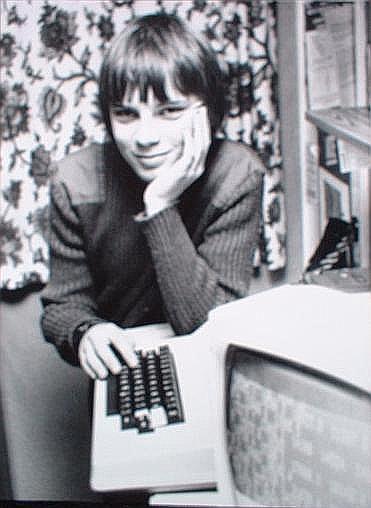
“our identity is constructed as human beings that can possess one or more natural persons and control one or more artificial persons. The higher up in the class system the better the access to status variety.”(Bunting)
The Status Project, is a study of the construction of our ‘official identities’ and creates what Bunting describes as “…an expert system for identity mutation”. His research explores how information the public supplies in their interaction with organisations and institutions is logged. The project draws on his direct encounters with specific database collection processes and the information he was obliged to supply as a public citizen to access specific services; this includes data collected from the Internet and information found on governmental databases. This data is then used to map and illustrate how we behave, relate, choose things, travel and move around in social spaces. The project surveys individuals locally, nationally and internationally, producing maps of “influence and personal portraits for both comprehension and social mobility”.
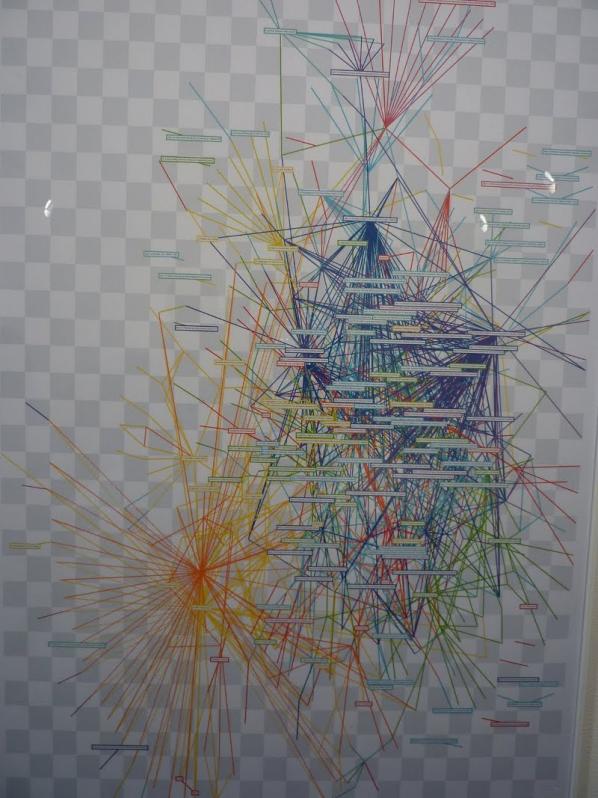
The use of data in contemporary life has made individuals an accessible resource for commercial and political interests. We are a rich source of data-mining material. Data mining is a process that potentially commodifies our interactions. Its historical roots lie with the development of artificial intelligence (AI) and 20th Century statistical analysis. These two methods of formulating data have grown ever closer together, backed by corporations and government-initiated military funding. Social networks such as platforms like Facebook and Internet networked institutions such as Google and the US military are all obsessed with our behaviours online. A good example is the NSA’s recent rebirth in turning most of its surveillance apparatus to spy on the US and its citizens. They have built a supercomputer tracing through billions of people’s emails, phone calls, and online activities in other countries outside of the US. The UK government is currently going through the political process of trying to implement similar spying protocols and systems to watch what UK citizens are up to.[2]
“Google suffers from data obesity and is indifferent to calls for careful preservation. It would be naive to demand cultural awareness. The prime objective of this cynical enterprise is to monitor user behaviour in order to sell traffic data and profiles to interested third parties.” [3] (Lovink)
Bunting is a Hacktivist Artist, acting (playing) out the role of a spy collecting and observing data content. Hacktivist Artists work with technology to explore how to develop their critical and imaginative practice in ways beyond the frameworks of the art establishment and its traditions. The established art arena is gradually catching up with this kind of artwork. However, one could be forgiven for thinking that many art critics and galleries are still caught in the 20th Century.
Two other artists also working on people’s data are Julian Oliver and Danja Vasiliev. They have collaborated on exploring alternative identities as the mysterious group, Men in Grey.[4] They detect online users’ vulnerabilities by tapping into and intervening in wireless network traffic – observing, tracing and copying user online activities. It is then redisplayed online on their website for others to view or transferred onto a visual screen on the side of a briefcase as an intervention in cybercafes for all to view. Although, no one knows other than themselves if the data is hacked and then redisplayed on these briefcases, as proposed in their video featuring one of their interventions. One thing is for sure – they have touched upon issues concerning our fears about personal data being seen by other people who we’d prefer were not viewing it.
The Status Project also taps into questions concerning technology, hierarchy and power. We are entwined in a complex game where the sacrifice of our information is part of connecting with others across digital networks. This raises the issue of our ‘human’ status being aligned ‘to and as’ objects of measurement. Through travel ports, our vehicles, passports, ID cards, library cards, mobile phones, alongside information about our health. We have mutated into networked (information-carrying) beings. Bunting’s own position on this matter is that “Technology is becoming more advanced and the administration of this technology is becoming more sophisticated, and soon, every car in the street will be considered and treated as persons, with human rights. This is not a conspiracy to enslave human beings, and it is a result of having to develop usable administration systems for complex relationships. Slaves were not liberated because their owners felt sorry for them; slaves were given more rights as a way to manage them more productively in a more technologically advanced society.”[5]

In the UK, in 2006 a research document called ‘A Report on the Surveillance Society For the Information Commissioner’ was published. Produced by a group of academics called the Surveillance Studies Network. This report was presented to the 28th International Data Protection and Privacy Commissioners’ Conference in London, hosted by the Information Commissioner’s Office. The publication begins by saying “Conventionally, to speak of surveillance society is to invoke something sinister, smacking of dictators and totalitarianism […] the surveillance society is better thought of as the outcome of modern organizational practices, businesses, government and the military than as a covert conspiracy. Surveillance may be viewed as progress towards efficient administration, in Max Weber’s view, a benefit for the development of Western capitalism and the modern nation-state.”[6]
We are not only under surveillance by entities we do not trust, we are also tracing each other online. Recently, in a show called ‘Being Social'[7] at Furtherfield’s new gallery, artist Liz Sterry showed her installation piece, ‘Kay’s Blog’. Sterry had “collated not only one form of online social engagements but all she could find about a Canadian blogger called Kay. Using everything from photographs to things Kay has mentioned in videos, blogs and posts on social networks, Sterry has recreated Kay’s bedroom in the gallery.”[8] (Scott)

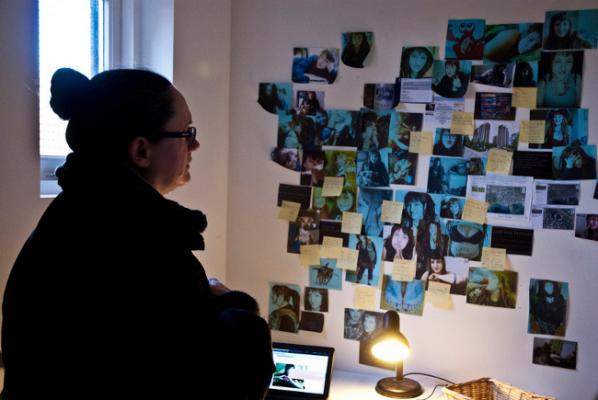
“”There were times when I felt quite creepy,” says Liz, 28, as she shows me lists of Kay’s Facebook friends and a Google Streetview of her apartment block while a playlist of her favourite songs plays in the background.”[9]
Yet, as this ever-creeping surveillance culture grows and attaches its all seeing eyes onto us all. Whether we are referring to domestic interactions, organizational or deliberate, this is not the main issue. Neo-liberalism has developed so much now, we are all part of the Netopticon. English philosopher and social theorist Jeremy Bentham in the late Eighteenth Century designed the Panopticon. It allowed officers in institutions, particularly in prisons, to observe (-opticon) all (pan-) inmates without them knowing whether or not they are being watched. In the end it was not built, but the French philosopher Michel Foucault in his publication Discipline and Punish: The Birth of the Prison,[10] in 1975 said that we are not only monitored in prisons, but in all hierarchical structures like the army, schools, hospitals and factories. This process has evolved through history to resemble Bentham’s Panopticon. The up-dated version of Panopticon, can now be thought of as the Netopticon – where individuals are complicit in feeding their own forms of collective co-surveillance, as well as being traced by corporations, governments and spammers.

“What your data body says about you is more real than what you say about yourself. The data body is the body by which you are judged in society, and the body which dictates your status in the world. What we are witnessing at this point in time is the triumph of representation over being. The electronic file has conquered self-aware consciousness.” [11] (Critical Art Ensemble)
So far, for the project he has created a functioning, sketch database of the UK system with over 10,000 entries – made over 50 maps of sub-sections of the system to aid sense of place and potential for social mobility. Bunting says he is also researching how to convert his identity generating software into a bot recognised under UK law as a person “covered by the human rights act i.e. right to life and liberty; freedom of expression; peaceful enjoyment of property. I am very close to achieving this.”
This bring us to another part of the project what I call ‘Identity Kits’, and Bunting calls ‘Synthetic off-the-shelf (OTS) British natural person’.[12] These kits consist of various items, personal business cards, library cards, a national railcard, t-mobile top-up card, national lottery card and much more. They take a few months to compile each of them because they are actual items that everybody uses in their everyday lives, involving evidence of identity. There is also a charge for the package of 500.00 GBP, which is cheap for a new identity.
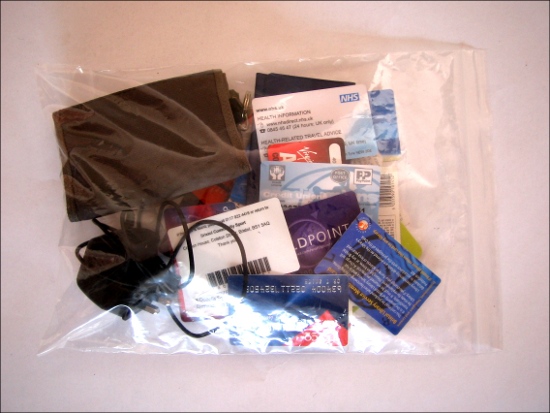
Bunting stresses that these UK identities are lawful and that there is no need for any official consulting or permission from an authority to use or make them. Through this he intends to illustrate a precise codification of class in the UK system. Currently, he defines three classes of identitiy: human being, person and corporate. What class of individual you are places you into categories of evaluation, this process allows others to judge your status, worth and value, within a hierarchy, which is clearly represented in the status maps.
This work touches on issues around our everyday status as a critique, but also as an investigative hack, and plays around with the quagmire of inequality currently in the UK. Inequality is built, constructed into the fabric our societies as an accepted default, through tradition, social or mechanistic, holding in place societal divisions. If there was a status project made in other countries reflecting their own status, worth and value of citizens there would be clear links defining where the connections and divisions lie, between each culture. In fact, another project worth mentioning here is ‘The Spirit Level: Why More Equal Societies Almost Always Do Better’. [13] The authors Richard Wilkinson and Kate Pickett have done their own ‘extensive’, detailed research in highlighting through many different graphs, mapping out inequality around ther globe.
“We know there is something wrong, and this book goes a long way towards explaining what and why.” [14] (Hanley)
Bunting’s work expresses a discipline conscious of agency, autonomy and enactments for self and collective empowerment. Hacking different routes around what at first is seen as too big to deal with, lessens its power and awe. Like Burbank in the ‘The Truman Show’, what we have been told is not real. Bunting knows this instinctively, and is on a quest to upturn each stone to see what lies beneath. But at the same time these facilities created to crack the social, and data orientated codes, are shared. He then leaves the paths he has discovered wide open for others pass through, as we all struggle to survive the ever creeping strangle-hold, of the Netopticon.
———————————————————————-
This article was written for and will be published as part of Heath Bunting’s presentation in Athens ‘Workshop How to Build a New Legal Identity’, May 5th 2012.
During the workshop, Heath Bunting will introduce us to techniques and strategies on how to form new identities. The distribution of the workshop How to Build a New Legal Identity across Europe aims at exploring the characteristics of identity in each country.
Artist’s Talk: May 4, 2012 @ 19.00
Workshop How to Build a New Legal Identity: May 5, 2012 @ 12.00
Frown Tails, 6 Paramythias str, Keramikos, Athens
Organised by: Katerina Gkoutziouli and Frown Tails
It’s a bizarre thing when you stumble upon the “new art movement” filtering through discursive chatter. Is it actually a movement, or is it simply a bunch of like-minded individuals telling me its a movement?
Behold The New Aesthetic then – a new art meme in visual culture whimsically constructed by James Bridle, which manifests itself in a Tumblr blog, a presentation for Web Directions South, Sydney and an original blog post. Recent attention to it has reached feverish proportions coming off the back of a SXSW panel in March and a generally positive endorsement by Bruce Sterling in Wired, plus some group responses on the creators project. More recently, the computational media scholar and philosopher Ian Bogost has posted his own thoughts for The Atlantic.
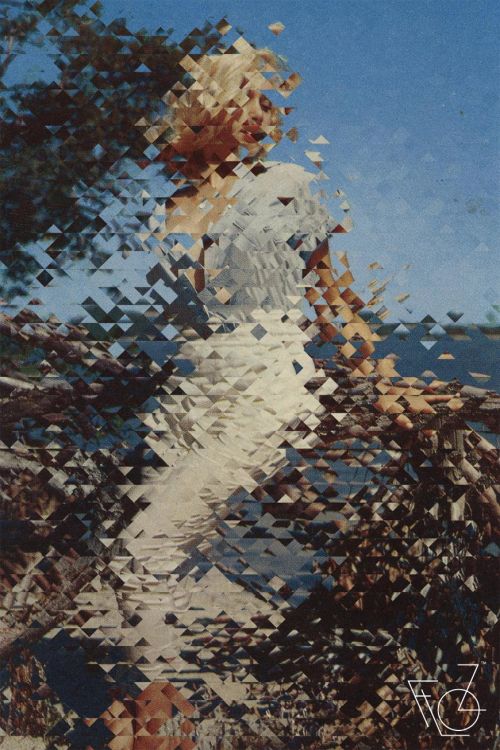
As a meme should do, “the New Aesthetic” has fulfilled its role – it has a lot of people talking about it. Like any meme which dices visual culture with some sort of research element, it has artists, writers, even media and aesthetic scholars measuring their own opinions on it in rank order without anyone knowing exactly where it’s going, what it really is or who exactly is doing it. In our noisy and crowded “I can’t believe I got 50+ retweets” over-networked epoch, this is quite an achievement even if you don’t take it that seriously.
But here’s the question: can the new aesthetic be more than a meme? More to the point, does it want to be? Is it capable of a direction? Can it be serious?
That said (and as Bridle avers) this isn’t really a prominent “movement” of ideas as such. Neither does it present material which it would deem ‘arty’. Instead, it’s an extremely broad and oblique orientation which seeks to document the subtle (and sometimes explicit) changes within our information saturated existence. It simply contextualises the contingent manifestations of computational activity, and how they are reversing and revising computational and human activities back in on themselves. Bridle’s tumblr simply presents the new aesthetic for what it is, much akin to perusing through pictures in a Facebook profile, a Reddit top ten list or clicking on Stumbleupon – simple snapshots of “stuff” which echo a blurring between the world of networks, machines and everything outside of it (with a particular emphasis on where it goes a bit wrong, hence a certain infatuation with glitchyness). Quoting Bridle’s Tumblr page;

“It is a series of artefacts of the heterogeneous network, which recognises differences, the gaps in our overlapping but distant realities.”
In another video presentation ‘We fell in love in a coded space‘ at Lift12, Bridle terms this ‘network realism’ – instances where the amalgamation of computational networked activity blurs with non-computational activity, to such an extent that it reduces any observer to nothing but a curious, passive node, gleefully whittling through instances of vaguely creative stuff. For Bridle, this occurs not just in industry but also architecture, finance, storage, fashion and now an attempt at aesthetic understanding. It’s an infatuation with the alterity of bots, algorithms, pixels and realised fictions. In this presentation however, Bridle is largely concerned with how one can respond or understand the ‘desires’ of bots, unaware that anthropomorphising the situation may not reap the rewards required. In this interpretation the new aesthetic is charged with the task of asking how we can think and orient ourselves computationally, whether it be designers, thinkers, writers, scholars or artists.
Sterling himself, mostly issues praise with a pinch of amusing impatience, as if the New Aesthetic movement should progress faster than it actually is doing, with more ideas and more focus. Kyle Chayka states that artists are already embracing it as a ‘contextual seedbed, rather than a label’. Jonathan Minard understands it as a new method of reflection concerning cultural tool-making, where the ‘dumb tools’ of machinic interface scream images back at us.

Digital Humanities scholar David Berry has blogged a similar view echoing that the new aesthetic is tapping into what he calls ‘Computationality’, a historical paradigm frame-making of sorts, which constructs specific meaning-making practices. Visualisation revolves around processes and patterns and so the list making exercise of Bridles’s Tumblr blog would seem apt in this regard, as it issues unparalleled amounts of pattern making not just as content, but as form. The archive is a jamboree of other pattern recognising events; security face recognition, retro 8bit encapsulation, satellite visuals and generally messing about with an Xbox 360 Kinect. James George mentions something similar but suggests that the new aesthetic should question the critical distance between artistic activity and technological use. It resembles a massive screen dump from a digital artist’s delicious account. Quoting Bridle again in an interview with The Design Observer Group;
“The New Aesthetic is not criticism, but an exploration; not a plea for change, rather a series of reference points to the change that is occurring. An attempt to understand not only the ways in which technology shapes the things we make, but the way we see and understand them.”
To most of the established readers here, it’s easy to criticise the “newness” of the New Aesthetic, in the same way the 90’s trope “New Media” has been quickly bundled away as if it never existed (Marius Watz makes this point). For those of you who have been studying such issues concerning hacking, play, enumeration, collecting, remixing, glitch-ing, (see Rosa Menkman in particular) in the broader realm of the computational arts, there really isn’t anything novel to gawk at: this is more of a rearrange or a rebadge. Indeed, internet discussion has been rife with such criticism, from the triteness of using Tumblr as the ‘official site’, to quick dismissals concerning the New Aesthetic’s distinct lack of any historically serious ‘substantial practice’ – not that it wanted it in the first place (Indeed it’s a pity that it has contingently replaced an identical term for a movement unrelated to Bridle’s own, coined by arts writer Michael Paraskos and realist artist Clive Head. Moreover, depending on how one looks at it, Paraskos and Head’s own movement has similar views espoused by Bridle’s version, including perhaps a direct opposition to conceptualism and foregrounding art as a material practice).
If Bridle were not so sincere about the whole affair, one would be mistaken that this was a too-cool-for-school strategy straight out of a Nathan Barley episode. But thats an easy misread. As Bogost states, Bridle is just curious about the weirdness of the network we all rely on and revel in. But there is a point where fascination with creativity turns into ADHD. The New Aesthetics tumblr site, already does just that, without any hint of standing still. “What’s going to come next? What can we do next? What are the limitations? What happens if I click that? What is that doing there?”
However both Bogost and Greg Borenstein issue a different view about the new aesthetic. They both discuss it in relation to a recent trend in philosophy called Object Oriented Ontology (OOO), a movement to which I am extremely sympathetic to. Bogost explains OOO succinctly enough;
“If ontology is the philosophical study of existence, then object-oriented ontology puts things at the center of being. We humans are elements, but not the sole elements of philosophical interest. OOO contends that nothing has special status, but that everything exists equally–plumbers, cotton, bonobos, DVD players, and sandstone, for example. OOO steers a path between scientific naturalism and social relativism, drawing attention to things at all scales and pondering their nature and relations with one another as much as ourselves.”
The link to OOO is fairly self-evident. If one of the most prominent aspects of the new aesthetic is an obsession with how a machine “sees” the world, OOO is a commitment to the seeing of things in widest possible sense. But while Borenstein generally aligns OOO to the new aesthetic with exuberant equivalence, Bogost’s view is one of general optimism, but not broad acceptance. For a start, the new aesthetics is based on a continual divide and repair between two opposing realms; the physical and the digital, each coming together and breaking apart endlessly, like throwing a box of magnets.
One of the main stipulations of being an OOO advocate is the realist eruption of what counts as a thing, and how that thing contingently relates to different types of entities. This is why Bogost decenters computation in the new aesthetic, and emphasises the multitude of things that escape the physical/digital divide. Their adventures are always-already strewn across the ontological landscape. One of the other main stipulations involves us lacking secure knowledge in fully understanding discrete units on their own terms – we can never experience their being in the same way we experience our being.
If one has read Bogost’s latest publication, Alien Phenomenology (and if you haven’t, I’d urge you to do so immediately), one would understand Bogost’s view that the new aesthetics misses out not just speculating on the hidden lives of objects other than computers and humans, but it also hovers on the inescapable problem of anthropomorphising machines and objects to within an inch of their lives. The alien aesthetics challenge is provocative.
“[T]his Alien Aesthetics would not try to satisfy our human drive for art and design, but to fashion design fictions that speculate about the aesthetic judgments of objects. If computers write manifestos, if Sun Chips make art for Doritos, if bamboo mocks the bad taste of other grasses–what do these things look like? Or for that matter, when toaster pastries convene conferences or write essays about aesthetics, what do they say, and how do they say it?”
There is an interesting discussion to be had in OOO about the usefulness of anthropomorphising the infinitesimal non-human relationships between the properties of things. Whilst others (including Bogost) see it as an inevitable factor of being one finite human entity amongst a crowd of other finite entities, I see it as a hinderance.
In particular, I’m interested in the way the new aesthetic never manages to access computation ‘just’ as it is. It only takes computation seriously when it functions as a qualitatively intelligent system, which meets or surpasses rational intelligence, or, it directly flips into “dumb tools” of (mis)communicative manipulation for the whims of human mental acts.
But I digress. Last year Bridle released a book called “Where the F**k Was I?”, which accurately sums up the mentality of the movement. The really interesting element of the new aesthetic is that it presents genuinely interesting stuff, but Bridle’s delivery strategy is set to ‘gushing disorientation’. At present, it’s the victim of the compulsive insular network it feeds off from. It presents little engagement with the works themselves instead favouring bombardment and distraction. Under these terms, aesthetics only leads to a banal drudgery, where everything melts together into a depthless disco. Any depth to the works themselves are forgotten.
Memes require instant satisfaction. Art requires depth.
The Glitch Moment(um)
Rosa Menkman
Institute Of Network Cultures, 2011
ISBN 9789081602167
Rosa Menkman’s book “The Glitch Moment(um)” is a comprehensive study of the theory, practice and social context of contemporary digital Glitch Art. Glitch Art is similar to the ironisation of the noise of old media into cultural signals seen in Trip Hop and that is the basis for the nostalgic image-making of Lomography or Instagram. But it is based on current digital technology, rather than past analogue technology.
Glitch Art is growing in popularity and critical attention, and is already being recuperated by the mass media (for example in a recent Calvin Klein perfume television advertisement). Analogue glitches have been part of art and popular culture for decades, for example in Nam June Paik’s television-based art or the titular character of the cyberpunk TV show “Max Headroom”. Digital glitches and their simulation featured in the postmodern graphic design of the early 1990s created by groups such as Designers’ Republic. But between a history of analogue media and a future of mass media recuperation there is the current Moment(um) of digital glitch aesthetics that Menkman identifies.
Menkman begins by explaining the basics of Shannon/Weaver information theory as the basis for a theory of what glitches are. In information theory, messages are sent as a signal from a transmitter to a receiver over a channel which is disrupted by a source of noise. This “noise” is the crackle on analogue telephones or on vinyl records, the static on analogue TV and radio, and the corruption that sometimes affects digital images or audio streams (nowadays notably Skype chats).
Where kinds of noise are associated with a particular we can recognise them as particular “noise artifacts”. We can also recognise compression artefacts in digital media such as those seen in over-compressed lossy image and video files (JPEG and MPEG artefacts). These noise and compression artifacts are experienced by the users of communication media as glitches. Menkman describes these phenomena in detail, providing the reader with a firm foundation in the sources and expression of Glitch phenomena.
How artists can deliberately create these phenomena is the subject of the next section of the book. Titled “A Vernacular Of File formats” it is a condensed adaptation of Menkman’s 2010 artwork of the same name. It is a thorough and accessible resource for both understanding the production of and creating visual glitch aesthetics. Each picture demonstrates a technique for modifying the data of an image file format so that a computer can still parse and render the file but it will appear corrupted to a human viewer. Starting with an uncorrupted (but unnervingly contrasty) “RAW” image, Menkman explains the production and principles of corrupted digital images in sufficient detail that the reader can recreate and build on these techniques themself, or use this knowledge as the basis for understanding and appreciating the work involved in the Glitch Art produced by others.
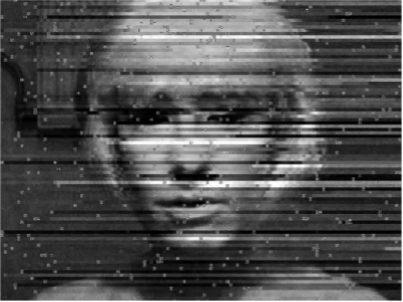
The next two chapters cover the phenomenology and philosophy of Glitch. The theories of Paul Virilio and Alan Liu are usefully deployed here to give Glitch a philosophical grounding. But there is also a recognition that Glitch is an inherently open concept that is difficult to define. Menkman rightly considers the work of Beflix (Ant Scott) as a leading Glitch Art figure. The diversity of Beflix’s work illustrates the problem with categorizing Glitch neatly, or at all. 5VOLTCORE, JODI, and others provide alternative views of what Glitch can be. This builds to Menkman defining “Glitchspeak” as the vernacular, or in possibly the creole, of Glitch Art.
In “From Artifact To Commodity”, Menkman turns to Glitch aesthetics in music, particularly the glitches created through circuitbending, and the precedent this has set for the creation of standardized tools for glitching visual media. As such tools have been created for images, Glitch aesthetics have found their way into the artistic mainstream and into music videos and other mass media. Glitch may be impossible to categorize but it is all too easy to commodify. This marks its emergence as a genre, and Menkman finishes this section by considering Glitch as a recognizable but still problematic genre that relies heavily on spectators’ technical, aesthetic and theoretic literacy.
Having given the reader a solid grounding in the theory, practice and philosophy of Glitch, Menkman finally moves on to its sociology. Using a tool that looks like Gephi but isn’t (Issuecrawler), Menkman models the social network of relationships between Glitch artists that exist on the Internet. Clustering blogs and other Internet expressions by the number of links between them allows the tools of social network analysis to be used, revealing who is central to the Glitch artworld as judged by the clicks of their peers.

Finally Menkman sums up Glitch aesthetics in a section called “The Emancipation of Dissonance Glitch”. Starting with a quote from Jackson Pollock:
“I don’t use the accident. I deny the accident. There is no accident, just as there is no beginning and no end.”
Menkman concludes that “Like the best ideas, glitch practices are dangerous because they generate awareness”. By which point the reader is perfectly placed to understand just how and what kind of awareness Glitch generates, and how they can appreciate or produce Glitch art themselves.
Glitch Art has been long overdue serious critical attention. I cannot remember the last time I read a book that so thoroughly and concisely presented the theory and practice of a contemporary art movement in as does “The Glitch Moment(um)”.
You can download a PDF or order a print copy here
The text of this review is licenced under the Creative Commons BY-SA 3.0 Licence.
“It is not accidental that at a point in history when hierarchical power and manipulation have reached their most threatening proportions, the very concepts of hierarchy, power and manipulation come into question. The challenge to these concepts comes from a redsicovery of the importance of spontaneity – a rediscovery nourished by ecology, by a heightened conception of self-development, and by a new understanding of the revolutionary process in society.” Murray Bookchin. Post-scarcity and Anarchism (1968).
The rise of neo-liberalism as a hegemonic mode of discourse, infiltrates every aspect of our social lives. Its exponential growth has been helped by gate-keepers of top-down orientated alliances; holding key positions of power and considerable wealth and influence. Educational, collective and social institutions have been dismantled, especially community groups and organisations sharing values associated with social needs in the public realm. [1] Bourdieu.
In this networked society, there are controversies and battles taking place all of the time. Battles between corporations, nation states and those who wish to preserve and expand their individual and collective freedoms. Hacktivist Artists work with technology to explore how to develop their critical and imaginative practice in ways that exist beyond traditional frameworks of art establishment and its traditions. This article highlights a small selection of artists and collaborative groups, whose work is linked by an imaginative use of technology in order to critique and intervene into the opressive effects of political and social borders.
In June 2000, Richard Stallman [2] when visiting Korea, illustrated the meaning of the word ‘Hacker’ in a fun way. When at lunch with some GNU [3] fans a waitress placed 6 chopsticks in front of him. Of course he knew they were meant for three people but he found it amusing to find another way to use them. Stallman managed to use three in his right hand and then successfully pick up a piece of food placing it into in his mouth.
“It didn’t become easy—for practical purposes, using two chopsticks is completely superior. But precisely because using three in one hand is hard and ordinarily never thought of, it has “hack value”, as my lunch companions immediately recognized. Playfully doing something difficult, whether useful or not, that is hacking.” [4] Stallman
The word ‘hacker’ has been loosely appropriated and compressed for the sound-bite language of film, tv and newspapers. These commercial outlets hungry for sensational stories have misrepresented hacker culture creating mythic heroes and anti-heroes in order to amaze and shock an unaware, mediated public. Yet, at the same time hackers or ‘crackers’ have exploited this mythology to get their own agendas across. Before these more confusing times, hacking was considered a less dramatic activity. In the 60s and 70s the hacker realm was dominated by computer nerds, professional programmers and hobbyists.
In contrast to what was considered as negative stereotypes of hackers in the media. Steven Levy [5], in 1984 published Hackers: Heroes of the Computer Revolution [6]. In three parts, he writes about the canonical AI hackers of MIT, the hardware hackers who invented the personal computer industry in Silicon Valley, and the third-generation game hackers in the early 1980s. Yet, in this publication, what has had the most impact on hacker culture and is still used widely as a guideline by many is the ‘hacker ethic’. He identified this Hacker Ethic to be a code of practice consisting of key points such as that “all information is free”, and that this information should be used to “change life for the better”.
1. Access to computers—and anything which might teach you something about the way the world works—should be unlimited and total. Always yield to the Hands-on Imperative!
2. All information should be free.
3. Mistrust authority—promote decentralization.
4. Hackers should be judged by their hacking, not bogus criteria such as degrees, age, race or position.
5. You can create art and beauty on a computer.
6. Computers can change your life for the better.
Levy’s hacker ethic promotes the idea of performing a duty for the common good, an analogy to a modern day ‘Robin Hood'[ibid]. Proposing the concept that hackers are self-reliant whilst embracing a ‘healthy’ anti-authoritarian stance, combined with free and critical thinking. Proposing that hackers should be judged by their ability to hack, and presenting hacking as an art-form. Levy also says that the Free and open source software (FOSS) movement is the descendant of the hacker ethic. However, Levy’s hacker ethic has often been quoted out of context and misunderstood as to refer to hacking as ‘breaking’ into computers. This specifically prescribed role, denies the wider and creative context of what hacking is and could be. It does not have to be just about computer security.
This leads us to ‘crackers’. All crackers hack and all hackers hack. But, crackers are seen as second rate wannabe hackers by the older generation of hackers. The Black Hat Hacker or cracker designs and releases malicious code, gathers dangerous information and brings down sensative systems. The White Hat Hacker hunts down and destroys malicious code, and the casual hacker who hacks in order to learn information for his or her own curiosity; both generally dislike ‘Black Hats’ and ‘Crackers’, and tend to view them as computer criminals and dysfunctional juveniles. Lately, crackers have also been labeled as ‘script kiddies’. As a kind of snobbish insult, it refers to those who are not capable of building or programming their own tools, but tend to use scripts and programs written by others to perform their intrusions. To add to the confusion we also have the term ‘Grey hat’. Which refers to a hacker acting between black hat and white hat. Indeed, this could demonstrate where art hacktivists reside, challenging the trappings of the traditional concept of goody and baddy.
“There is another group of people who loudly call themselves hackers, but aren’t. These are people (mainly adolescent males) who get a kick out of breaking into computers and phreaking the phone system. Real hackers call these people ‘crackers’ and want nothing to do with them.” [7] Raymond.
“The basic difference is this: hackers build things, crackers break them.” [ibid] Raymond.
But before we judge,
let’s view a snippet of the \/\The Conscience of a Hacker/\/ by +++The Mentor+++
Written on January 8, 1986.[8]
“This is our world now… the world of the electron and the switch, the
beauty of the baud. We make use of a service already existing without paying
for what could be dirt-cheap if it wasn’t run by profiteering gluttons, and
you call us criminals. We explore… and you call us criminals. We seek
after knowledge… and you call us criminals. We exist without skin color,
without nationality, without religious bias… and you call us criminals.
You build atomic bombs, you wage wars, you murder, cheat, and lie to us
and try to make us believe it’s for our own good, yet we’re the criminals.”
The term ‘Hacktivism’ was officially coined by techno-culture writer Jason Sack in a piece about media artist Shu Lea Cheang published in InfoNation in 1995. Yet, the Cult of the Dead Cow [9] are also acknowledged as defining the term. The Cult of the Dead Cow are a group of hackers and artists. They say the Hacktivism phrase was originally intended to refer to the development and use of technology to foster human rights and the open exchange of information.
Hacktivism techniques include DoS attacks, website defacement, information theft, and virtual sabotage. Famous examples of hacktivism include the recent knocking out of the PlayStation Network, various assistances to countries participating in the Arab Spring, such as attacks on Tunisian and Egyptian government websites, and attacks on Mastercard and Visa after they ceased to process payments to WikiLeaks.
Hacktivism: a policy of hacking, phreaking or creating technology to achieve a political or social goal.
“Hacktivism is a continually evolving and open process; its tactics and methodology are not static. In this sense no one owns hacktivism – it has no prophet, no gospel and no canonized literature. Hacktivism is a rhizomic, open-source phenomenon.” [10] metac0m.
The practice or behaviour of Hacktivism is at least as old as Oct 89 when DOE, HEPNET and SPAN (NASA) connected to (virtual) networked machines world wide. They were penetrated by the anti-nuclear group WANK worm.
WANK penetrated these machines and had their login screens altered to…
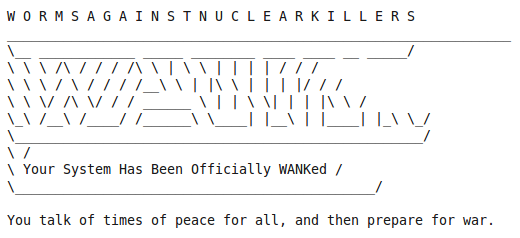
HACKING BORDERS: Examples of Art Hacktivism & Cultural Hacking…
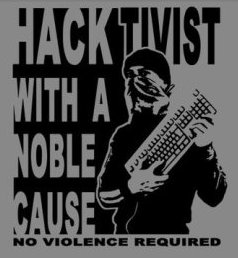
“Radical groups are discovering what hackers have always known: Traditional social institutions are more vulnerable in cyberspace than they are in the physical world. And some members of the famously sophomoric hacker underground are becoming motivated by causes other than ego gratification.” [11] Harmon.
Hacktivism, exploits technology and the Internet, experimenting with the immediacy of distributable networks as a playful medium for independent, creative and free expression. There has been a gradual and natural shift from net art (and net.art) into Hacktivism. Net Art in spirit, has never really been just about art being viewed on a web browser alone. Some of the very same artists whose artwork involved being shown in browsers and making code behind the browser as part of the art, have also expanded their practice outside of the browser. One such artist is Danja Vasiliev, “Fifteen years ago WWW was something very new in Russia and besides the new dial-up aesthetics and world-wide means it brought a complete new layer of existence – “netosphere”, which made my youth.” Vasiliev very soon moved on from playing with browsers into a whole new territory. [12]
Danja co-founded media-lab moddr_ in 2007, a joint project at Piet Zwart Institute alumni and WORM Foundation. Based in Rotterdam moddr_ is a place for artists and hackers, engaging with critical forms of media-art practice. He collaborated with Gordan Savicic and Walter Langelaar from the moddr.net lab on the project Web 2.0 Suicide Machine, which lets you delete your social networking profiles and kill your virtual friends, and it also deletes your own profile leaving your profile image replaced by a noose.”The idea of the “Web 2.0 Suicide Machine” is to abandon your virtual life — so you can get your actual life back, Gordan Savicic tells NPR’s Mary Louise Kelly. Savicic is the CEO — which he says stands for “chief euthanasia officer” — of SuicideMachine.org.” [13]
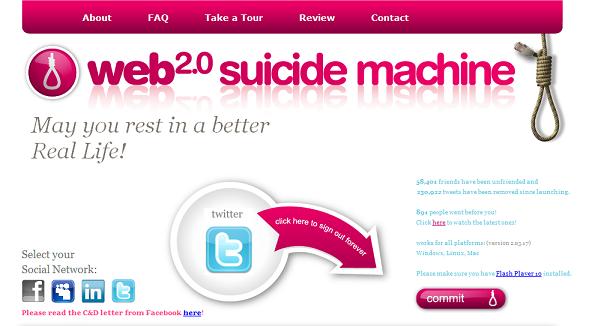
Just like another project called ‘Face to facebook’ that stole 1 million facebook profiles and re-contextualized them on a custom made dating website (lovely-faces.com), set up by Italian artists Paolo Cirio and Alessandro Ludovico, whom also just so happens to be editor in chief of Neural magazine. Web 2.0 Suicide Machine, had to close its connections down regarding its Facebook activities after receiving a cease and decease letter from Facebook. [14]
Julian Oliver and Danja Vasiliev teamed up and formed the mysterious group Men in Grey. The Men In Grey explore our online vulnerabilities by tapping into, intervening into wireless network traffic. Observing, tracing and copying what we do. This hack then redisplays our activities back to us, showing the data of our online interactions.
At first no one (except myself & a few others) knew who they were. When they first arrived on the scene I started an interview with them and then suddenly, I was asked to hold back due to their antics on the Internet and interventions in public environments receiving much coverage. They were not sure how it would pan out for them. Partly due to the anonymous nature of their project, and also because of the sudden impact of the larger hacktivist group Anonymous getting much press in commercial media themselves.
“Men In Grey emerge as a manifestation of Network Anxiety, a fearful apparition in a time of government wiretaps, Facebook spies, Google caches, Internet filters and mandatory ISP logging.” M.I.G
“Spooks are listening into calls, just like they always have,” said Eric King of London’s Privacy International, in an e-mail. “With A5/1 being broken—you can decrypt and listen into 60 calls at once with a box smaller than a laptop.” [15]
Later they won the Golden Nica (1st prize) Interactive Arts category, Prix Ars Electronica in 2011. In a show called Project Space — M.I.G. — Display of unknown, quarantined equipment hosted at the Aksioma Project Space Komenskega, Ljubljana 2011. The statement read:
“The particularly threatening quality of the Men In Grey equipment is its apparently invasive nature; it seems able to penetrate – and even hack into – virtually any electronic device in its reach. While we are all aware of the wire-tapping and data retention done by the government (along with the spying carried out by corporations like Facebook and Google), Men In Grey seem to operate with a range of tools and techniques well beyond those that are currently known to be in use.”
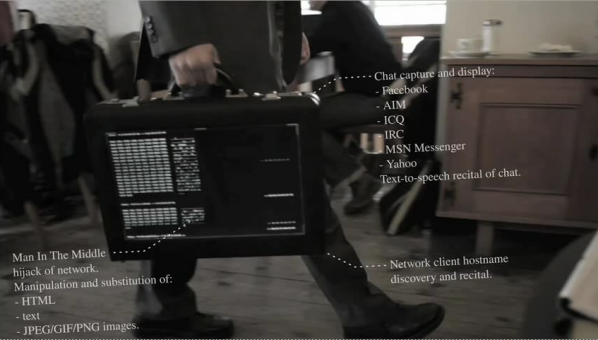
Hacktivism involves many different levels of social intervention and engagement. Whether it is to do with direct action, self-referential geekiness, obscure networked antics, crtical gaming, or peer 2 peer and collective change. Hacktivists challenge defaults put in place by other people, usually the systems imposed upon them and the rest of us by authority. Even though the subjects themselves may be concerning serious matters, humour and playfulness are both essential ingredients.
“A promising tactic for the early Situationists was the unpredictable yet forceful potential of play — what anthropologist Victor Turner termed the “liminoid,” or the freeing and transformational, moments of play when the normal roles and rules of a community or society are relaxed.” [16] Dovey & Kennedy.
One group crossing over from the digital into physical and social realms, is Tiltfactor. [17] Their form of intervention is not necessarily about causing political controversy, but is engaged in reaching people through games of play. Experimenting with social everyday contexts, making games that tackle less traditional topics, such as public health, layoffs, GMO crops. One of the many games creating awareness on these subjects, is POX “Our game actually helps a player understand how a disease can spread from one place to another and how an outbreak might happen” says Mary Flanagan. [18]
A local public health group called Mascoma Valley Health in the New Hampshire region of the US approached Tiltfactor with the problem of the lack of immunization. “At first, a game about getting people immunized seemed like one of the most “un-fun” concepts imaginable. But that sinking feeling of impossibility almost always leads to good ideas later.” [19] Flanagan.
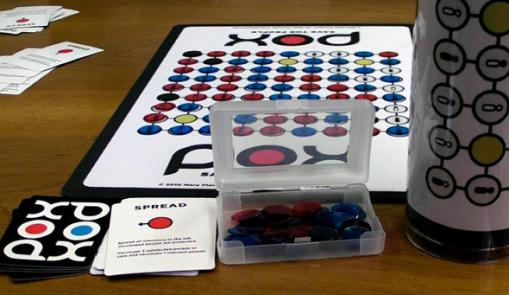
“Geopolitical space has always been a conflicted and fragile topic. Borders and frontiers are changing so fast, that sometimes it seems that our sociopolitical status can change from “citizen” to “immigrant” from one moment to another, or simply live under the “immigrant” status all your life. We’re getting used to words like refugees, enclaves, war, borders, limits –and the list has no end.” Ethel Baraona Pohl & César Reyes
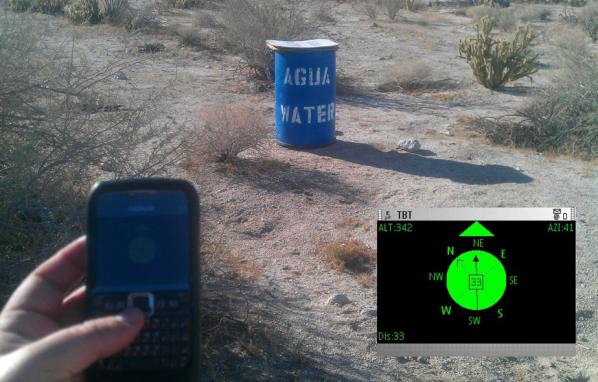
Ricardo Dominguez collaborated with Brett Stalbaum, Micha Cardenas, Amy Sara Carroll & Elle Mehrmand, on (TBT) (and others), on a hand-held mobile phone device that aids crossers of the Mexico-US border. An inexpensive tool to support the finding of water caches left in the Southern California desert by NGO’s for those crossing the border.
“The entire group of artists who are part of Electronic Disturbance Theater 2.0/b.a.n.g. lab working on the Transborder Immigrant Tool (TBT) was being investigated by UCSD and 3 Republican Congressmen starting on January 11, 2010. Then I came under investigation for the virtual sit-in performance (which joined communities statewide against the rising students fees in the UC system and the dismantling of educational support for K–12 across California) against the UC Office of the President (UCOP) on March 4, 2010. This was then followed by an investigation by the FBI Office of Cybercrimes.” [20] Ricardo Dominguez.
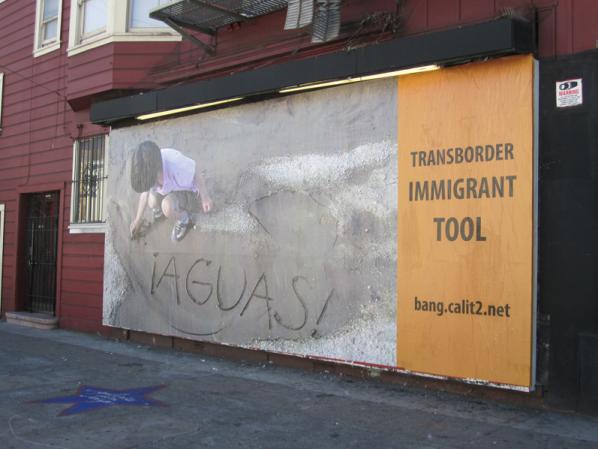
In an interview with Lawrence Bird Dominguez discusses that the TBT is still developing as a gps tool, but infers that it is not just a tool but also ‘border disturbance art’, consisting of different nuances existing as part of a whole with other factors at play. Such as a hybrid mix of things, objects and expressions “artivism, tactical poetries, hacktivism(s), new media theater, border disturbance art/technologies, augmented realities, speculative cartographies, queer technologies, transnational feminisms and code, digital Zapatismo, dislocative gps, intergalactic performances, [add your own______].” [ibid]
“Borders are there to be crossed. Their significance becomes obvious only when they are violated – and it says quite a lot about a society’s political and social climate when one sees what kind of border crossing a government tries to prevent.” [21] Florian Schneider

National borders are front-lines of political and social friction. The exerience of asylum-seekers and political migrants reflect some of the most significant issues of our time. Immigration is a toxic issue and unpopular with voters. Bunting’s BorderXing Guide, plays on the fear of invisible alien hordes of people crossing our borders illegally.
The context of this work fits well with issues about borders, whether it is about creating borders online or physical environments. Only those needing to cross a border are allowed access to the site, it is limited to ‘social clients’ who have a static IP (Internet Protocol) address and who, most notably, have gained the artist’s confidence. Such as peer activists and immigrants using libraries, colleges, cultural centres. The site allows those who would other wise end up crossing borders in harmful ways, such as in containers, on the backs of (and underneath) lorries and planes.
Heath Bunting’s BorderXing Guide website primarily consists of documentation of walks that traverse national boundaries, without interruption from customs, immigration, or border police. The work comments on the way in which movement between borders is restricted by governments and associated bureaucracies. It is a manual written not at distance like a google map, but by foot. A physical investigation, involving actually going to these places; trying these discovered routes out and then sharing them with others. A carefully calculated politics of public relations.
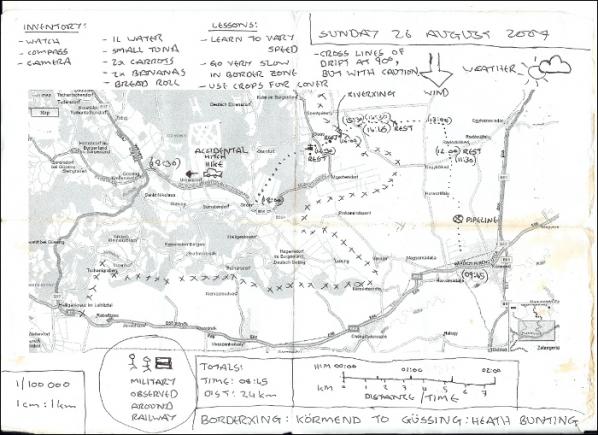
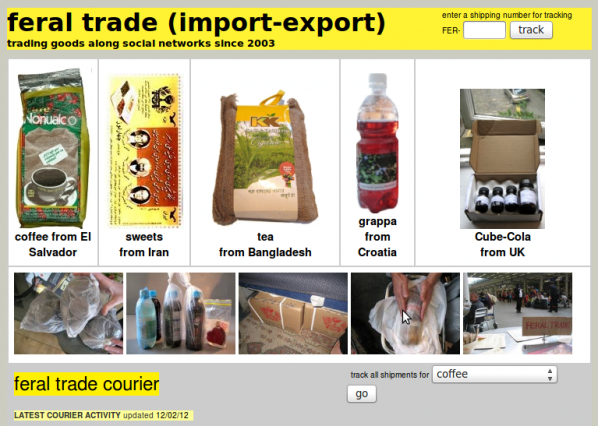
“The Feral Trade Café is more than just an art space that’s a working café, it’s about provoking people to question the way big food corporations operate by looking at the journey of the food we end up scraping into our pampered bins.” [22] Gastrogeek
Feral Trade uses social and cultural hand baggage to transport food based items between cities, often using other artists and curators as mules. Feral Trade products (2003-present), alongside ingredient route maps, bespoke food packaging, video and other artefacts from the Feral Trade network. The goods rangefrom coffee from El Salvador, hot chocolate from Mexico and sweets from Montenegro, as well as locally sourced bread, vegetables and herbs.
Kate Rich uses the word ‘feral’ as a process refering to being deliberately wild, as in pigeon, as opposed to romantic nature wild as the wolf. It is an unruly wild, shitting everywhere, disruption and annoyance in contrast to ‘official’ human structures and connected infrastructures. Feral Trade freight operates largely outside commercial channels, using the surplus potential of social, cultural and data networks for the distribution of goods. Working with co-operatives, small growers and food producers.
The Feral Trade Courier is a live shipping database for a freight network running outside commercial systems. The database offers dedicated tracking of feral trade products in circulation, archives every shipment and generates freight documents on the fly.
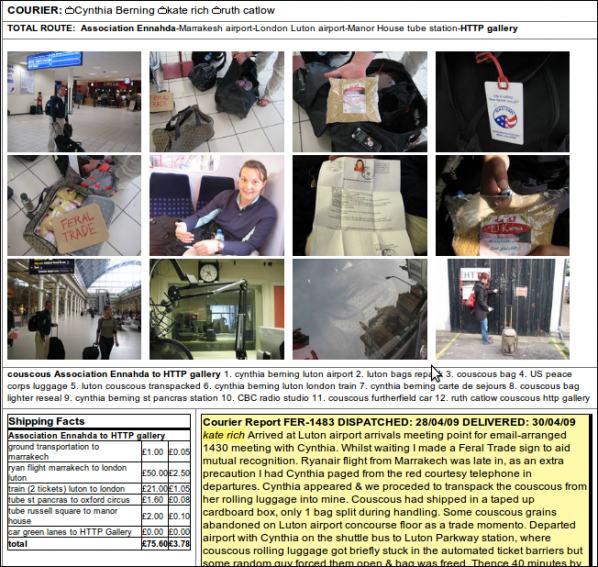
Every shipment is different and has its own story of how and where it was delivered from. Also included is information on who the carriers are with details about producers and their local culture as contextual information. The product packaging itself is also a carrier of information about social, political context and discussions with producers and carriers.
![Feral Trade at Furtherfield's Gallery (2009) [23] Link to exhibition](http://www.furtherfield.org/wp-content/uploads/2012/03/3657297700_42b1c26014_b.jpg)
Since the rise of the Internet individual and collective actions are symbiotically connected to the every day. In a world transformed, common people have access to tools that can change ‘our’ cultures independently; sharing information, motivating actions and changing situations. We know of the Arab Spring, the Occupy movement, Anonymous and Wikileaks and how successful they have been in exploiting technology and social networks. Technology just like any other medium is a flexible material. By tweaking, breaking and remaking ‘something’ you can re-root it’s function, change its purpose.
The links between these mass social movements and the artists here are not just relating to technology’s use but, a shared critique at the same enemy, neo-liberalism.
“”Neo-liberalism” is a set of economic policies that have become widespread during the last 25 years or so. Although the word is rarely heard in the United States, you can clearly see the effects of neo-liberalism here as the rich grow richer and the poor grow poorer.” [24] Martinez & Garcia.
At the same time as highlighting the continual privatization of human society. This form of art practice shows us the cracks of where a social divide of gate-keeping has maintained power within the Western World’s, traditional art structures. We now realize that the art canons we have been taught to rely on as reference are more based around privelage, centralization and market dominance rather than democratic representation or even just pure talent. Hacktivist artists adapt and recontextualize with a critical approach, towards a larger and more inclusive context beyond their own immediate selves. Demonstrating a respect and use of autonomy, and an awareness of social contexts and political nuances, freeing up dialogue for new discussions which include a recognition of social contexts, as a vital ingredient and valued resource in art. Re-aligning, reconfiguring the defaults of what art is today.
Featured image: ‘Promised Land’ design of transmediale 2k+12
Everything is not connected was the title of one of the talks organised as part of the in/compatible symposium at transmediale 2k+12 (2012), precisely the keynote speech of Graham Harman for the section titled systems. But this year’s programme of transmediale was all about connectedness, or I’d better say, about a curatorial structure of connectedness and subtle linkage.

The festival’s format was one of visual and conceptual reminders, and this became evident at the very beginning and during the opening ceremony, in the auditorium of the the Haus der Kulturen on the 31st January.
At the moment of opening a power point presentation, the new artistic director Kristoffer Gansing seemed to experience a technical problem as his file would not open. A technical assistant was then called on stage to fix it, and while we all giggled and looked at each other thinking that this was somewhat like a paradox for a festival devoted to the exploration of art, technology and media culture, we soon realised that the dooming technical failure was a pretext for one of the Prepared Desktop performances by glitch-artist jon.satrom.
Thus, from the very start, we experienced what Gansing often defined as a festival which “is an incompatible being”, suggesting that the 25th edition of transmediale would be different, perhaps more oriented to a multidirectional engagement with its audience and, surely, aimed at making us aware of how much technology is intrinsically part of our everyday lives – physically, mentally and also politically. It seems that Gansing had worked towards making us feel like explorers in order to experience what he described in his curatorial statement as the “in/compatible moment”, the “moment of stasis” resulting from the clash between things that were supposed to flow and converge peacefully within a system. That unforeseeable clash generated by an incompatibility which, according to him, is to be seen (and perhaps also sensed) as a moment full of potentials, as a gap which allows a new rearrangement of the elements of a given system – be it artistic, social, economic or political.
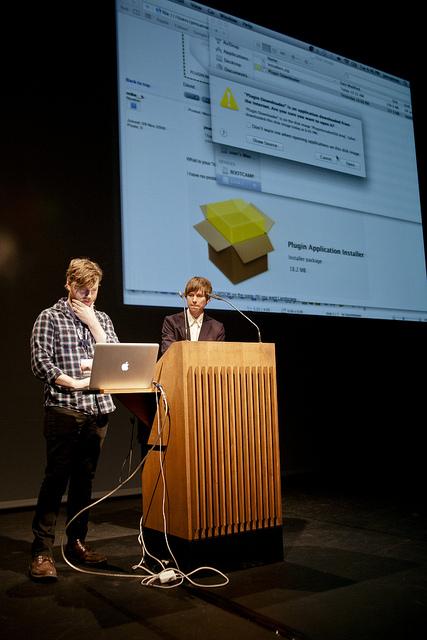
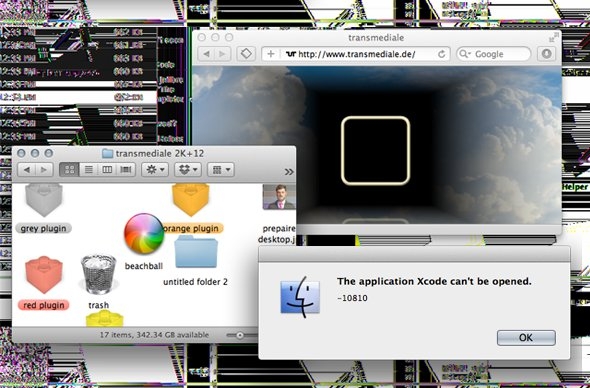
This ‘curatorial tactic’ marked the rich programme of transmediale 2012, which spanned from exhibitions to academic research networks, from online artistic interventions to talks and live performances – worth a mention is also the overall design of the festival’s contextual material, called the Promised Land design theme, which with its retro digital-pop aesthetic [1] seemed to have been devised to reinforce the idea of the clash, the tensions at work within the notion of technological convergence (“the myth” of contemporary society), starting from the very aesthetics of it.
The connectedness I mentioned above is very tangible when looking back at the main themes discussed at the in/compatible symposium – which was divided into three thematic segments:
systems, publics and aesthetics – in that they could be found as extensions across the whole programme, which in turn was developed across six sections:
1- the exhibition Dark Drives. Uneasy Energies in Technological Times curated by Jacob Lillemose
2- The Ghost in the Machine performance programme curated by Sandra Nauman
3- the video programme Satellite Stories curated by Marcel Schwierin
4- 25 Years, a series of events, amongst which talks and video screenings, about “areas of conflict between old and new” that were devised to mark the 25th anniversary of the festival
5- Featured Projects, a series of special parallel projects, such as web-based and site-specific
interventions
6- last but not least, the new addition of reSource for transmedial culture, an “interface between the cultural production of art festivals and collaborative networks of art and technology, hacktivism and politics” presented as a series of ongoing events (workshops, discussions, lectures and performative interventions) curated by Tatiana Bazzichelli.
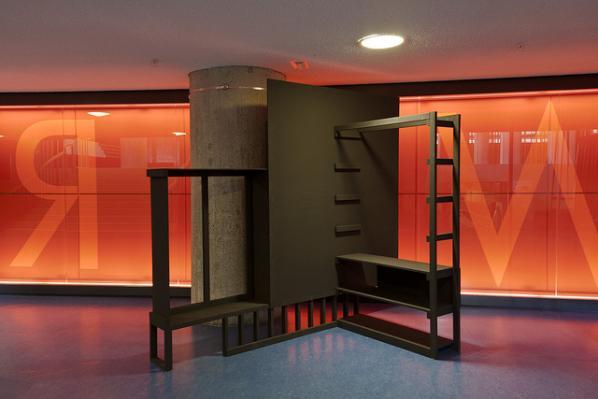
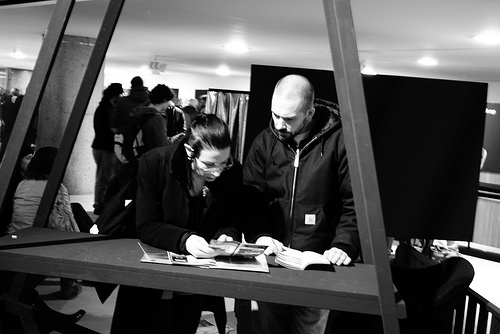
Taking a step back to look at the overall thematic framework of the festival before digging into the specifics of each programme, what should be emphasised is the effort that was made to strengthen the transdisciplinary nature of the festival as a whole. In fact, each section of the programme inserted itself into the wider discourse of cultural production; putting a stress on how deeply technology is intertwined with the every day while looking at the relationship between art and technology from a socio-economic and political perspective that was permeated by an historical orientation. And the latter is precisely what makes this 25th edition different from those I had experienced before.
Gainsing’s perspective – as it was often stated by his collaborators throughout the festival – is that of a media archeologist; and in this sense he occupies a specific place in the media theory-scape of the city of Berlin, which houses the Institute for Time Based Media (Berlin University of Arts) where Siegfried Zielinski is the Chair of Media Theory. As many might know, Zielinski is the theorist who coined the term (or better still, founded the field of) media archaeology with his book Deep Time of the Media (MIT Press, 2002). I would then say that the methodological approach of the artistic director, as well as that of the four festival’s curators, was the one which looks at a present “linked to a past pointing at a possible future”, adopting a perspective that is different and finds “something new in the old” rather than seeking “the old in the new” (quotes from Zielinski, 2002). This is probably the reason of the festival’s holistic character, of the existence of critical and aesthetic linkage between the various panel discussions and performances, research projects and art installations.
This year’s symposium, across three different but converging angles, looked at the tension between functionality and disruption in order to address how the gap existing between the two has been (and could be) “productively used” by artists, as well as by society at large, in relation to available technology – mostly digital and web-related.
The strong connection existing between all panels – grouped under systems, chaired by Christopher Salter; publics, chaired by Krystian Woznicki; aesthetics, chaired by Rosa Menkman– was given by the historical approach of their explorations into the present. Their positions were those according to which it is not technology that impacts society, but it is almost the reversal: it is society – and artists – who, with their behaviours and actions, transform it, generating a new language and new possibilities within established systems, or failing systems. One way to embrace this type of perspective was described by Graham Harman in his keynote speech: it is through differentiating “between background and foreground” and bringing the latter “into consideration”, through accepting obsolescence as something inherent to the state of the technological thing and through embracing the fact that mediums change, that new ways of thinking and understanding reality can be established.
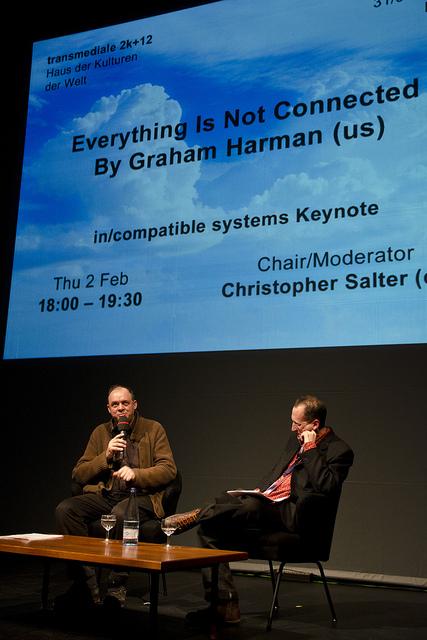
In this regard, the in/compatible aesthetics panels brought about interesting paradoxes in relation to media archeology and technological historicism, such as the necessity to move away from nostalgia for the past and avoid what could perhaps be termed as techno-romanticism. Through a series of panels, spanning from Uncorporated Subversion. Tactics, Glitches, Archeologies to Unstable and Vernacular. Vulgar and Trivial Articulations of Networked Communication, this section of the symposium presented a variegated array of artistic and research practices (from artist Olia Lialina to media theorist Jussi Parikka) that are concerned with establishing methods for challenging given systems, their codes and protocols, in order to establish new languages and modes of operation. All of them presented different artistic scenarios embedded in current socio-cultural frameworks, stressing the fact that “cultural history is shaped by users more than its inventors” (quote from artist and programmer Dragan Espenschied‘s presentation during the Unstable and Vernacular panel).
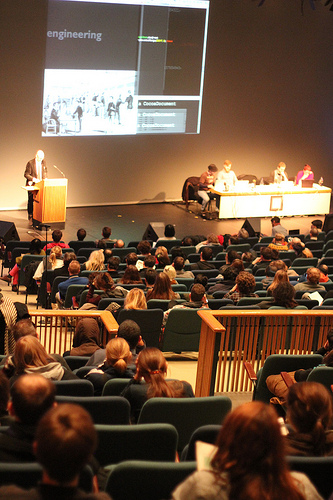
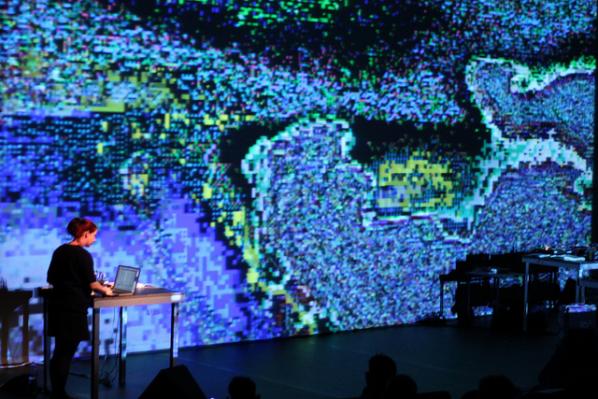
The publics section dealt with “forms of activism and social resistance” that emerge from incompatibility with the economic-political systems. In the instance of the Norifumi Ogawa in his talk Social Media in Disaster, during which he gave a very detailed insight into the “productive and effective” uses of social media during the recent Japanese earthquake and the consequent accidents at the Fukushima’s nuclear plant.
According to the exhibition curator Jacob Lillemose, Dark Drives “explores the idea that uneasy energies exist in technological times” and offers “a thematic reading and an historical mapping of the last fifty years, expressing a critical attitude to existing phenomena as well as exploring possibilities of reinvention”. And it does so with “no promise of overcoming” them (quotes from Lillemose’s curatorial statement).
In fact, the exhibition included works by 36 artists spanning different cultural fields as well as periods. The inclusions ranged from Ant Farm’s Media Burn, Chris Burden’s Doorway to Heaven and William S. Burroughs/Antony Balch’s The Cut-Ups (late 60s and 70s) to Art 404’s 5 Million Dollars 1 Terabyte, Constant Dullaart’s Re: Deep Water Horizon (HEALED) and jon.sotrom’s QTzrk (2010/2011), all while moving through the practices of artists attached to the net.art movement, such as Heath Bunting’s Skint – The Internet Beggar and JODI – the latter with a new light installation, LED PH16/1R1G1B, dated 2011–. Included were also works produced in the 80s by music bands like SPK with their Information Overload Unit. Not only, but the show also presented works which are usually not associated with the conventional art circuit, such as the TV programme Web Warriors produced by Christopher Zimmer (2008) and the music video Come to Daddy by Chris Cunningham/Aphex Twin (1997), along with, as a reversal, old(er) media-oriented work, such as the series of computer prints Leaves by Sture Johannesson, which can be read as early pieces of conceptual art.
This condensed list is to say that the amount of artistic and cultural material on display in the exhibition and the trajectories that it opened were broad to such an extent that Dark Drives functioned more as a general narrative survey than a show with a clear proposition. It was a survey of how uneasy energies might materialise as consequences of the modes and methods in which technology is used and understood, with no much distinction drawn between technology in electronic, computational or digital times.
Dark Drives did not aim to address further its initial statement, nor to narrow down the kind of relationships (and their reasons) between historical instances and contemporary ones; and from my perspective this was its flaw. However, this is the kind of exhibition that a festival like transmediale eventually needed, because to my knowledge this sort of display and curatorial approach had not been presented before: an exhibition which finally embraced the inclusion, with no hierarchies or differentiation in terms of choices of display, of works conventionally shown in gallery spaces along with those traditionally related to (ahem) the still-existing ‘niche of new-media experts’.
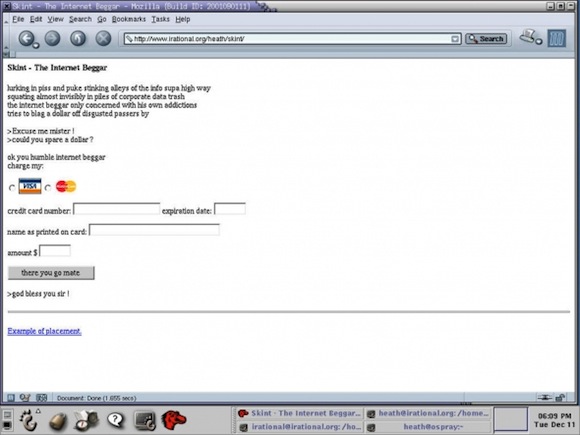
Dark Drives might not be a very daring exhibition if placed outside the context of a media art festival like transmediale, but it is certainly almost subversive in this context, and in comparison with its precedents. The exhibition installation was clever and atmospheric and, as it was for the festival’s format, it was dotted by visual and aesthetic reminders. I’ll give you an example amongst many and various ones that you could have spotted in the show: formulas by Peter Luining (2005), which is a video about manipulating a screen-grabbed image in Photoshop till it becomes a black screen, was shown just a work before jon.sotrom’s Qtzrk (2011), another video based on the process of image deformation – in this case through the use of QuickTime 7; the latter, was, in turn, shown just another work before Heath Bunting’s Skint – The Internet Beggar (1996), a website that operates as a service through exploiting the potentials offered by the network system. The three works all adopted the framework of computer desktop as a display platform for their artistic interventions, but also as a production space. And although each artist’s agenda and research area were different, their proximity made these distinguishing elements more evident, highlighting various ways of activating modes of production that diverge from those of the system within which these artists operate.
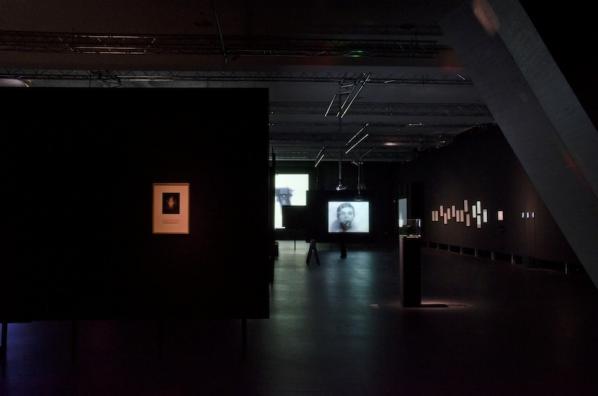
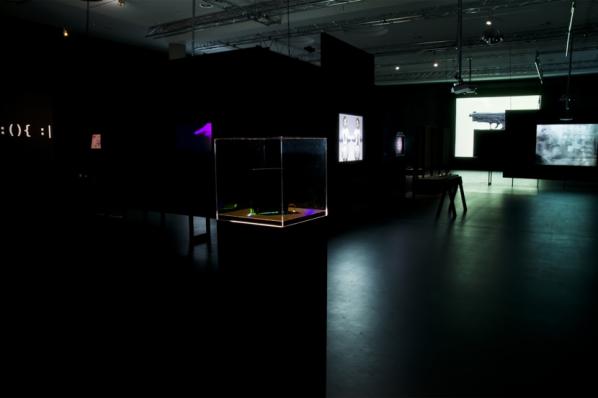
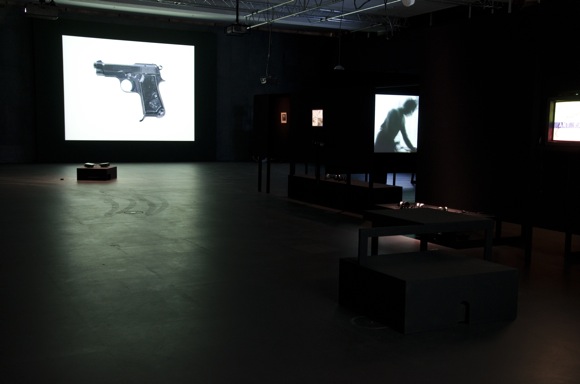
Similarly to what I have just described, it was Dark Drives as a whole that guided the visitor all the way through its display towards specific thematic directions, which were suggested by the installation in conjunction with the many visual and aesthetic links. But simultaneously, the visitor would also be free to follow the other and many trajectories arising from the content of each specific work, and this flexibility made the exhibition an attractive narrative territory ready to be employed for further explorations.
This section of the programme has been devised as an ongoing project by curator and researcher reSource is an initiative that started before transmediale festival with the gathering of an international network of PhD researchers for a conference and workshop held at the University of Arts in Berlin last November. The outcome of this collaborative network was launched on the second day of the festival, in the form of a research newspaper titled World of the News – Thank you & Goodbye . This newspaper operates as a platform in which an array of researcher, most of whom practising artists, presented a series of essays and interviews looking at the “unresolved questions and paradoxes of media technology” and how they might impact (and redefine) not only artistic production but also research processes and academic conventions, such as peer-review systems or the definition of what is currently accepted as ‘proper research’ within the academia.
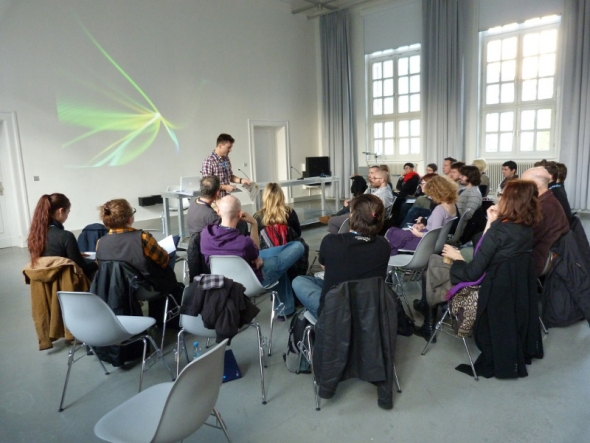
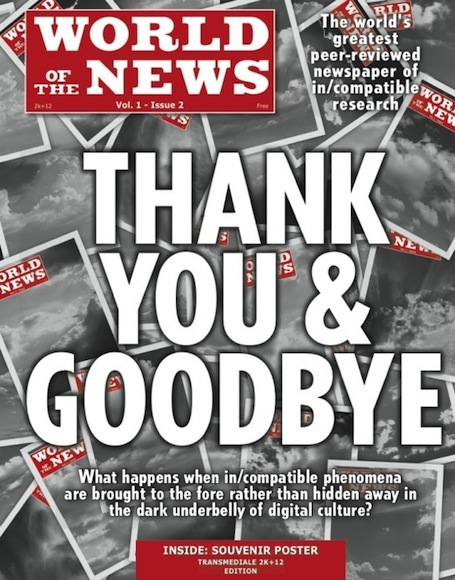
World of the News gathers a very well-thought through research material, and it does challenge academic formats, bringing forth the necessity (and preciousness) of collaboration and dialogues across disciplines, forms and formats.
The above is only one of the activities that were part of reSource; in fact, its programme was divided into five different sub-themes, Methods, Activism, Networks, Markets and Sex, each of which ranged from panels to presentations and workshops.
One of the proposed panel was titled Coded Cultures – Sub-Curatorship Beyond Media Arts and drew on a previous event organised by the group 5uper.net in Vienna, Coded Culture: The City as Interface (2011). Although aimed at addressing questions about curatorship and media art festivals, thus the public sphere, I wonder why curatorship as a practice within the field of new media and, supposedly within what was termed as “beyond new media art”, were not discussed more in depth, especially given the changes that transmediale exhibition itself proposed. If Joasia Krysa presented her specific approach to curating as a system that is informed by technology and thus embraces its inherent systems, like software codes and protocols of Internet and digital technology, in order to change the hierarchy of power; the other invited curators seemed to lack a depth in the discourse. The whole panel unfortunately stranded in general statements such as “technology changes the role of the curator” or “the curator does not want to define itself as a curator anymore, but as a coordinator and a producer”; a cliched conversation that – opportunely – ended with Krysa throwing on the table of discussion Christine Paul’s definition of “curator as filter feeder”.
Many other were the events presented at transmediale, such as the visually stunning, and purely analogue, performance of Joshua Light Show for the The Ghost in the Machine performance programme . At different times during the week of the festival Joshua Light Show performed with different musicians, such as the one man band Oneohtrix Point Never, bringing to light the beauty and magic that old(er) media can (still) give to a public of a “transmedial” festival.
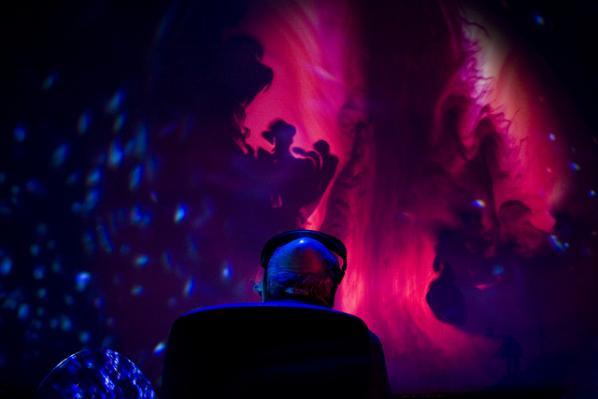
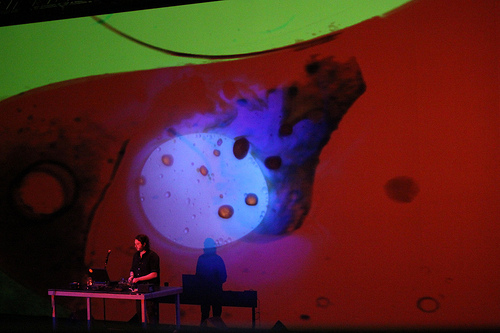
As a final round-up, it is also to be noticed that in/compatible embraced slightly more extensively the sphere of online production and distribution, specifically in conjunction with the 25 Years, Satellite Stories and Featured Projects programmes.
If when browsing the transmediale website you experience some strange episodes, such as pages merging into each other when scrolling up and down, that is because of a site-specific intervention by Danja Vasiliev and Gottfried Haider – the developers of a Content Manipulation System called HOTGLUE which allows to construct websites directly in a web-browser.
Also as part of 25 Years there was a video installation <collaborative documenting / archiving on netart.activities> initiated by artist Constant Dullart and art historian and artist Robert Sakrowski. The duo had devised an open database system which employes YouTube as a repository for net.art projects. This project tackles issues related to hardware and software obsolescence in relation to the (often impossible) access to early net.art projects, and proposes a way of archiving them by filming an ‘audience-in-action’ during the browsing; a strategy which is also useful for tracking users’ behaviours and thus highlight the changes brought about by technological development. Dullart and Sakrowski also led a workshop at the transmediale headquarter, as well as presenting their work during the panel discussion web.video the new net.art?.
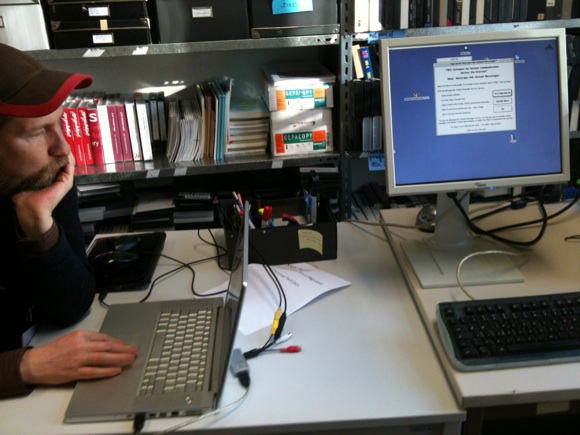

As a last mention, the video programme Satellite Stories was launched at the opening night with Screening Re-enactment Videospiegl, a looped video screening which connected the present of the festival with its history, its archive. In fact the festival first opened in 1988 as VideoFilmFest, and the Videospiegl selection of early videos is now accessible on transmediale website; hopefully marking the start of an archive which will be online and for all.
The online activity described here is certainly not enough for a festival like transmediale, which should investigate thoroughly the relationship between art festivals, artistic production and online distribution; but at least it seems a start for what is a much needed new exploration to be carried out by the organisers.
There is one more issue that I feel was only and often superficially addressed by this edition of transmediale. There were many mentions, in theory, of capitalism and its ramificated systems, such as the closeness of network systems which before were open and the consequent failure of techno-utopian ideals. However, there was little evidence of this in the artworks on display, nor in the site-specific installations presented. I don’t support the idea that artists should be literally political, or activists, but when I experienced jon.satrom’s performance at the opening, it came across as a sort of exercise in showing what can be done through bending technology to generate new languages and approaches to that which is established. In a way it reminded me again that we often operate within boxes, and rarely attempt to challenge the form and format of what is given to us. But then, most of us already know this. And although in/compatible as a festival did not want to give answers but generate a context for formulating questions, as Gainsing specified in his presentation, I felt the need of a next step, a step made of actions, which to me was only fully present in the reSource programme of Tatiana Bazzichelli. When I rethink of jon.sotrom’s performance, and I am very aware I am using him as an example to point to a larger scenario (my apologies to the artist!), I cannot refrain from thinking that the system he was challenging was that of an Apple Macintosh software, built on visual tricks like Spaces, Mission Control, etc; a system that perhaps needs to be challenged at a deeper level since, for instance, its reliance on the exploitation of developing countries workers?

This is just a final thought.
That said, I am really looking forward to seeing how transmediale will move forward, will it take the next step from this initial change?. It will be interesting to see how this merging of historical perspectives, academic research and artistic innovation will stir up more conversations and, as I said, more actions for another exploration of the relationship between contemporary cultural production, media and technology.
Please note: since the richness of the programme, I have highlighted my personal experience of the festival, so that this review highly reflects the choices I made about what to attend and what I (unfortunately) left out from my jammed daily schedule.
The video works of A Bill Miller seem to be at once futuristic and something recalled from our childhood (those of us who grew up with computers in some form or other) in what might be considered as a hauntological affectation that seems like a memory of the future from our childhood, with lines and simplicity of many early computer programs, forming complex ghosts of our pasts across the screen. These are a reminder that what computer graphics can do, doesn’t have to be composed of 3D, with million of vectors and a painful, failing attempt at verisimilitude. Just as theatre, with it’s artificial simplified set designs and symbolism. It can sometimes be more real, offering a greater empathy than a well designed and directed film. Often, there can be greater beauty and compulsion when engaged in simple works than those of greater complexity.
“We exist within a built environment that is constantly mediated by the grid. Grids organize space through coordinate mapping and patterns of development. Grids compress, redisplay, and reorder information. Grids are an enforcement system imposed upon both nature and culture. I respond to this ubiquity by creating gridworks. These forms examine the blurred boundary between the machine and the human – the tool of data collection and the interpretive mind.”
Like a lot of people, my first encounter with the work of A Bill Miller was on the small screen. Despite the numerous festivals and exhibitions that his works have appeared in1, this may be the only chance viewers have to enjoy them. Which is a shame because they really work well when expanded on to a larger screen. Even if you only get to view them on a larger television screen, it’s worth doing. Even some of the work that is small in scale and scope, benefits from being shown on as large a screen as possible. It takes a broader and more encompassing screen to really engage the viewer completely into the work. For some of the black and white work, the overlaying of ASCII letters (reduced to just shapes when not ‘read’ as alphanumeric characters) shows how some works can explore the technical palette of the production software as possible. Which isn’t to say that some of the works aren’t also complex and (literally) multilayered.
There is a psychic landscape explored in Miller’s works. A landscape that feels as though it sits just behind the everyday, observable world we inhabit. Not in a David Lynch, behind the picket fence, kind of way, but inside the mind’s eye, at a point where the brain hasn’t yet coalesced the datastreams of visual stimulation into a recognisable image. It’s that in-between space that seems to at the heart of some of the Gridworks: the spaces between being held in check by the grids. And clean white spaces are beautiful in themselves, but they also divide the elegance of those lines so that the work is about those spaces and the tension of being held in check: stopping them from bleeding into one another. The psychic landscape they map out is the same one that we have to face everyday as we negotiate our way through the ongoing datastream of western life. Work, rest, work, rest, shop, consume. Those days that you feel as though you’ve experienced and understood everything and life begins to blur into one continuous event: all it takes is to step back and really focus on individual moments to remind ourselves that life is actually full of thousands of unique and wonderful moments.
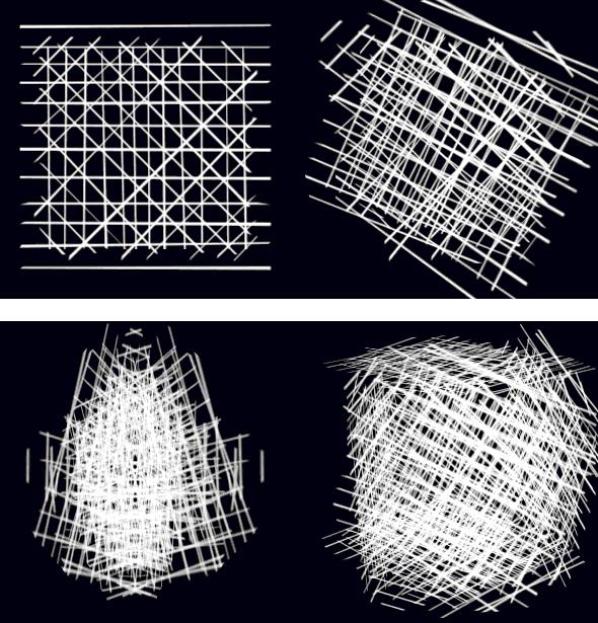
Works like Gridfont 7 suggest that the elegance of a few lines carefully placed can lead to great complexity through simple juxtaposition and rotation of basic forms. Just like so many other things in life, greater complexity begins to emerge from a gradual build up of even the simplest of those elements. Some of the work begins as a few short, hand-drawn lines before they re-adjust themselves and become a hive of geometric shapes: a honeycomb forming from the arrangement and connection of lines. Some works have the colour-bleed of early video work where over-saturated colours refuse to hold their place in the ordered spaces and begin to wander slightly.
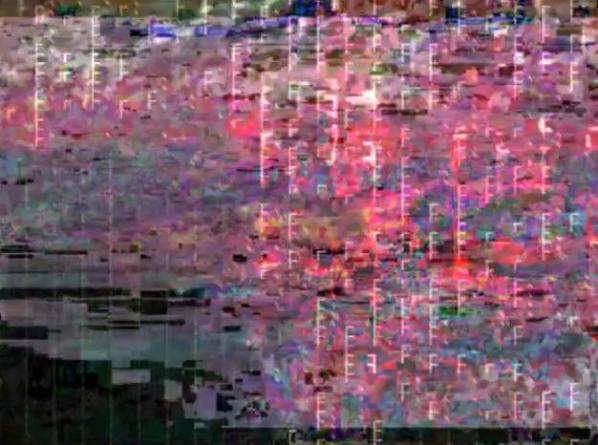
gridworks_textanimation2010 is made from pure ASCII text characters, and “transmits an unreadable message that is aesthetic and abstract.” It’s stark black & white play of the non-text elements of written communication gives the impression of loss and emptiness, like lines of communication broken down through digital channels. This could be extracted from a relationship being held together via email or it could be text messages sent between two unreliable narrators each hoping to convince the other of some shared moment. A line of Xs brings to mind censorship but the blank underlines suggest space for the other party to fill in the blanks that we don’t always admit to when trying to maintain the peace in a relationship. Things are constantly being said, but nobody is ever saying anything to each other. Those are the worst accusations of Internet communications but they’re just as guilty of being performed in every other channel. They just become more visual on the Internet and even more so in works like this.
In case these descriptions suggests that the works are dry and overloaded with metaphor and meaning, they can be enjoyed on their purely aesthetic merits. Gridworks2000-anim09 is a work that can only be described as beautiful in its elegance and deceptive simplicity.
Although these works are positioned within media art, they (like many moving image art work) could be considered as cinema (and let’s face it, cinema could do with a fresh burst from a ruptured blood vessel right now). These are part of a cinema of special effects where the use of computer graphics enhances the moving image and steps away from verisimilitude. As mentioned previously, this lack of verisimilitude is part of the reality of these works. An added element of what makes them hauntological ghosts within the screen.
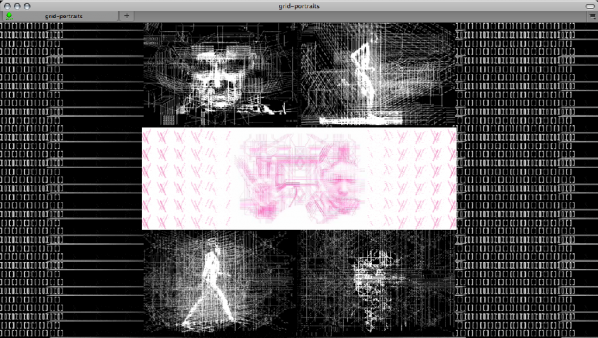
It’s imprinted into the very nature of cinema that it is a ghostly illusion or special effect, either computer generated or produced in the camera that belongs to every moment of cinema’s history. In fact it is even an illusion to believe that we are viewing an actual moving image when we watch a film or video. Either way, cinema is created on-the-fly by our own eye. The trick of creating moving images is to know how the brain responds to them and leverage that response to your own desires. The cross slicing of lines in Miller’s Gridworks feels so much like early computer graphics that at times it’s hard to step beyond thinking about technology’s desire for the new and the increasing momentum of the special effect algorithm and find the beauty in their simplicity. It’s in there and doesn’t take much effort to uncover. Like a good oyster in a restaurant, the reward can be unusual and pleasurable, but you have to get in and expend some energy to extract it.
FILE RIO 2012, Electronic Language International Festival, Art Galery of Oi Futuro, Rio de Janeiro, BR, Mar 12-Apr 8th
Scan2Go, New Media Caucus year long online exhibition, Released at CAA 2012
<terminal> monitors, Austin Peay State University, Clarksville, TN, 2/20-3/2
A/Vworkssssss, One Night Event/Performance, Borg Ward Collective, MIlwaukee, WI Jan 3
Streaming Festival 6th Edition, Het Nutshuis, The Hague, Netherlands, Dec. 1-18 2011
FestivalMulti2011_Especial – Curator David Quiles Guillo, Video Art Program, Rio de Janiero, BR, Nov-Dec 2011
Sheroes, One-Night Interactive Installations (Monthly), Toronto, CA, Nov. 18 and Dec. 23
GLI.TC/H Chicago – Live Video Performance, Chicago, IL Nov. 3-7
GLI.TC/H Program at FLIP Animation Festival, Birmingham, UK, Oct. 29
Punto Y Raya Festival, Museo Reina Sofia Madrid, November 3-6, 2011
BYOB Sao Paulo, Rojo Nova Sao Paulo, Oct. 29
Video On Paper Zine http://videoonpaper.tumblr.com/
3ra Convocatoria Belica, Valencia, Venezuala, September 2011 http://mvs.260mb.com/index2.html
I AM NOT A POET Festival, Edinburgh Aug.8-21 http://tkunst.wordpress.com/
On 28th October 2011, I travelled to Sète in the South of France to see and review Annie Abrahams’ show Training for a Better World.
The first of two reviews (the second will be somewhat longer and in an academic journal later this year) is now available on DVblog.
What was particularly pleasing about going to the press view and then staying on for the opening proper was the opportunity to engage with the work over quite a long period – some four hours.
About halfway through the evening, I started both photographing and sketching as aides-memoire for my reviews, but I soon began to enjoy the feeling of responding to the work for its own sake, and I began to think about presenting the drawings and photographs (plus some drawings made from the photos two days later, as well as a couple of manipulated photos) as a kind of photo-essay/derivative work.
Face to facebook is the final project in a three part series named “Tha Hacking Monopolism Triology” by the two Italian artists Paolo Cirio and Alessandro Ludovico. It was launched on the 2nd February 2011, with a mixed media installation at the Transmediale festival in Berlin, and a press release announcing a new dating website called lovely-faces.com.
The set-up for the ‘Face to facebook’ project was to steal 1 million facebook profiles and re-contextualize them on a custom made dating website (lovely-faces.com). The data collected from the profiles was only information available publicly on the internet, like the users name and profile picture. No facebook account was needed to access it. The 1 million facebook profile pictures were then checked for images that were usable in a dating webstie context. The remaining 250,000 profile pictures were then fed through various face recognition filters to assign an assumed personality to the subjects and a new profile was created ready for the dating website. Once published on lovely-faces.com, interested pursuers could get in contact with the people behind the original facebook profiles through facebook messages.

On the 10th February, 8 days after its launch, the dating website lovely-faces.com was shut down. This was following a cease and decease letter from Facebook[1]. Back in 1999, the net artist Heath Bunting was also subject to a cease and decease letter, that time from American Express. The letter sent to Paolo Cirio and Alessandro Ludovico in 2011 (as PDF) can be seen here, and the letter sent to Heath Bunting in 1999 is published here.
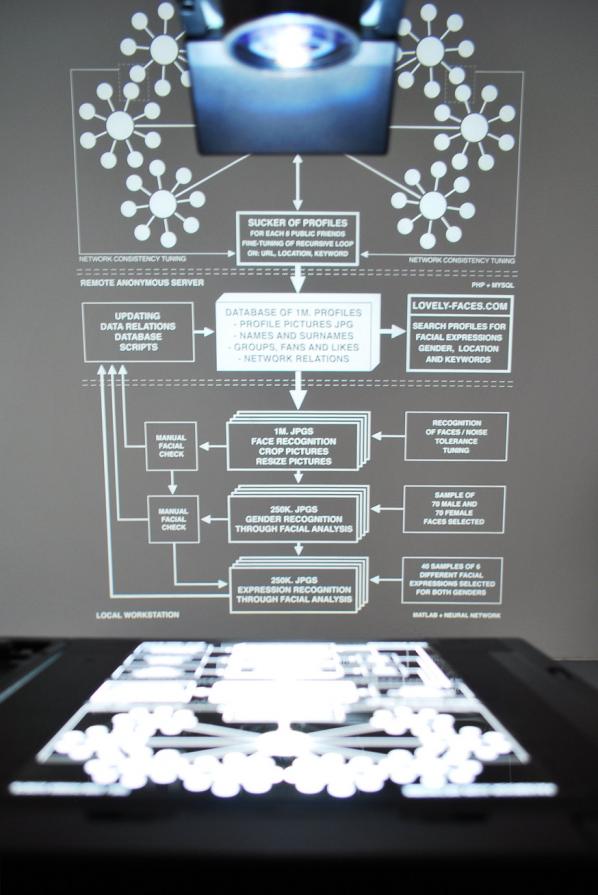
This project, and the ripples it left on the media water, highlights an ambiguous relationship many have with facebook. Many people sign up, upload a smiling profile picture of themselves and declare personal details to the large corporation that is Facebook without concern. Not until these identities and personal images were scavenged and then reused, the ownership and potential audience of this personal data is questioned. As the artists state themselves: “The final step is to be aware that almost everything posted online can have a different life if simply recontextualized. “
“The process is always illustrated in a diagram that shows the main directions and processes under which the software has been developed. We found a significant conceptual hole in all of these corporate systems and we used it to expose the fragility of their omnipotent commercial and marketing strategies. In fact all these corporations established a monopoly in their respective sectors (Google, search engine; Amazon, book selling; Facebook, social media), but despite that their self-protective strategies are not infallible. And we have been successful in demonstrating this.”
Web 2.0 Suicide machine (http://suicidemachine.org/) is another project which deals with your online identity. It allows you to automatically delete all your social network profiles and it simplifies the process – according to their website 8.5h quick then a manual deletion. Incidentially, the facebook is not one of the profiles subject to deletion in the suicide machine anymore, following another cease and decease letter: http://suicidemachine.org/download/Web_2.0_Suicide_Machine.pdf.
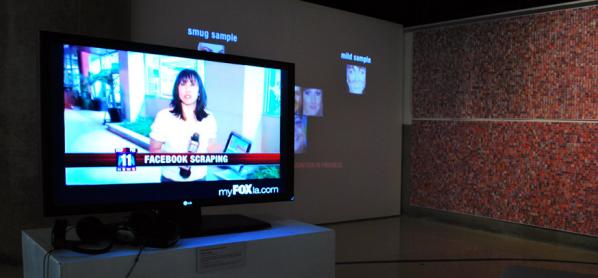
Since the lovely-faces.com dating website is still closed down, the project now (September 2011) consists of: documentation of the process used to acquire the facebook profiles; documentation of the global mass media hack performance, in the form of news broadcasts, magazine articles and blog post referring to the project; legal correspondence between the lawyers of the artists and Facebook; a mixed media installation; a touring lecture given by the authors. The latter two being re-performed and installed in various venues around Europe and beyond. The former are all available on the website face-to-facebook.net
The ever changing nature of this project therefore makes it a great example of a piece of contemporary art of variable nature, one which is in constant flux and is formed by the cultural, networked and physical landscape surrounding it. It does not only challenge the ownership of your online identity, it is also a nuisance for a mainstream contemporary art market based on institutional preservation and commercial commodification. These disruptions may also be linked. On the one hand there is an action to copy a system collecting and commodfying people and then use them as assets in one’s art expression and experience. “In all the three projects, the theft is not used to generate money at all, or for personal economic advantage, but only to twist the stolen data or knowledge against the respective corporations.” And then on the other hand, it is an art project which is not straightforward to see what the remaining artefacts actually are, whilst defying the process of being added to traditional art collections.
Other Info:
The Hacking Monopolism Trilogy. Face to Facebook is the third work in a series that began with Google Will Eat Itself and Amazon Noir. http://www.face-to-facebook.net/hacking-monopolism-trilogy.php
Elin Ahlberg is studying Art and Visual culture at the University of the West of England in Bristol. She has been living in the UK, and Bristol, since her move from Sweden in 2006. As an artist, she works in a variety of mediums and produces work which aims to both amuse and provoke. Her practice and research is informed by quasi-anthropological observations and an interest in technology. “One year ago I gave up Facebook for lent. It was quite an interesting experiment and I realised how integrated my life was with the social networking website as I actually felt that I missed out on things.” Ahlberg’s essay Meanings constructed around Facebook can be found here http://elinahlberg.wordpress.com/2011/07/18/essay-meanings-constructed-around-facebook-2011/
“You Are Now the Electronic Man” are the words that appear before even opening the website for The Electronic Man, a project initiated by Salvatore Iaconesi and Oriana Persico of Art is Open Source (AOS) and FakePress. And by becoming part of The Electronic Man, sharing your emotions as they become linked through QR Codes and help to build the frame of The Electronic Man, you are participating in a real time global performance.
This real time global performance relates to conceptual experiments by AOS and FakePress, in remixing reality and creating new sensual experiences with technology. The email interview took place after their recent exhibition at Furtherfield’s gallery in London, called REFF – REMIX THE WORLD! REINVENT REALITY!, which happened during February, March 2011, and during their current project The Electronic Man. We discuss AOS’s ideas and intentions, regarding their activities of performance and use of technology, and their methods of engagement with anthropology and biology.
Renee : The Electronic Man is quite an ambitious project. What inspired you to begin building the Electronic Man?
Salvator and Oriana: The Electronic Man is actually a very simple project (if quite a difficult one in terms of “making it happen”) as it is a direct poetic interpretation of a theory by Marshall McLuhan that goes by the same name. We decided to take the famous statement by Marshall McLuhan quite literally and transform it into something that is really happening in the world: “Electronic man like pre-literate man, ablates or outers the whole man. His information environment is his own central nervous system.”
What we wanted to do was to make our statement for the centennial of McLuhan’s birth, but to avoid the form of the “conference presentation” for it, and to show in a powerful way how the ideas expressed by McLuhan are really taking place in the world which we experience every day. So we decided to produce a performance, a global performance.
With the wonderful support of Derrick de Kerckhove, and of the MediaDuemila magazine (and the Associazione Amici di Media Duemila and the Osservatorio Tuttimedia, and the Department of Communication and Social Research of Rome’s University “La Sapienza”, who were organizing the official event for the centennial in Rome, under the fundamental guidance of Maria Pia Rossignaud) we were able to make it happen and everyone involved was really happy to include this experience in the official celebrations.
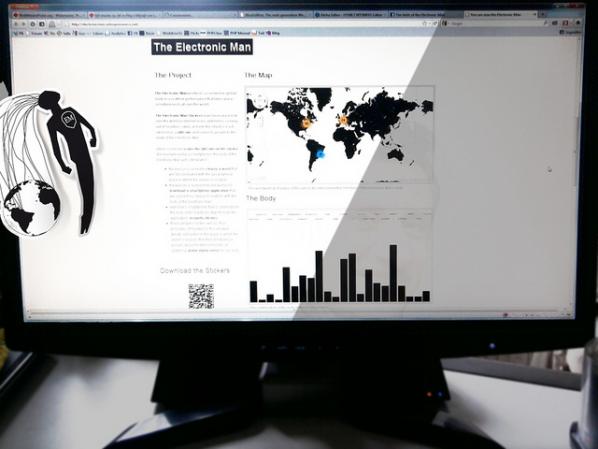
Renee Carmichael: I find the methodology behind this project really interesting. From what I understand it’s about going beyond the analogue vs. digital debate and really going in between and just experiencing and experimenting. Do you think this methodology is important to use in today’s world? How and why might this be so?
Salvatore and Oriana: We are living in a really complex scenario, complex, fast and ever changing. Digital technologies and networks are starting to pervade our analogue reality, transforming it and opening up entirely new possibilities. There are forms of (digital) interaction that are starting to be widely accessible from physical space. These forms of interaction are really peculiar as they allow for a transformation of (physical) reality, making it interactive, reinventing it, remixing it, and adding content to it. The world itself becomes a performance and a very specific form of performance: involving remixes, mashups, recontextualizations and reenactments as its main practices. This has drastic effects, not only as our reality multiplies and reshapes, but also attitudes, perceptions, skills, knowledge and approaches of the people involved change. In this process methodologies, practices and theories remix as well, bringing forth various possible scenarios, in which collaboration practices emerge as the only viable way to perform significant actions.

So, in this scenario, “life, the world and everything” is turning into a multipliable, performative environment in which the only way to, actually, perform in a significant way is to collaborate across cultures, skills, theories and methodologies. This brings forth a change to our sensorial environment, meaning that when ubiquitous technologies are involved, we instantly gain new senses, new sensorialities and sensibilities. Just like with the mobile phone, when it doesn’t catch the network, we move, naturally and without thinking about it, to a place that has better network coverage, in a way that is neurologically similar to the way in which we move our hand away from fire when we feel the heat: it is a real sensibility, an additional sense.
Mixing these two aspects (the forming of a multilayered, collaborative, read-write reality, and the emergence of these new senses), describes a situation that is almost exactly the one presented in the question: experimentation, as in performance and as in science, this new science that traverses disciplines, theories and approaches; and experience, meaning you are actually able to build a new experience of the world that is sensorial and, most important of all, writable.
This is also a good description of the shape that the term “conflict” is assuming: a continuous process of movement and traversal, in which you transform a part of reality (as in augmented reality) adding new meaning and imaginaries to it, in a performative action that unites activism, art, science, design and communication, and that transforms and is transformed really fast, at the pace of the evolution of technologies and networks.
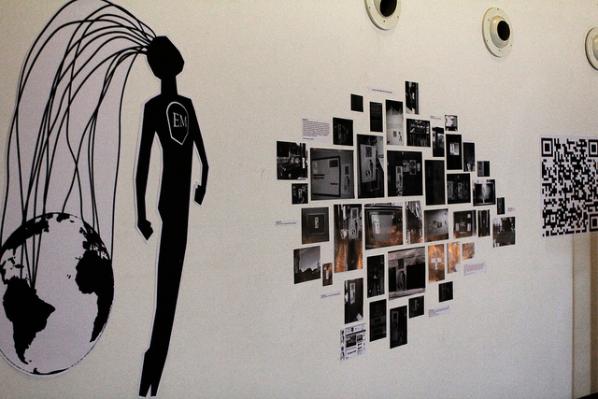
Renee: I read that this project can help us experience and reflect on our place in the world through the external. Do you think the relationship between the individual and the external takes a new shape throughout this project? How might it be understood in the larger ideas and theories of the Electronic Man?
Salvatore and Oriana: The Electronic Man is about the observation and exemplification of something that is already happening in the world. It speaks about interconnection and our renewed perception of space, time, body and relationships. Technologies helped us reshape these concepts completely. We are never in a single place now; we are everywhere, anytime and with lots of people all at the same time, using multiple identities, both voluntarily (mobile phones, ubiquitous networks..) and involuntarily (CCTV, social networks spying on us..). So all these definitions change radically: private and public space, gender, relationship, message, privacy, work and free time. We wanted to make this change explicit. In this change: public and private completely restructure! This is also why we decided to use the “emotional” dimension as a narrative: emotions are thought to be a private, intimate part of our lives, but now they are the object of public observation through what we do in the digital realms, for the new forms of economies that are developing, focusing on attention, reputation, awareness and more.
Renee: Although the Electronic Man allows us to experience sensually, it still creates finite points of data through the connections between a place and an emotion. What do you think is the relationship between the sensual impact of the project and the data it produces? How does the data fit into the idea of creating a new ‘global digital sense of our bodies’?
Salvatore and Oriana: This is a very complicated question! We chose this approach as a starting point. We are using a classification of emotions which is very basic (designed by Plutchik in 1980) it works really well across different languages (we are currently using 29 languages for our performances, to address as much of the world as possible). But this point that is described in the question (freeing the modalities of data, augmenting the degrees of freedom which we can express) is one of the focal points for expansion in the next steps. There are solutions and approaches which we are finding suitable to confront these issues with, and they are all related to adding degrees of freedom in what you “release to the public”: transforming artworks into free frameworks for expression that can be freely used by people. This transformation from artwork to framework is something that is happening all over, and it has to do with P2P culture and free software. This is why we release all the software and hardware (and methodologies) we use in our performances under free licenses: because the next step of each performance is made by the people taking the tools in their own hands and creating their own forms of expression and action, their own additional layers of the world.
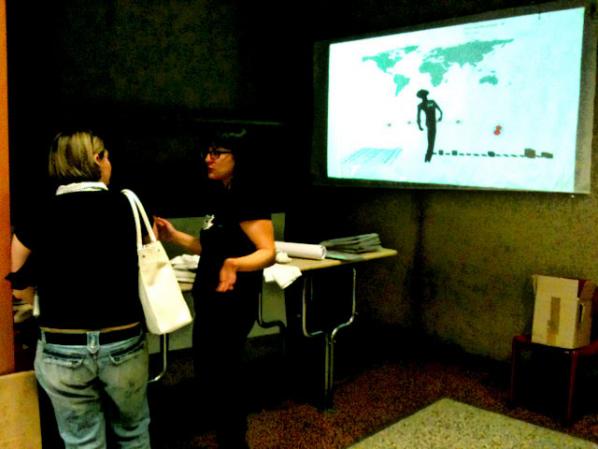
Renee: In a related note, this new form of being that the Electronic Man creates cannot be completely separated from the world and systems it exists in already. It seems that the questions that often arise around this project are in terms of how it can be used within other appropriations. How do you see the future of this project in terms of the various appropriations that it may have and in terms of your own intentions for the project?
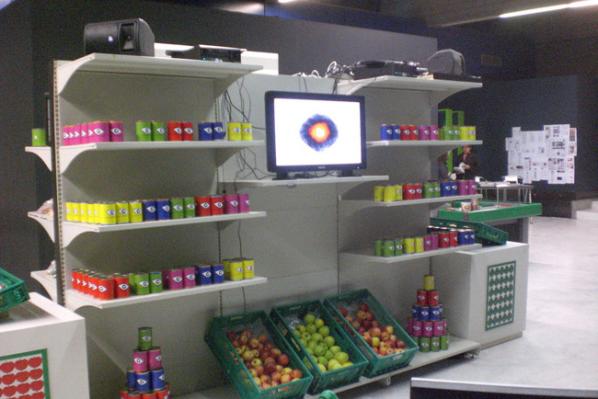
Salvatore and Oriana: As we said: we’re always in beta version. These processes are nomadic, temporary, and unstable. Ideas, software tools, concepts, hardware, practices and approaches are in a continuous state of remix: each time we speak to anyone, or even as we’re writing this, the performance changes and upgrades to the next version. For example we can look at the recent augmented reality interventions that have been taking place all over the world and, just a few days ago at the Venice Biennale: there has been a very fertile discussion building up during the last two years, on the idea that these technologies allow you to “squat” reality, and add new meanings and new degrees of freedom to it. This is why we created a project called Squatting Supermarkets a couple of years ago. This discussion is producing actions: appropriations, performances, re-usage of terms, words, sentences, new forms of activism, and new forms of art. We’re really happy that this is taking place, and we see all this as a wider form of performance in which everyone interested can be involved.
Renee: I can’t help but see a relationship between The Electronic Man and a sort of modern day Frankenstein. Would you like to comment on this relationship?
Salvatore and Oriana: We will answer this question using an answer that our dear friend prof. Massimo Canevacci gave to a question during a TV show in Italy: “This is a wonderful question, and I am deeply convinced that western cultures produced these really heavy mythologies around Frankenstein, the Golem, and arriving to a movie, a very nice one, like Blade Runner, taken from a novel by Philip Dick.
I am certain that this system, this dualism between technology and body, between organic and inorganic, between nature and culture, is finally over, in a liberating way. There are researches in which the concept of cyborg constitutes a perspective that is capable of liberating enormous possibilities. Therefore our bodies become progressively more entangled with technology all over literature, technology, anthropology, and biology.
Thus I sincerely hope that this enormous mythology, this terrifying myth of the Frankenstein, will finally end, once and for all, and will peacefully retire; and that new forms of cyborg will emerge and free themselves, to produce new free forms of expression.
Renee: Finally, any further issues, ideas, thoughts you would like to add?
Salvatore and Oriana: Yes!
The Electronic Man is a global performance! And it becomes useful if lots of people participate (and, by the way, participate by doing even simple things such as attaching some of the Electronic Man stickers around and sending us a picture, and you’ll find yourself and your work advertised whenever we exhibit the work: for example at the MACRO museum in Rome there is a full wall dedicated to the people that are helping us out, including their bios, pictures and links) But, most of all, it becomes useful if lots of people actively grab technologies, methodologies and concepts and actively build their own performative world, possibly sharing the results with everyone else.
So we strongly invite everyone out there to request the software, (it will be published on our sites as soon as we have some time to prepare a proper sharing mechanism, but you all can have it before that by simply asking) and to imagine other disruptive ways of using technologies to create free, accessible, inclusive spaces for communication and expression.
We will support you all in that as much as we can.
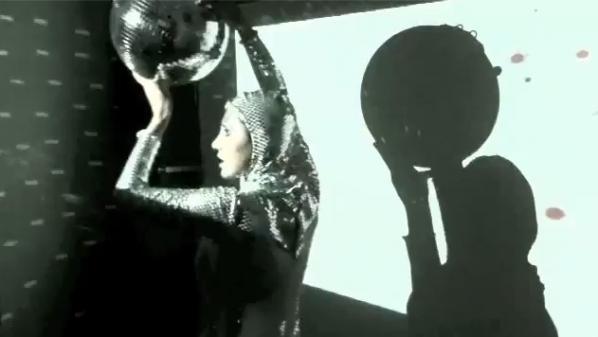
The Electronic Man at ADD Festival, MACRO Testaccio, Rome contemporary art museum, view video on Youtube.
“At the dawn of the new millennium, Net users are developing a much more efficient and enjoyable way of working together: cyber-communism.” Richard Barbrook.
Dmytri Kleiner, author of The Telekommunist Manifesto, is a software developer who has been working on projects “that investigate the political economy of the Internet, and the ideal of workers’ self-organization of production as a form of class struggle.” Born in the USSR, Dmytri grew up in Toronto and now lives in Berlin. He is a founder of the Telekommunisten Collective, which provides Internet and telephone services, as well as undertakes artistic projects that explore the way communication technologies have social relations embedded within them, such as deadSwap (2009) and Thimbl (2010).
“Furtherfield recently received a hard copy of The Telekommunist Manifesto in the post. After reading the manifesto, it was obvious that it was pushing the debate further regarding networked, commons-based and collaborative endeavours. It is a call to action, challenging our social behaviours and how we work with property and the means of its production. Proposing alternative routes beyond the creative commons, and top-down forms of capitalism (networked and physical), with a Copyfarleft attitude and the Telekommunist’s own collective form of Venture Communism. Many digital art collectives are trying to find ways to maintain their ethical intentions in a world where so many are easily diverted by the powers that be, perhaps this conversation will offer some glimpse of how we can proceed with some sense of shared honour, in the maelstrom we call life…”
Marc Garrett: Why did you decide to create a hard copy of the Manifesto, and have it republished and distributed through the Institute of Networked Cultures, based in Amsterdam?
Dmytri Kleiner: Geert Lovink contacted me and offered to publish it, I accepted the offer. I find it quite convenient to read longer texts as physical copies.
MG: Who is the Manifesto written for?
DK: I consider my peers to be politically minded hackers and artists, especially artists whose work is engaged with technology and network cultures. Much of the themes and ideas in the Manifesto are derived from ongoing conversations in this community, and the Manifesto is a contribution to this dialogue.
MG: Since the Internet we have witnessed the rise of various networked communities who have explored individual and shared expressions. Many are linked, in opposition to the controlling mass systems put in place by corporations such as Facebook and MySpace. It is obvious that your shared venture critiques the hegemonies influencing our behaviours through the networked construct, via neoliberal appropriation, and its ever expansive surveillance strategies. In the Manifesto you say “In order to change society we must actively expand the scope of our commons, so that our independent communities of peers can be materially sustained and can resist the encroachments of capitalism.” What kind of alternatives do you see as ‘materially sustainable’?
DK: Currently none. Precisely because we only have immaterial wealth in common, and therefore the surplus value created as a result of the new platforms and relationships will always be captured by those who own scarce resources, either because they are physically scarce, or because they have been made scarce by laws such as those protecting patents and trademarks. To become sustainable, networked communities must possess a commons that includes the assets required for the material upkeep of themselves and their networks. Thus we must expand the scope of the commons to include such assets.
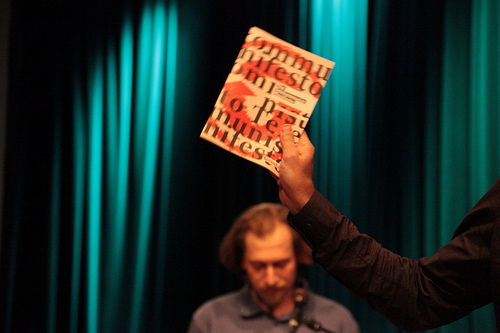
MG: The Manifesto re-opens the debate around the importance of class, and says “The condition of the working class in society is largely one of powerlessness and poverty; the condition of the working class on the Internet is no different.” Could you offer some examples of who this working class is using the Internet?
DK: I have a very classic notion of working class: Anyone whose livelihood depends on their continuing to work. Class is a relationship. Workers are a class who lack the independent means of production required for their own subsistence, and thus require wage, patronage or charity to survive.
MG: For personal and social reasons, I wish for the working class not to be simply presumed as marginalised or economically disadvantaged, but also engaged in situations of empowerment individually and collectively.
DK: Sure, the working class is a broad range of people. What they hold in common is a lack of significant ownership of productive assets. As a class, they are not able to accumulate surplus value. As you can see, there is little novelty in my notion of class.
MG: Engels reminded scholars of Marx after his death that, “All history must be studied afresh”[1]. Which working class individuals or groups do you see out there escaping from such classifications, in contemporary and networked culture?
DK: Individuals can always rise above their class. Many a dotCom founder have cashed-in with a multi-million-dollar “exit,” as have propertyless individuals in other fields. Broad class mobility has only gotten less likely. If you where born poor today you are less likely than ever to avoid dying poor, or avoid leaving your own children in poverty. That is the global condition.
I do not believe that class conditions can be escaped unless class is abolished. Even though it is possible to convince people that class conditions do not apply anymore by means of equivocation, and this is a common tactic of right wing political groups to degrade class consciousness. However, class conditions are a relationship. The power of classes varies over time, under differing historical conditions.
The condition of a class is the balance of its struggle against other classes. This balance is determined by its capacity for struggle. The commons is a component of our capacity, especially when it replaces assets we would otherwise have to pay Capitalist-owners for. If we can shift production from propriety productive assets to commons-based ones, we will also shift the balance of power among the classes, and thus will not escape, but rather change, our class conditions. But this shift is proportional to the economic value of the assets, thus this shift requires expanding the commons to include assets that have economic value, in other words, scarce assets that can capture rent.
MG: The Telekommunist Manifesto, proposes ‘Venture Communism’ as a new working model for peer production, saying that it “provides a structure for independent producers to share a common stock of productive assets, allowing forms of production formerly associated exclusively with the creation of immaterial value, such as free software, to be extended to the material sphere.” Apart from the obvious language of appropriation, from ‘Venture Capitalism’ to ‘Venture Communism’. How did this idea come about?
DK: The appropriation of the term is where it started.
The idea came about from the realization that everything we were doing in the free culture, free software & free networks communities was sustainable only when it served the interests of Capital, and thus didn’t have the emancipatory potential that myself and others saw in it. Capitalist financing meant that only capital could remain free, so free software was growing, but free culture was subject to a war on sharing and reuse, and free networks gave way to centralized platforms, censorship and surveillance. When I realized that this was due to the logic of profit capture, and precondition of Capital, I realized that an alternative was needed, a means of financing compatible with the emancipatory ideals that free communication held to me, a way of building communicative
infrastructure that was born and could remain free. I called this idea Venture Communism and set out to try to understand how it might work.
MG: An effective vehicle for the revolutionary workers’ struggle. There is also the proposition of a ‘Venture Commune’, as a firm. How would this work?
DK: The venture commune would work like a venture capital fund, financing commons-based ventures. The role of the commune is to allocate scarce property just like a network distributes immaterial property. It acquires funds by issuing securitized debt, like bonds, and acquires productive assets, making them available for rent to the enterprises it owns. The workers of the enterprises are themselves owners of the commune, and the collected rent is split evenly among them, this is in addition to whatever remuneration they receive for work with the enterprises.
This is just a sketch, and I don’t claim that the Venture Communist model is finished, or that even the ideas that I have about it now are final, it is an ongoing project and to the degree that it has any future, it will certainly evolve as it encounters reality, not to mention other people’s ideas and innovations.
The central point is that such a model is needed, the implementation details that I propose are… well, proposals.
MG: So, with the combination of free software, free code, Copyleft and Copyfarleft licenses, through peer production, does the collective or co-operative have ownership, like shares in a company?
DK: The model I currently support is that a commune owns many enterprises, each independent, so the commune would own 100% of the shares in each enterprise. The workers of the enterprises would themselves own the commune, so there would be shares in the commune, and each owner would have exactly one.
MG: In the Manifesto, there is a section titled ‘THE CREATIVE ANTI-COMMONS’, where the Creative Commons is discussed as an anti-commons, peddling a “capitalist logic of privatization under a deliberately misleading name.” To many, this is a controversy touching the very nature of many networked behaviours, whether they be liberal or radical minded. I am intrigued by the use of the word ‘privatization’. Many (including myself) assume it to mean a process whereby a non-profit organization is changed into a private venture, usually by governments, adding extra revenue to their own national budget through the dismantling of commonly used public services. Would you say that the Creative Commons, is acting in the same way but as an Internet based, networked corporation?
DK: As significant parts of the Manifesto is a remix of my previous texts, this phrase originally comes from the longer article “COPYRIGHT, COPYLEFT AND THE CREATIVE ANTI-COMMONS,” written by me and Joanne Richardson under the name “Ana Nimus”:
http://subsol.c3.hu/subsol_2/contributors0/nimustext.html
What we mean here is that the creative “commons” is privatized because the copyright is retained by the author, and only (in most cases) offered to the community under non-commercial terms. The original author has special rights while commons users have limited rights, specifically limited in such a way as to eliminate any possibility for them to make a living by employing this work. Thus these are not commons works, but rather private works. Only the original author has the right to employ the work commercially.
All previous conceptions of an intellectual or cultural commons, including anti-copyright and pre-copyright culture as well as the principles of free software movement where predicated on the concept of not allowing special rights for an original author, but rather insisting on the right for all to use and reuse in common. The non-commercial licenses represent a privatization of the idea of the commons and a reintroduction of the concept of a uniquely original artist with special private rights.
Further, as I consider all expressions to be extensions of previous perceptions, the “original” ideas that rights are being claimed on in this way are not original, but rather appropriated by the rights-claimed made by creative-commons licensers. More than just privatizing the concept and composition of the modern cultural commons, by asserting a unique author, the creative commons colonizes our common culture by asserting unique authorship over a growing body of works, actually expanding the scope of private culture rather than commons culture.
MG: So, this now brings us to Thimbl, a free, open source, distributed micro-blogging platform, which as you say is “similar to Twitter or identi.ca. However, Thimbl is a specialized web-based client for a User Information protocol called Finger. The Finger Protocol was orginally developed in the 1970s, and as such, is already supported by all existing server platforms.” Why create Thimbl? What kind of individuals and groups do you expect to use it, and how?
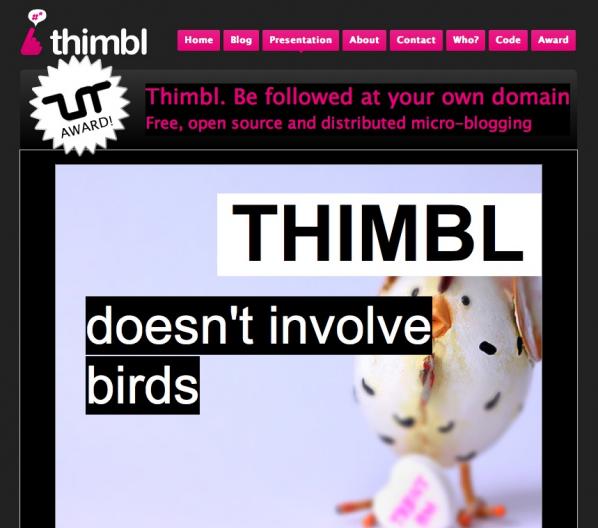
DK: First and foremost Thimbl is an artwork.
A central theme of Telekommunisten is that Capital will not fund free, distributed platforms, and instead funds centralized, privately owned platforms. Thimbl is in part a parody of supposedly innovative new technologies like twitter. By creating a twitter-like platform using Finger, Thimbl demonstrates that “status updates” where part of network culture back to the 1970s, and thus multimillion-dollar capital investment and massive central data centers are not required to enable such forms of communication, but rather are required to centrally control and profit from them.
MG: In a collaborative essay with Brian Wyrick, published on Mute Magazine ‘InfoEnclosure-2.0’, you both say “The mission of Web 2.0 is to destroy the P2P aspect of the Internet. To make you, your computer, and your Internet connection dependent on connecting to a centralised service that controls your ability to communicate. Web 2.0 is the ruin of free, peer-to-peer systems and the return of monolithic ‘online services’.”[2] Is Thimbl an example of the type of platform that will help to free-up things, in respect of domination by Web 2.0 corporations?
DK: Yes, Thimbl is not only a parody, it suggests a viable way forward, extending classic Internet platforms instead of engineering overly complex “full-stack” web applications. However, we also comment on why this road is not more commonly taken, because “The most significant challenge is not technical, it is political.” Our ability to sustain ourselves as developers requires us to serve our employers, who are more often than not funded by Capital and therefore are primarily interested in controlling user data and interaction, since delivering such control is a precondition of receiving capital in the first place.
If Thimbl is to become a viable platform, it will need to be adopted by a large community. Our small collective can only take the project so far. We are happy to advise any who are interested in how to join in. http://thimbl.tk is our own thimbl instance, it “knows” about most users I would imagine, since I personally follow all existing Thimbl users, as far as I know, thus you can see the state of the thimblsphere in the global timeline.
Even if the development of a platform like Thimbl is not terribly significant (with so much to accomplish so quickly), the value of a social platform is the of course derived from the size of it’s user base, thus organizations with more reach than Telekommunisten will need to adopt the platform and contribute to it for it to transcend being an artwork to being a platform.
Of course, as the website says “the idea of Thimbl is more important than Thimbl itself,” we would be equally happy if another free, open platform extending classic Internet protocols where to emerge, people have suggested employing smtp/nntp, xmmp or even http/WebDav instead of finger, and there are certain advantages and disadvantages to each approach. Our interest is the development of a free, open platform, however it works, and Thimbl is an artistic, technical and conceptual contribution to this undertaking.
MG: Another project is the Telekommunisten Facebook page, you have nearly 3000 fans on there. It highlights the complexity and contradictions many independents are faced with. It feels as though the Internet is now controlled by a series of main hubs; similar to a neighbourhood being dominated by massive superstores, whilst smaller independent shops and areas are pushed aside. With this in mind, how do you deal with these contradictions?
DK: I avoided using Facebook and similar for quite some time, sticking to email, usenet, and irc as I have since the 90s. When I co-authored InfoEnclosure 2.0, I was still not a user of these platforms. However it became more and more evident that not only where people adopting these platforms, but that they were developing a preference for receiving information on them, they would rather be contacted there than by way of email, for instance. Posting stuff of Facebook engaged them, while receiving email for many people has become a bother. The reasons for this are themselves interesting, and begin with the fact that millions where being spent by Capitalists to improve the usability of these platforms, while the classic Internet platforms were more or less left as they were in the 90s. Also, many people are using social media that never had been participants in the sorts of mailing lists, usenet groups, etc that I was accustomed to using to share information.
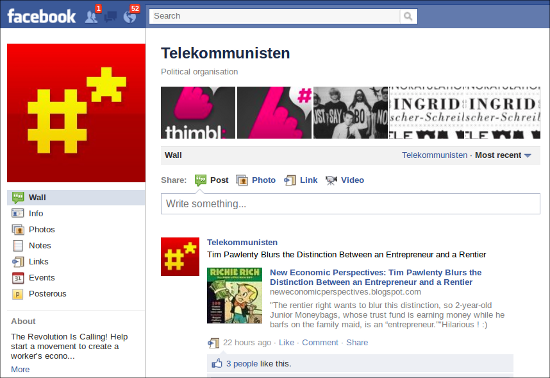
If I wanted to reach people and share information, I needed to do so on the technologies that others are using, which are not necessarily the ones I would prefer they use.
My criticism of Facebook and other sites is not they are not useful, it is rather that they are private, centralized, proprietary platforms. Also, simply abstaining from Facebook in the name of my own media purity is not something that I’m interested in, I don’t see capitalism as a consumer choice, I’m more interested in the condition of the masses, than my own consumer correctness. In the end it’s clear that criticizing platforms like Facebook today means using those platforms. Thus, I became a user and set up the Telekommunisten page. Unsurprisingly, it’s been quite successful for us, and reaches a lot more people than our other channels, such as our websites, mailing lists, etc. Hopefully it will also help us promote new decentralized channels as well, as they become viable.
MG: So, I downloaded deadSwap (http://deadSwap.net) which I intend to explore and use. On the site it says “The Internet is dead. In order to evade the flying monkeys of capitalist control, peer communication can only abandon the Internet for the dark alleys of covert operations. Peer-to-peer is now driven offline and can only survive in clandestine cells.” Could you explain the project? And are people using it as we speak?
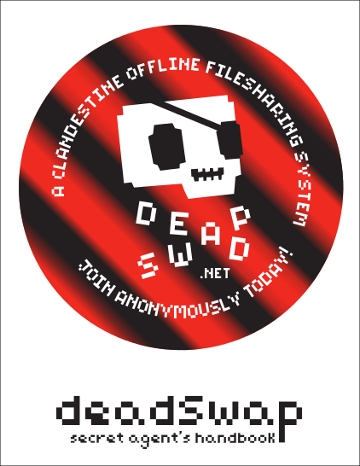
DK: I have no idea if people are using it, I am currently not running a network.
Like thimbl, deadSwap is an artwork. Unlike thimbl, which has the seeds of a viable platform within it, deadSwap is pure parody.
It was developed for the 2009 Sousveillance Conference, The Art of Inverse Surveillance, at Aarhus University. deadSwap is a distopian urban game where participants play secret agents sharing information on usb memory sticks by hiding them in secret locations or otherwise covertly exchanging them, communicating through an anonymizing SMS gateway. It is a parody of the “hacker elite” reaction to Internet enclosure, the promotion of the idea that new covert technologies will defeat attempts to censor the Internet, and we can simply outsmart and outmaneuver those who own and control our communications systems with clandestine technologies. This approach often rejects any class analysis out-of-hand, firmly believing in the power of us hackers to overcome state and corporate repressions. Though very simple in principal, deadSwap is actually very hard to use, as the handbook says “The success of the network depends on the competence and diligence of the participants” and “Becoming a super-spy isn’t easy.”
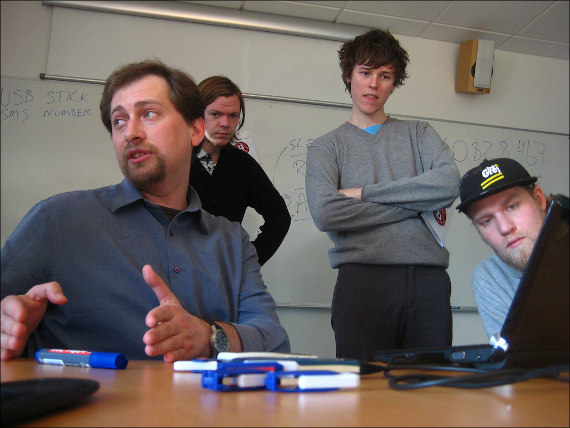
MG: What other services/platforms/projects does the Telekommunisten collective offer the explorative and imaginative, social hacker to join and collaborate with?
DK: We provide hosting services which are used by individuals and small organizations, especially by artists, http://trick.ca, electronic newsletter hosting (http://www.freshsent.info) and a long distance calling service (http://www.dialstation.com). We can often be found on IRC in#telnik in freenode. Thimbl will probably be a major focus for us, and anybody that wants to join the project is more than welcome, we have a community board to co-ordinate this which can be found here: http://www.thimbl.net/community.html
For those that want to follow my personal updates but don’t want don’t use any social media, most of my updates also go here: http://dmytri.info
Thank you for a fascintaing conversation Dmytri,
Thank you Marc 🙂
=============================<snip>
Top Quote: THE::CYBER.COM/MUNIST::MANIFESTO by Richard Barbrook. http://www.imaginaryfutures.net/2007/04/18/by-richard-barbrook/
The Foundation for P2P Alternatives proposes to be a meeting place for those who can broadly agree with the following propositions, which are also argued in the essay or book in progress, P2P and Human Evolution. http://blog.p2pfoundation.net
In the essay ‘Imagine there is no copyright and no cultural conglomerates too…” by Joost Smiers and Marieke van Schijndel, they say “Once a work has appeared or been played, then we should have the right to change it, in other words to respond, to remix, and not only so many years after the event that the copyright has expired. The democratic debate, including on the cutting edge of artistic forms of expression, should take place here and now and not once it has lost it relevance.”
Issue no. 4 Joost Smiers & Marieke van Schijndel, Imagine there are is no copyright and no cultural conglomorates too… Better for artists, diversity and the economy / an essay. colophon: Authors: Joost Smiers and Marieke van Schijndel, Translation from Dutch: Rosalind Buck, Design: Katja van Stiphout. Printer: ‘Print on Demand’. Publisher: Institute of Network Cultures, Amsterdam 2009. ISBN: 978-90-78146-09-4.
http://networkcultures.org/wpmu/theoryondemand/titles/no04-imagine-there-are-is-no-copyright-and-no-cultural-conglomorates-too/